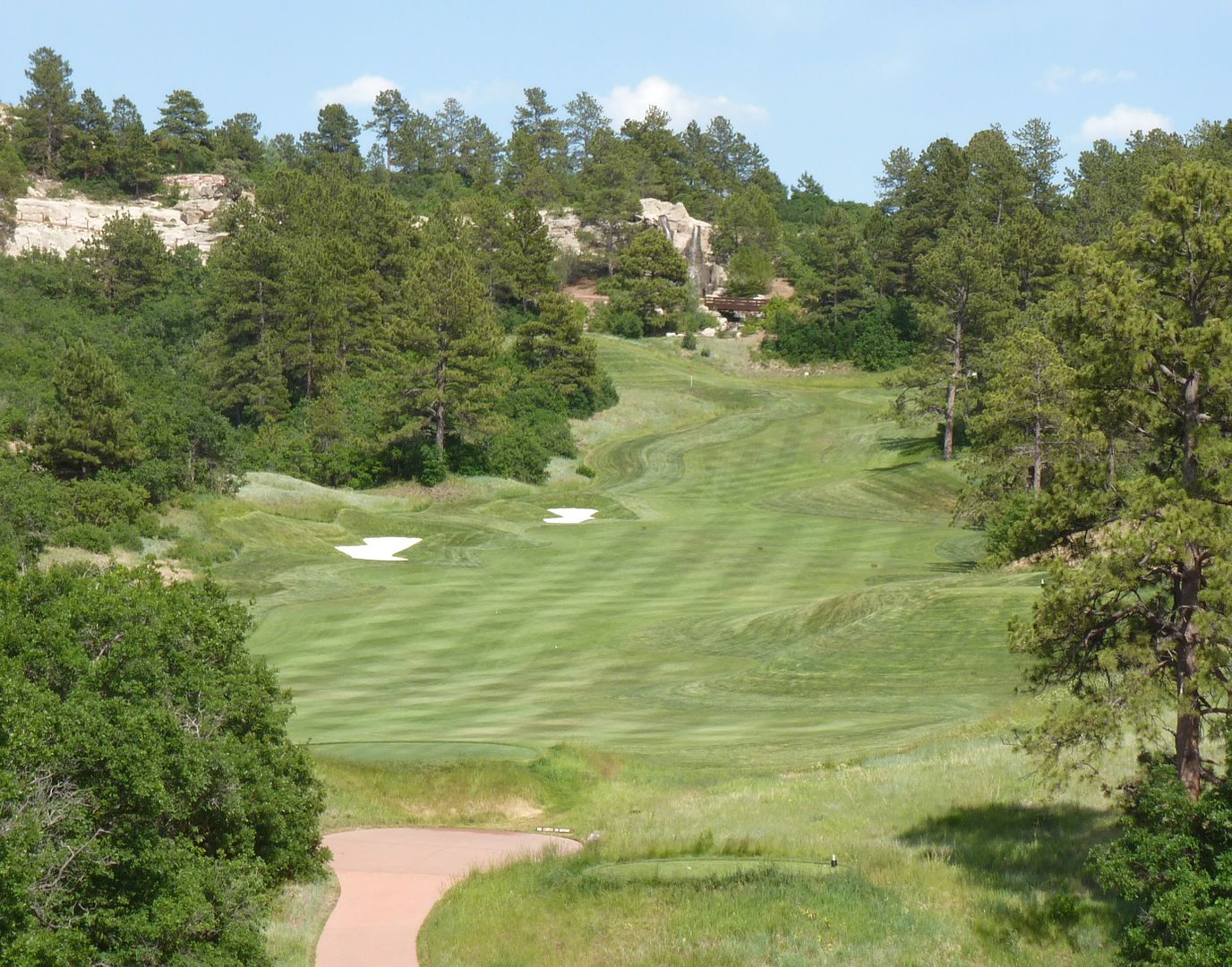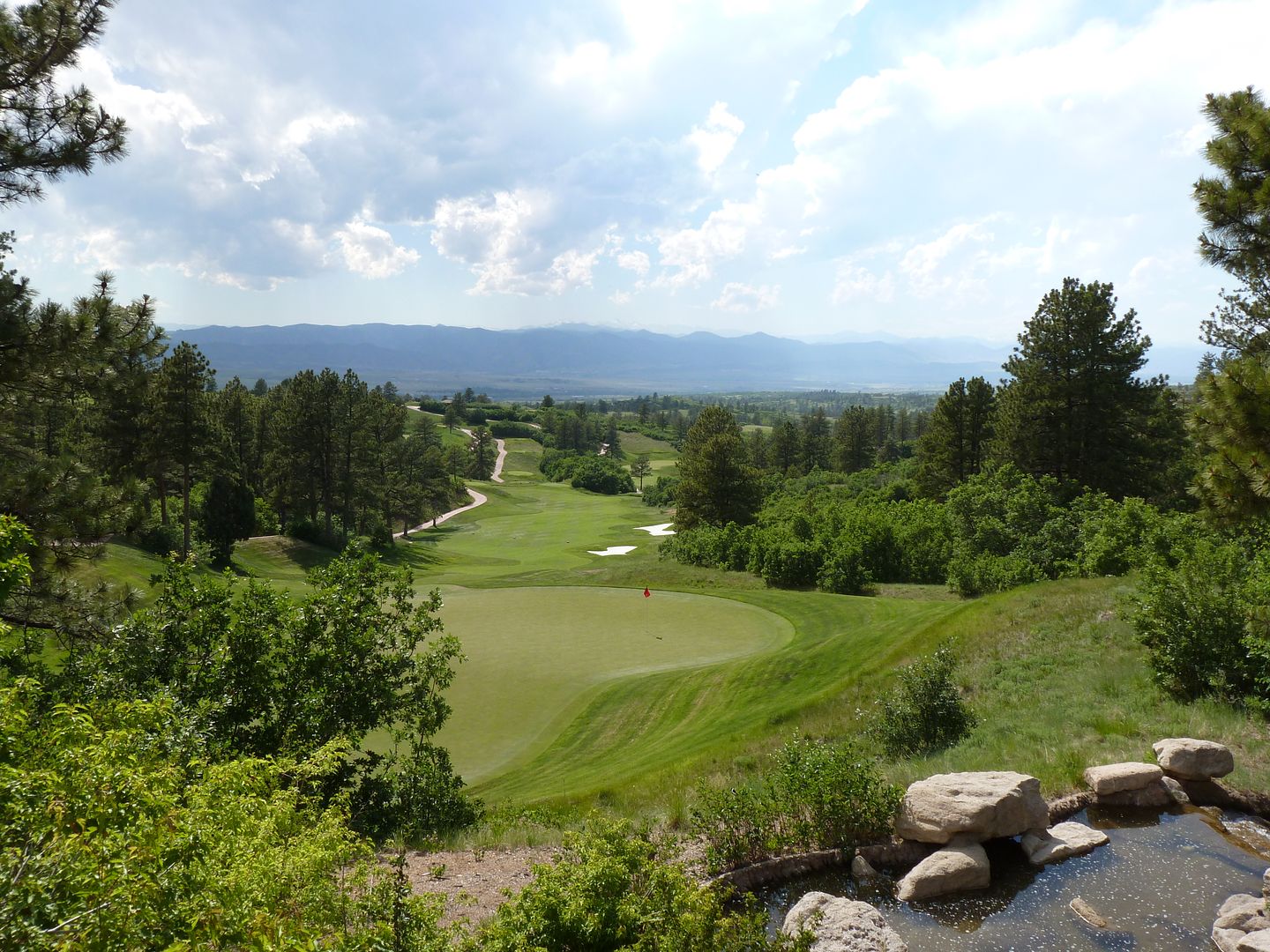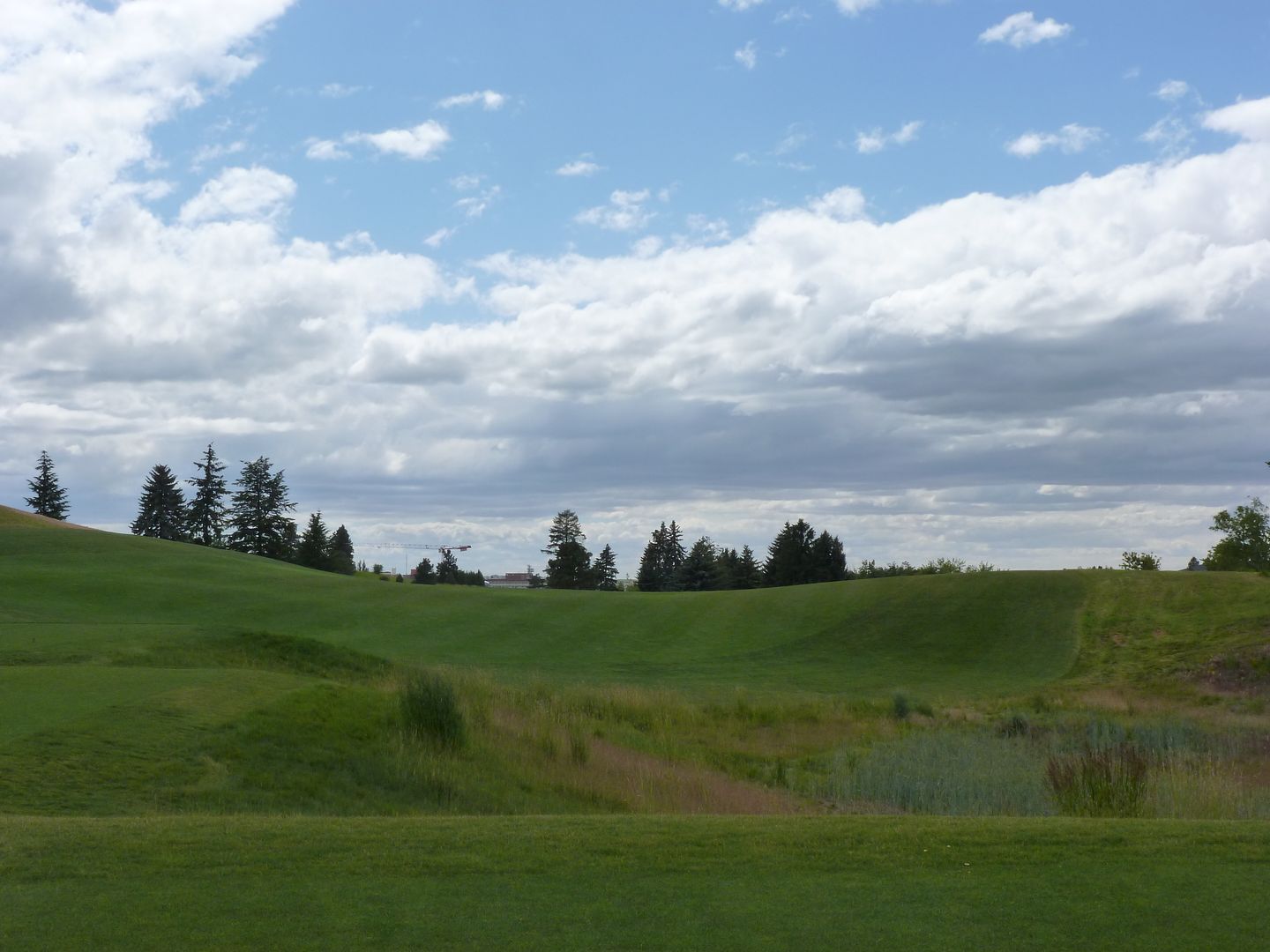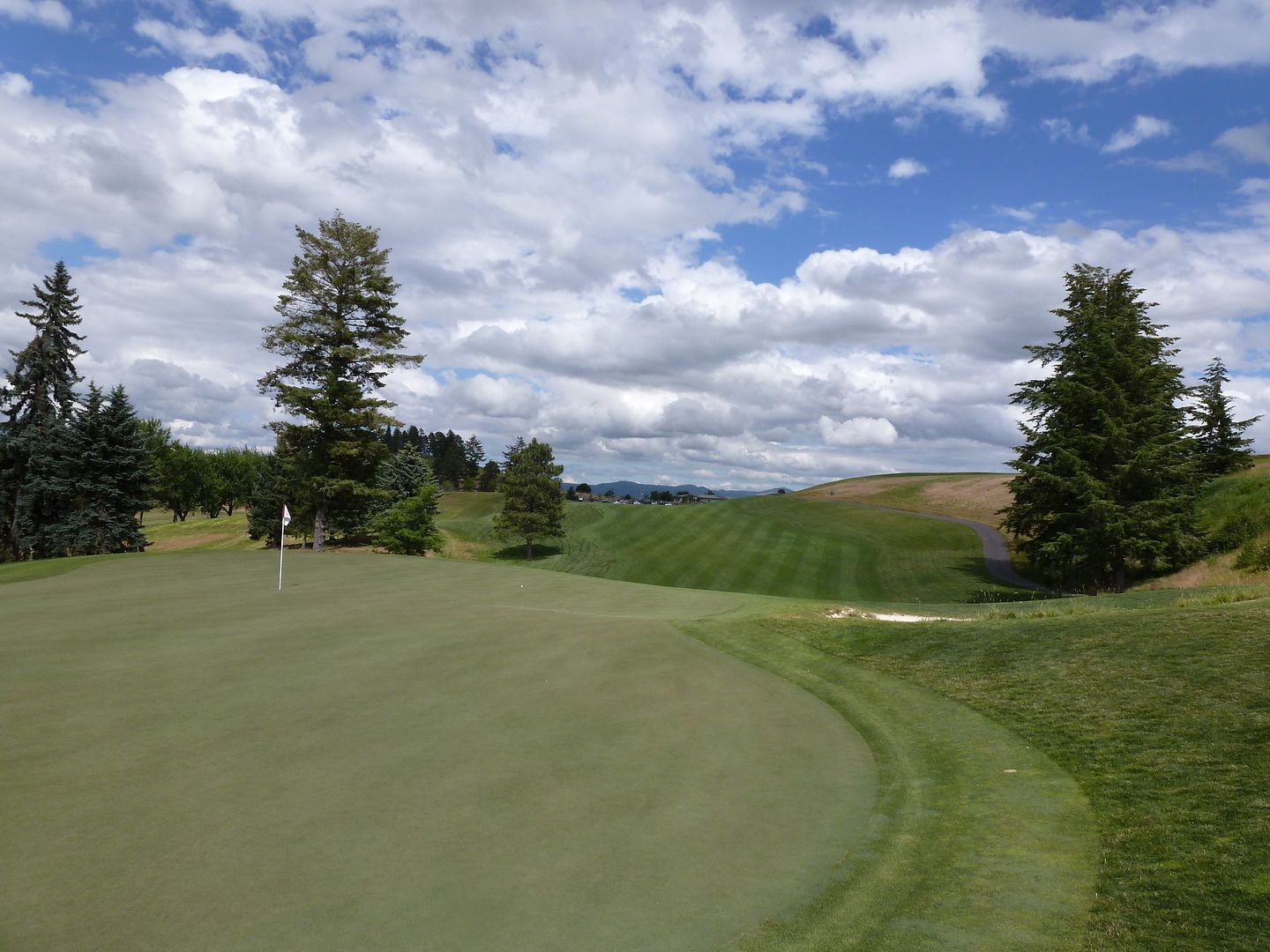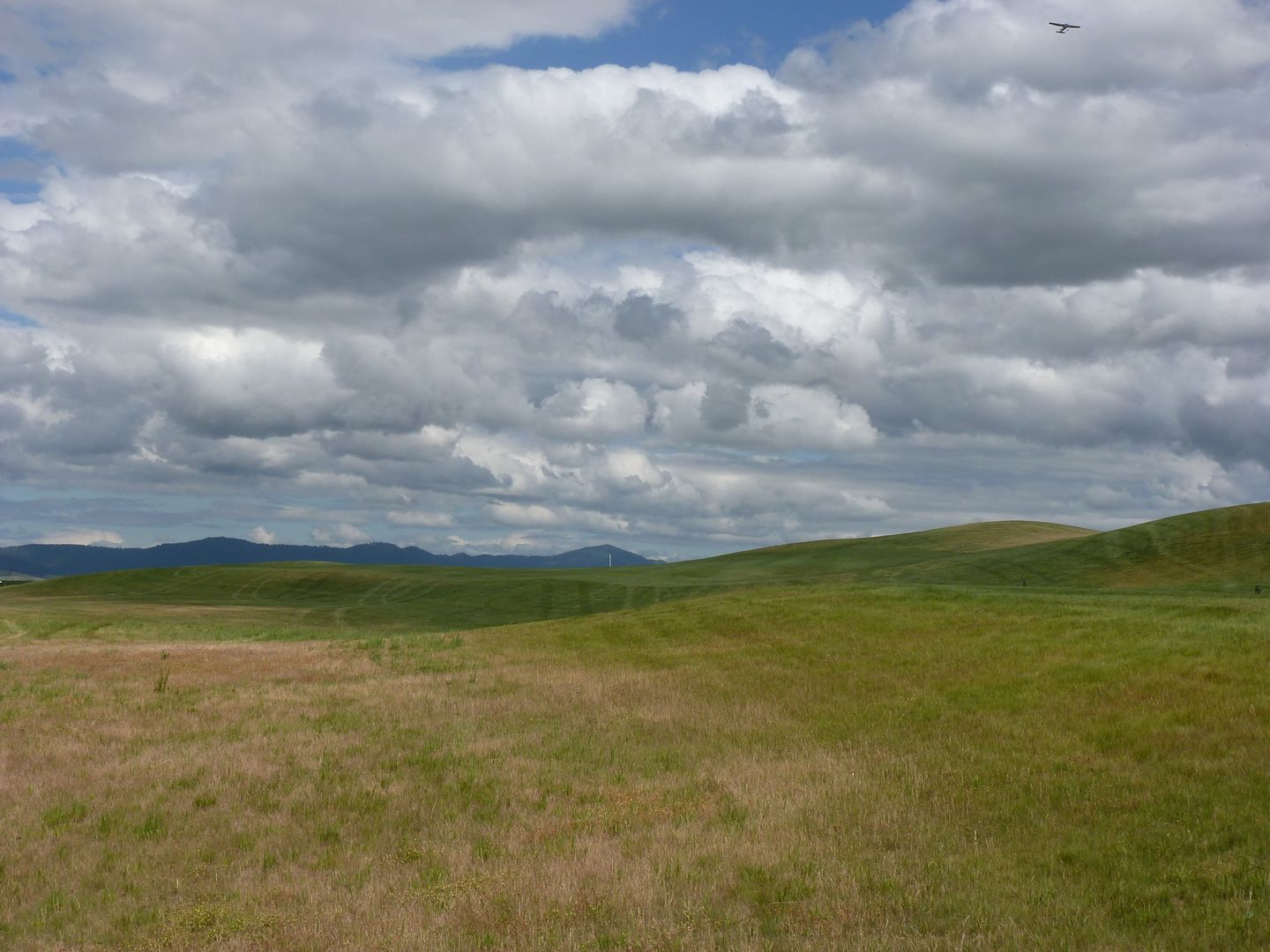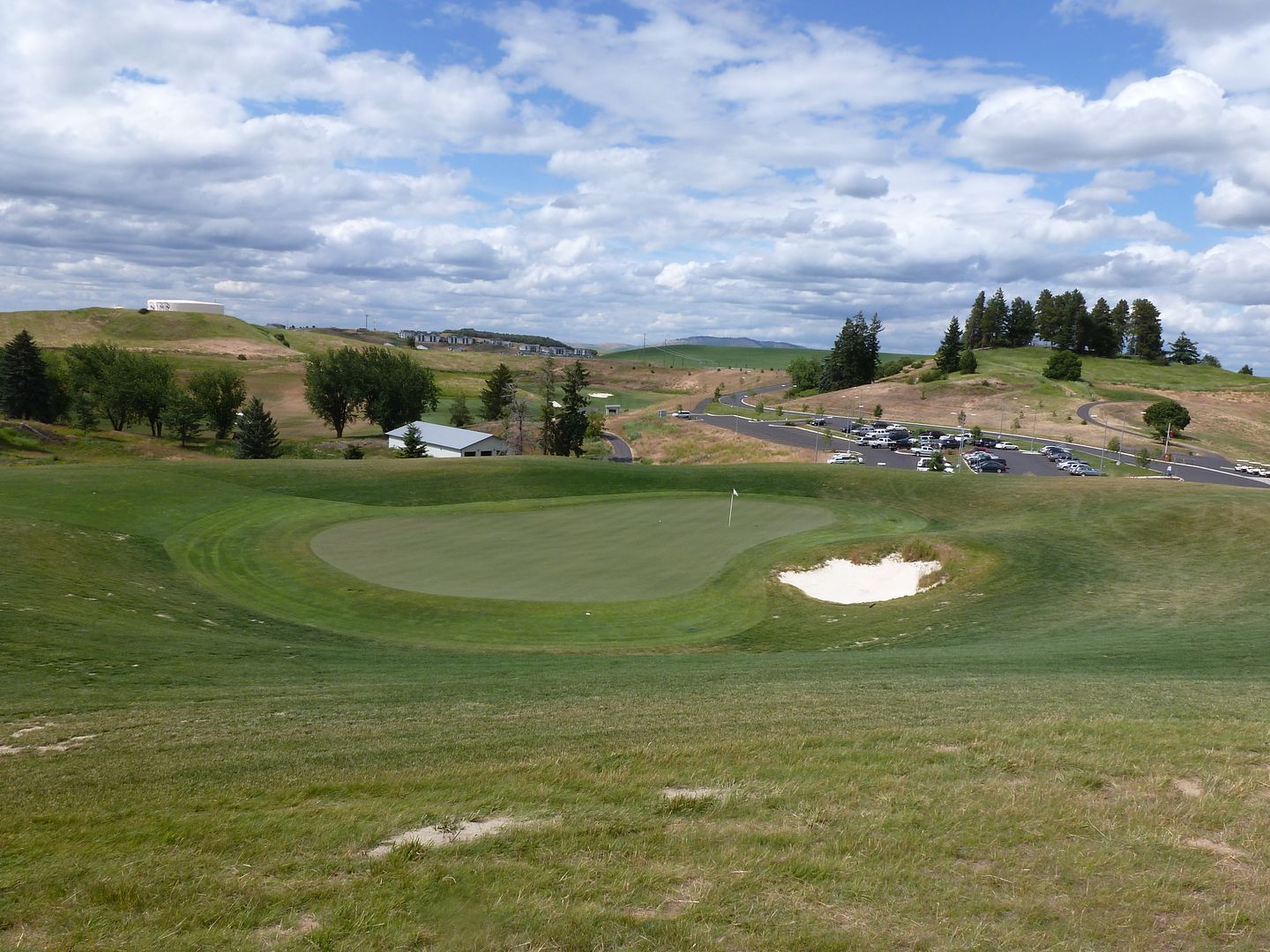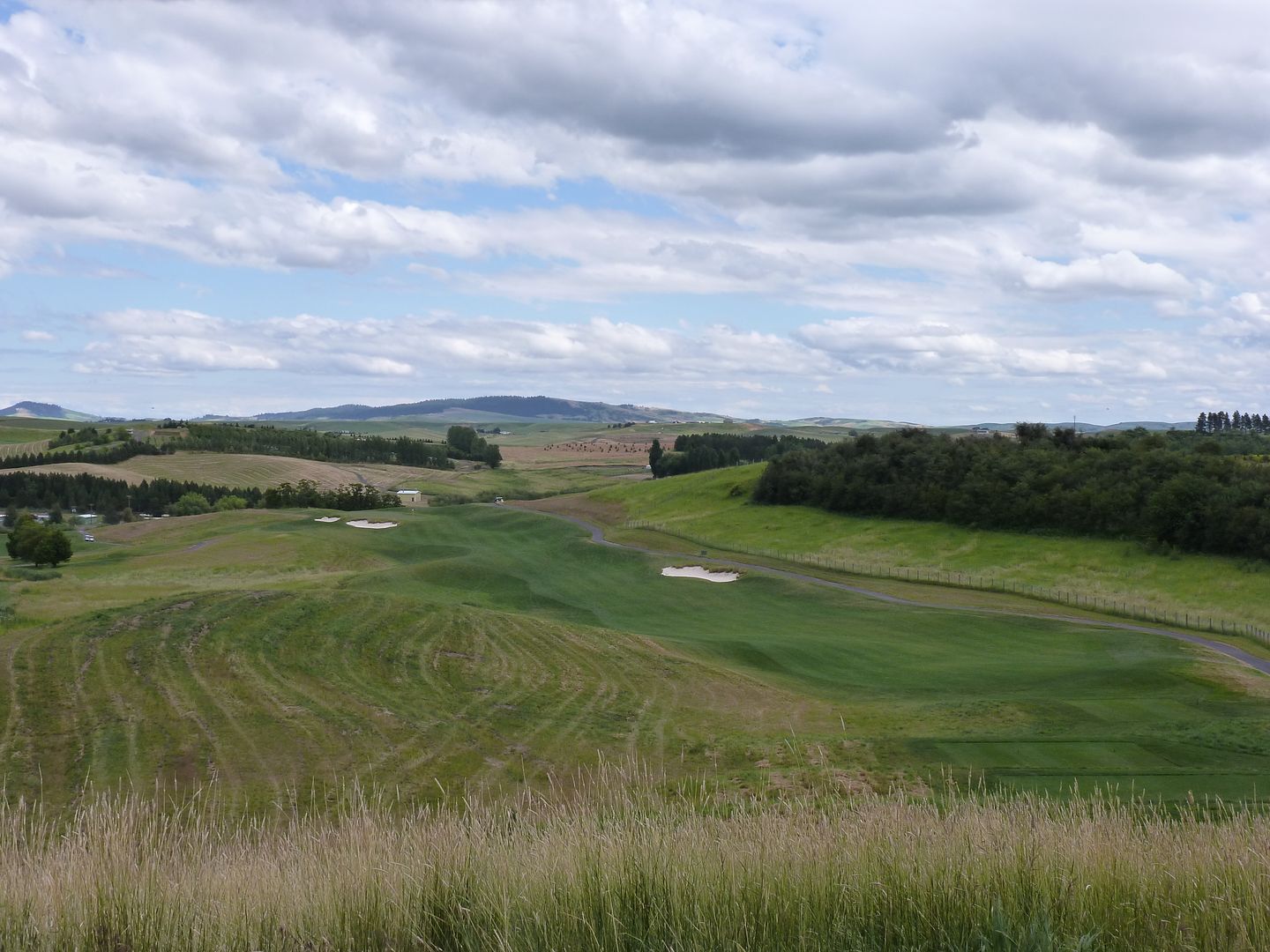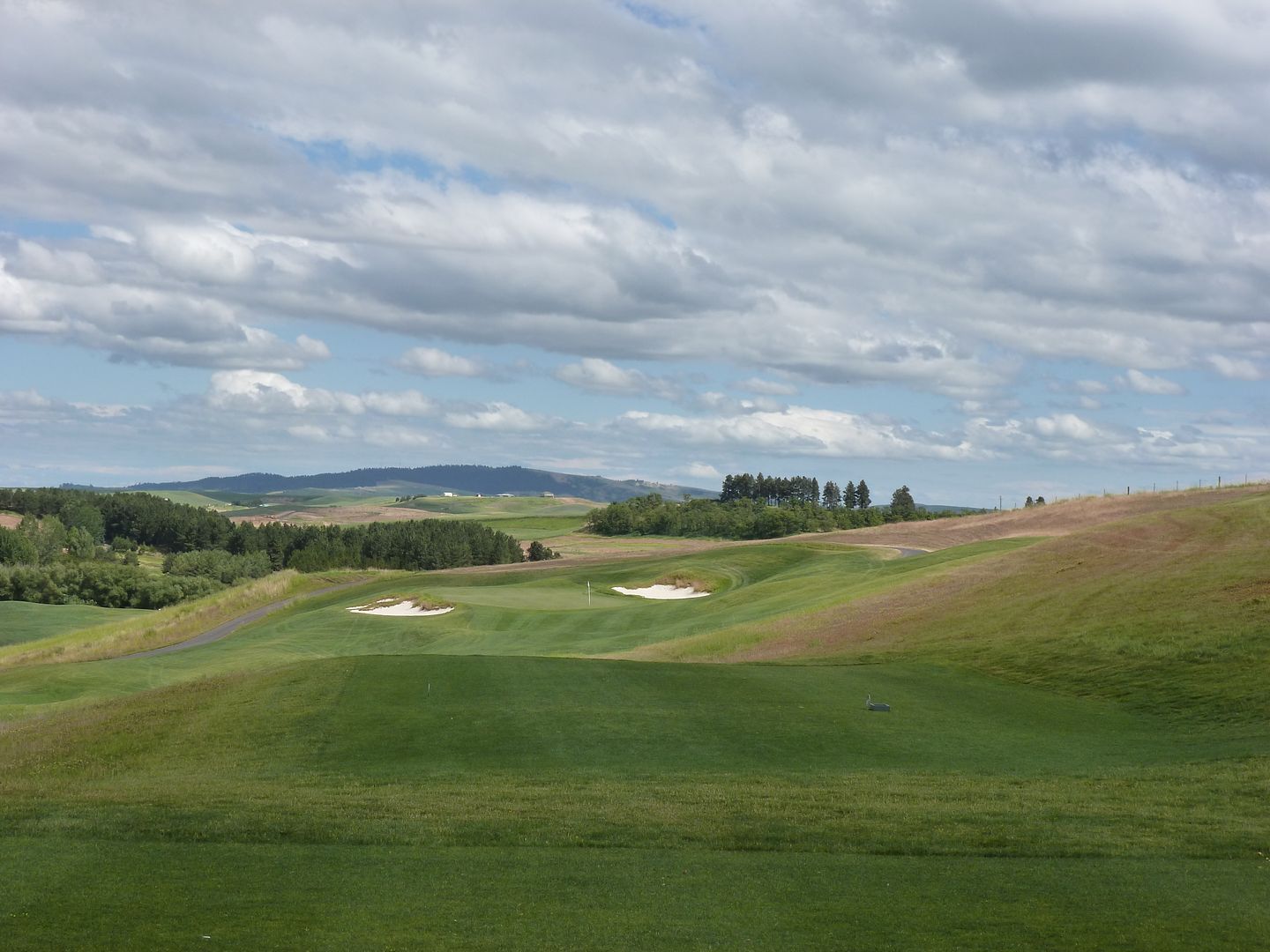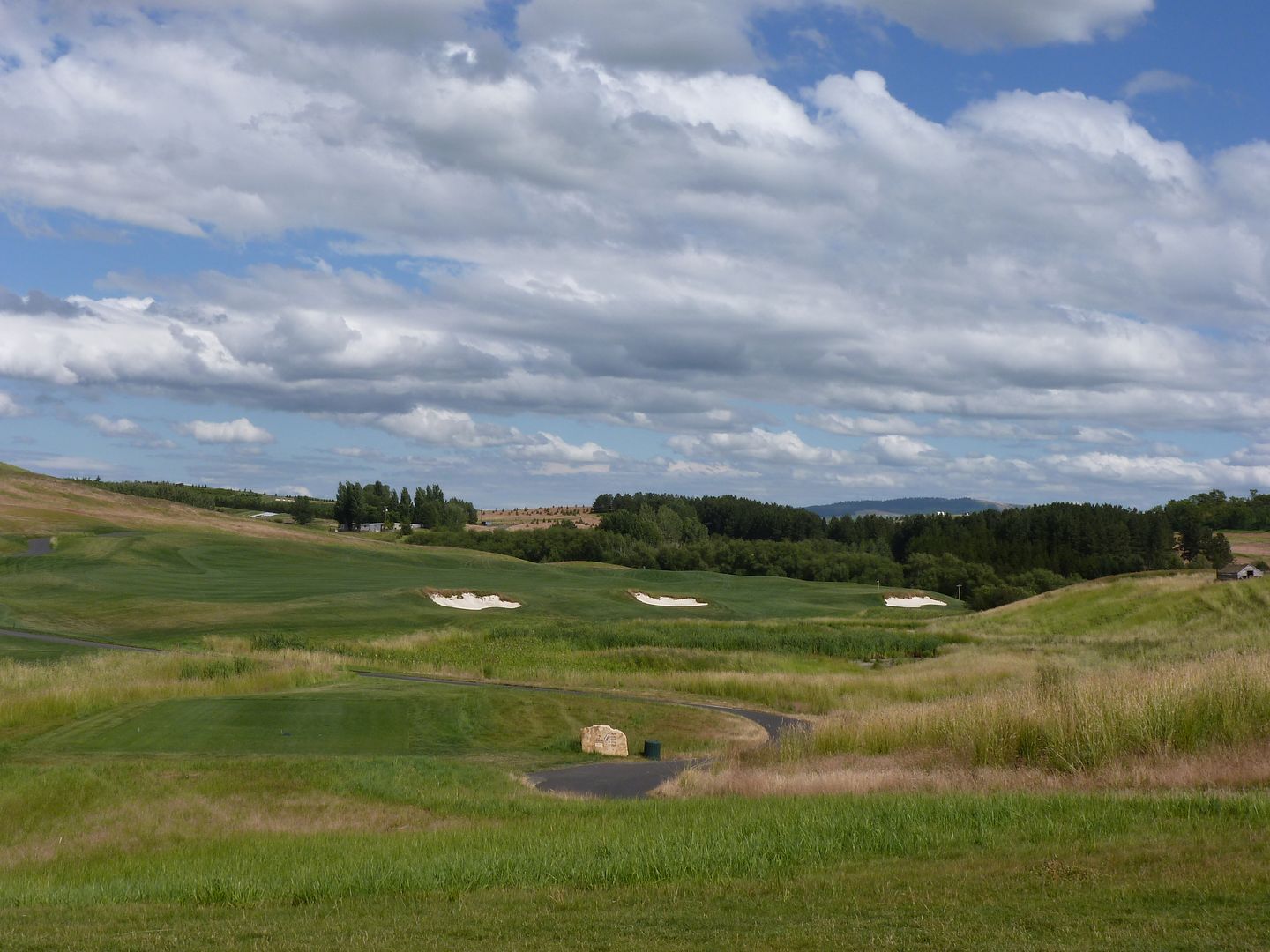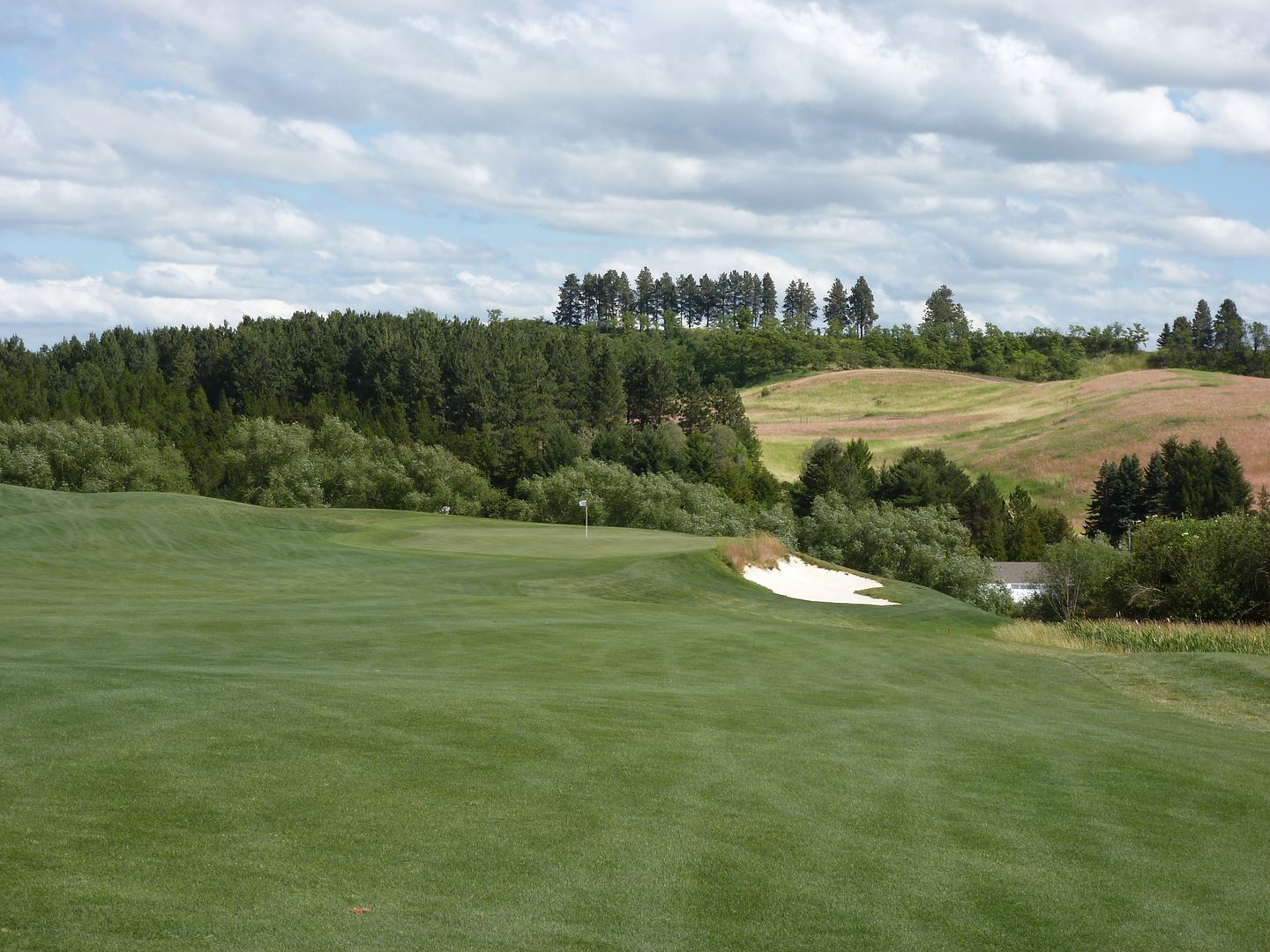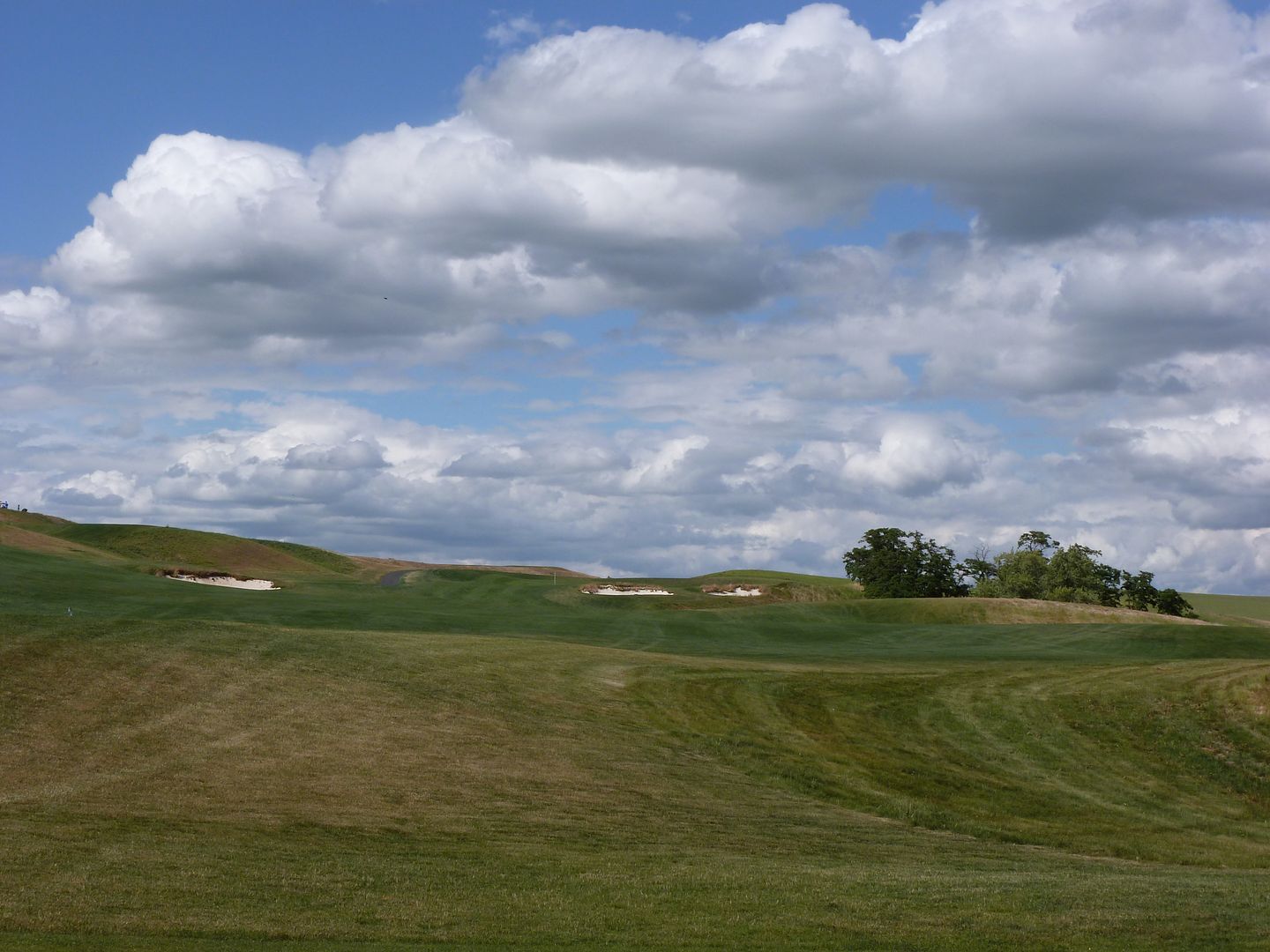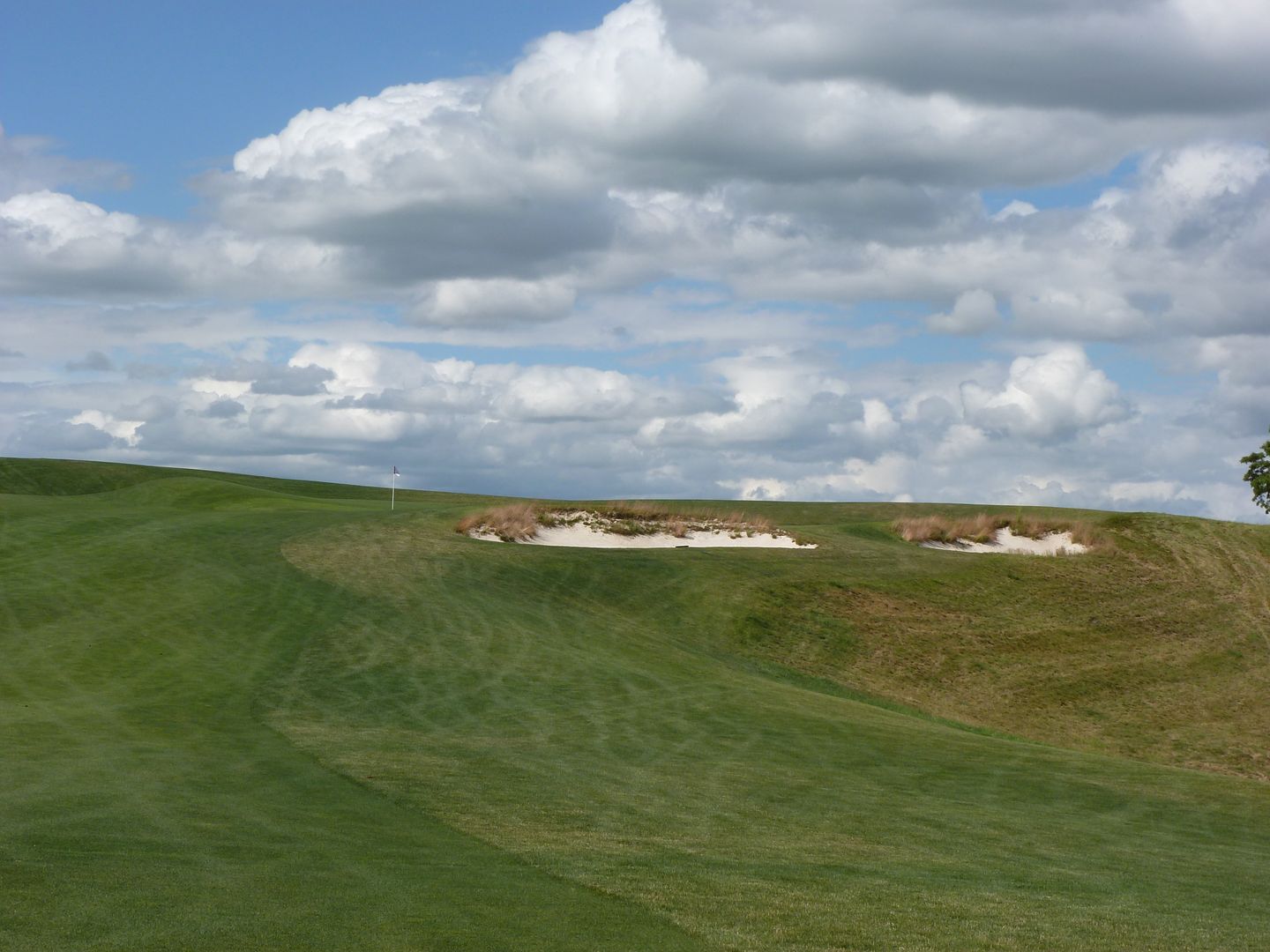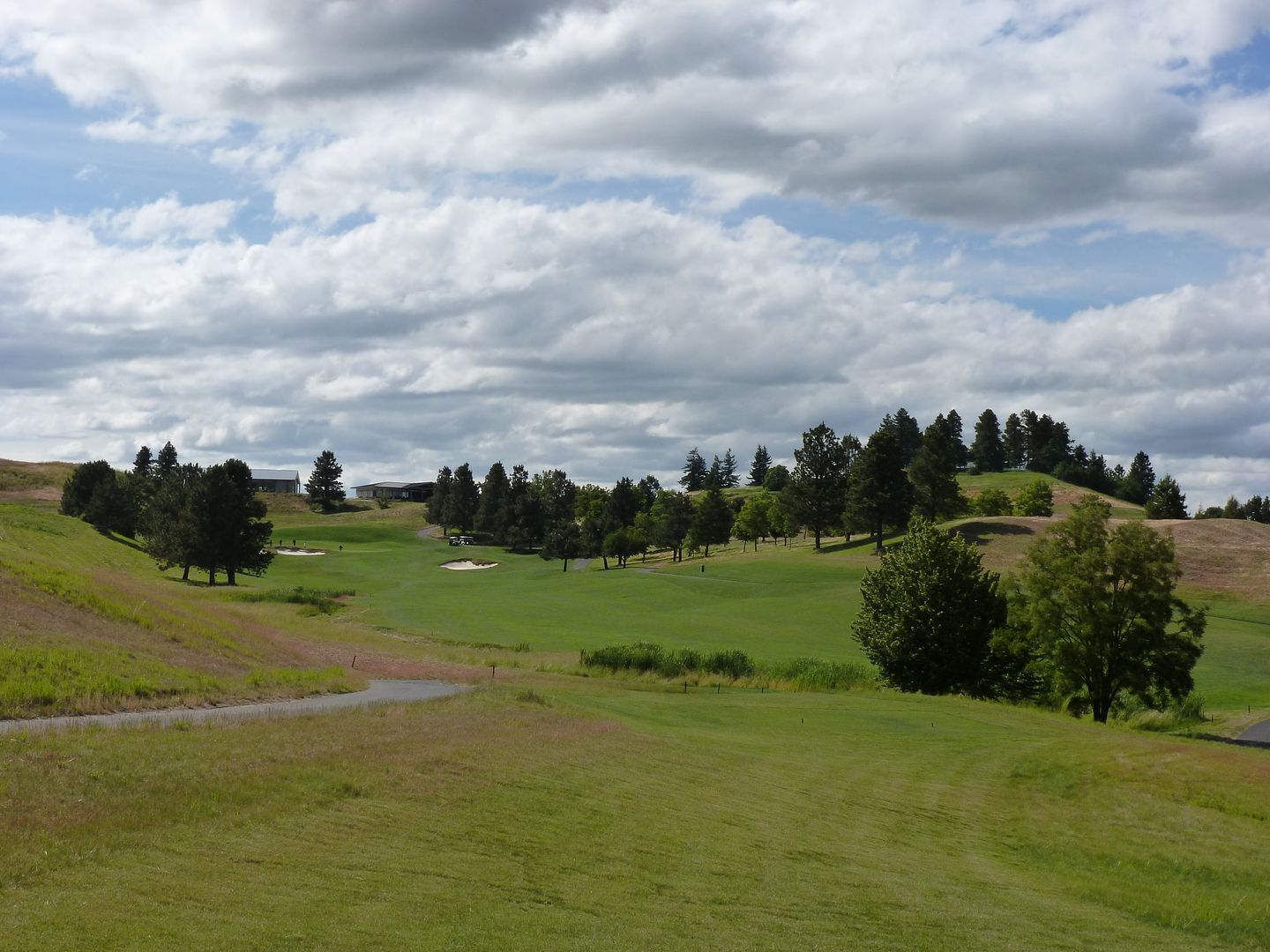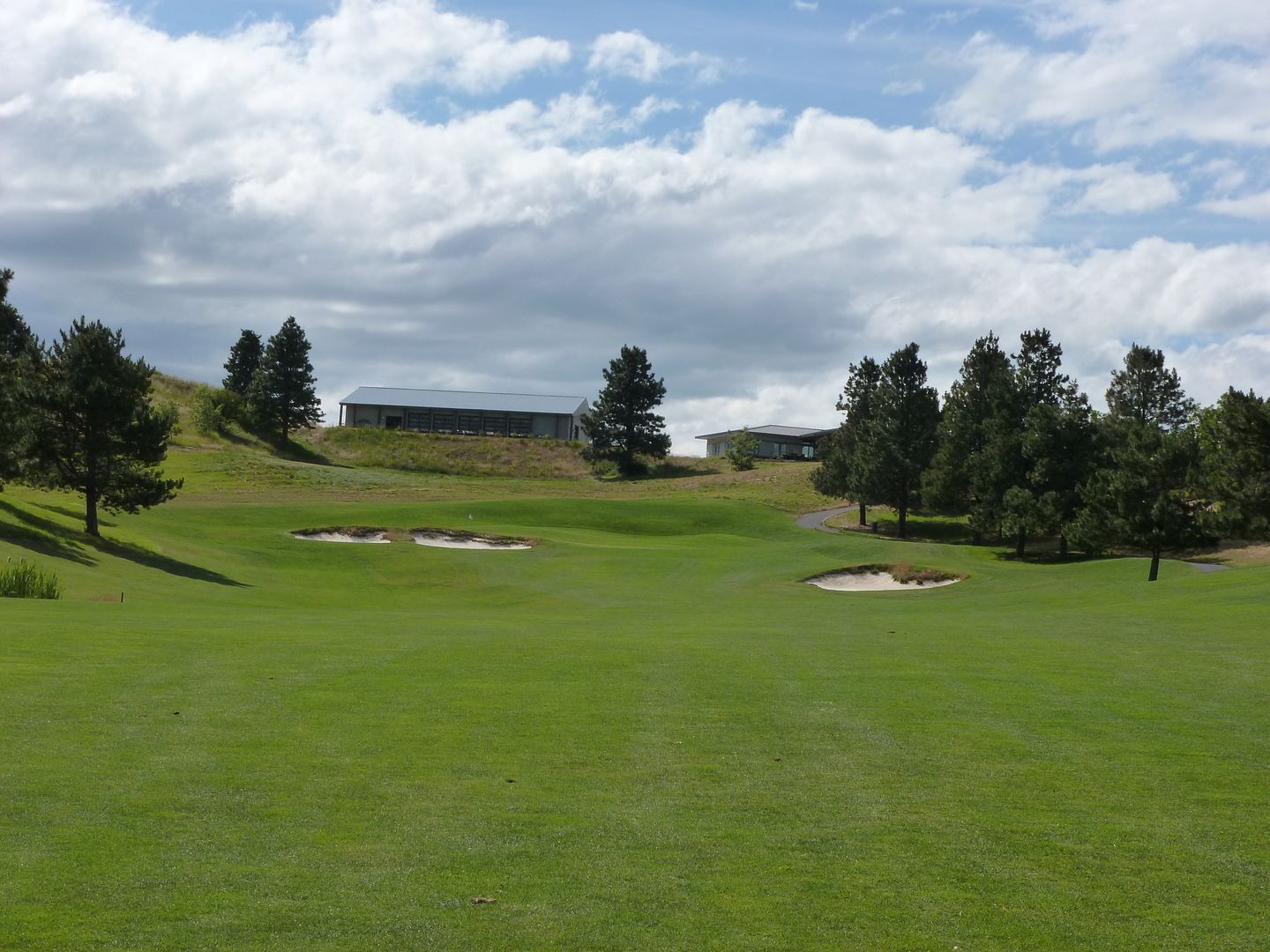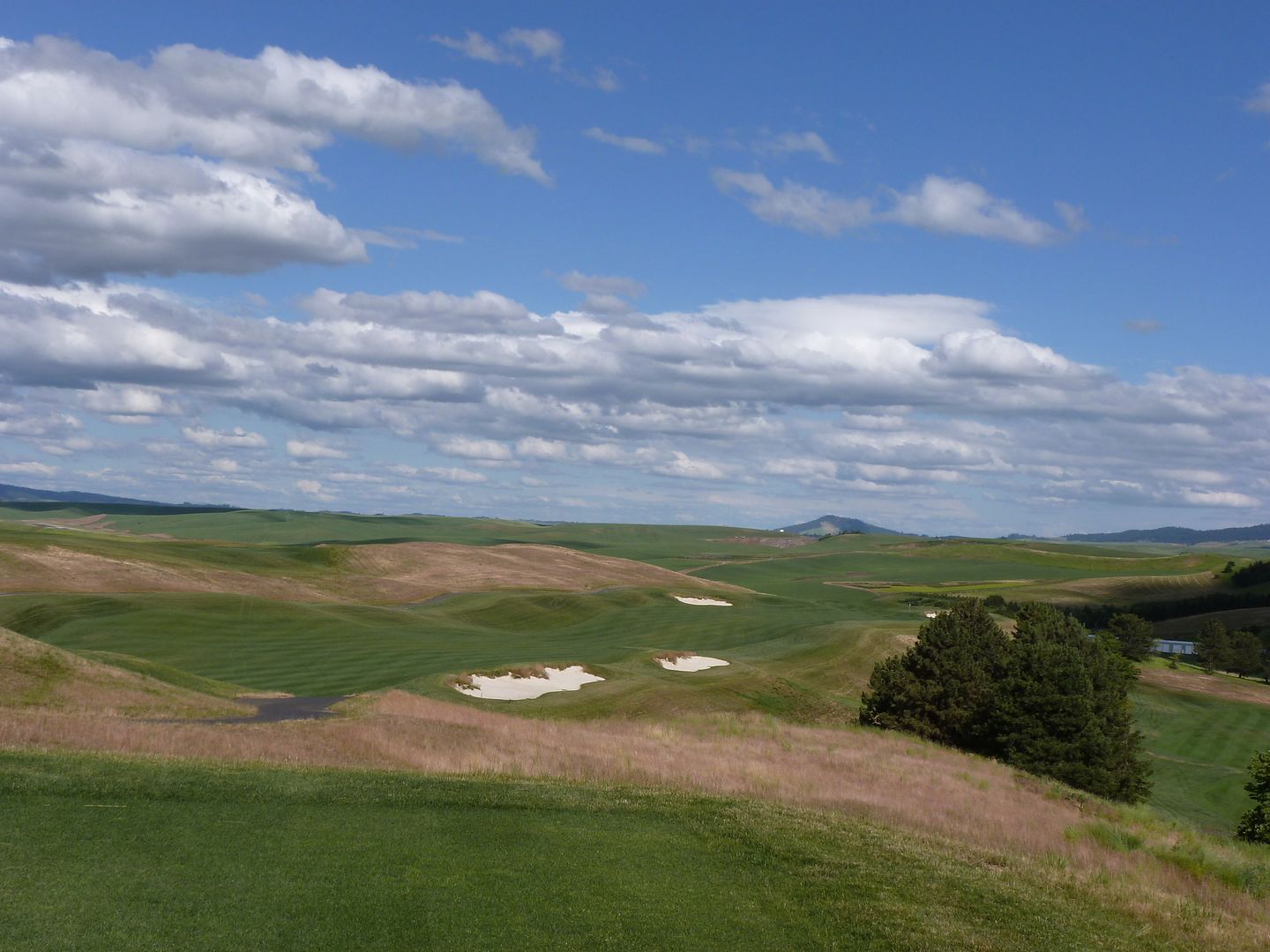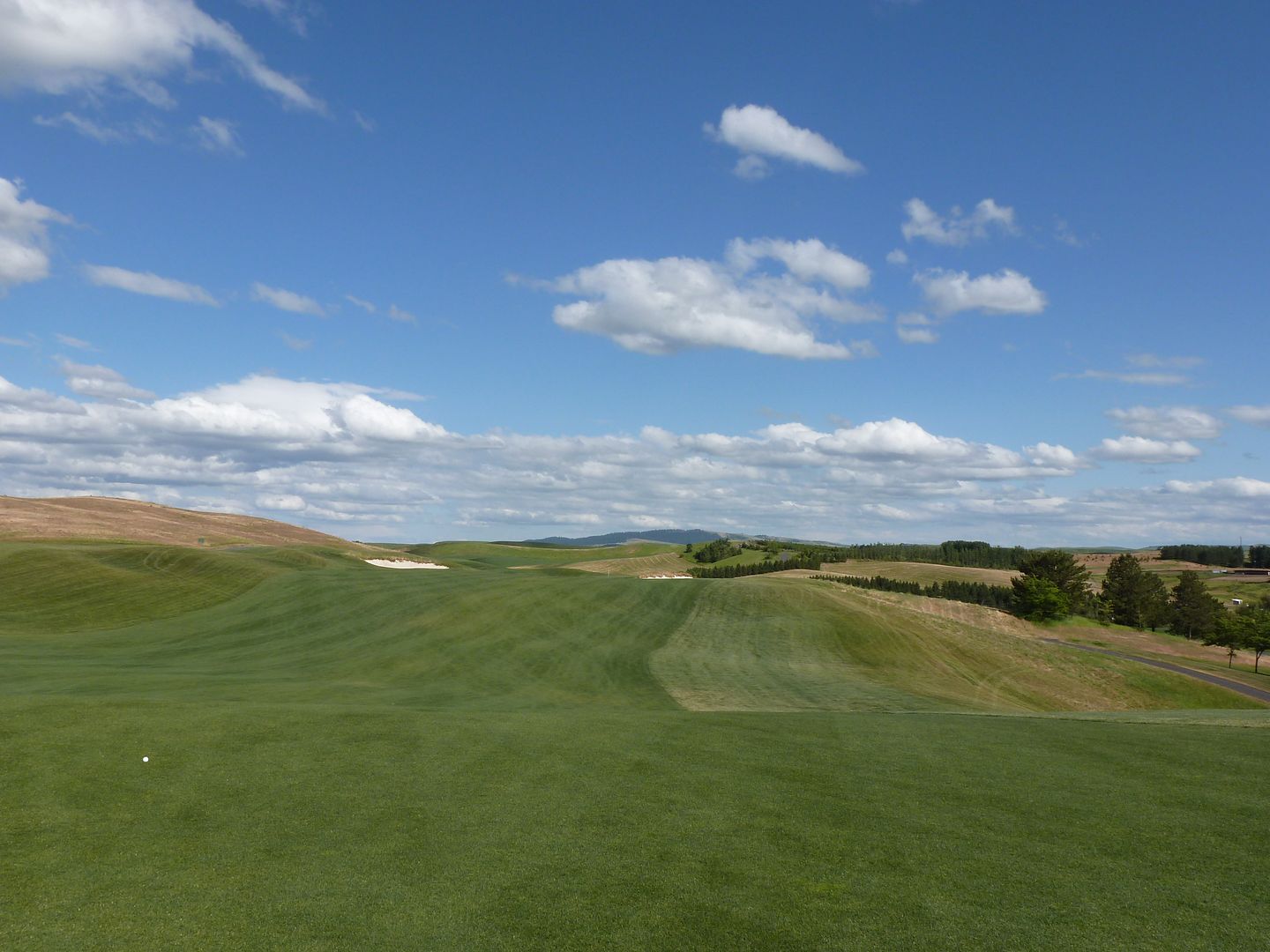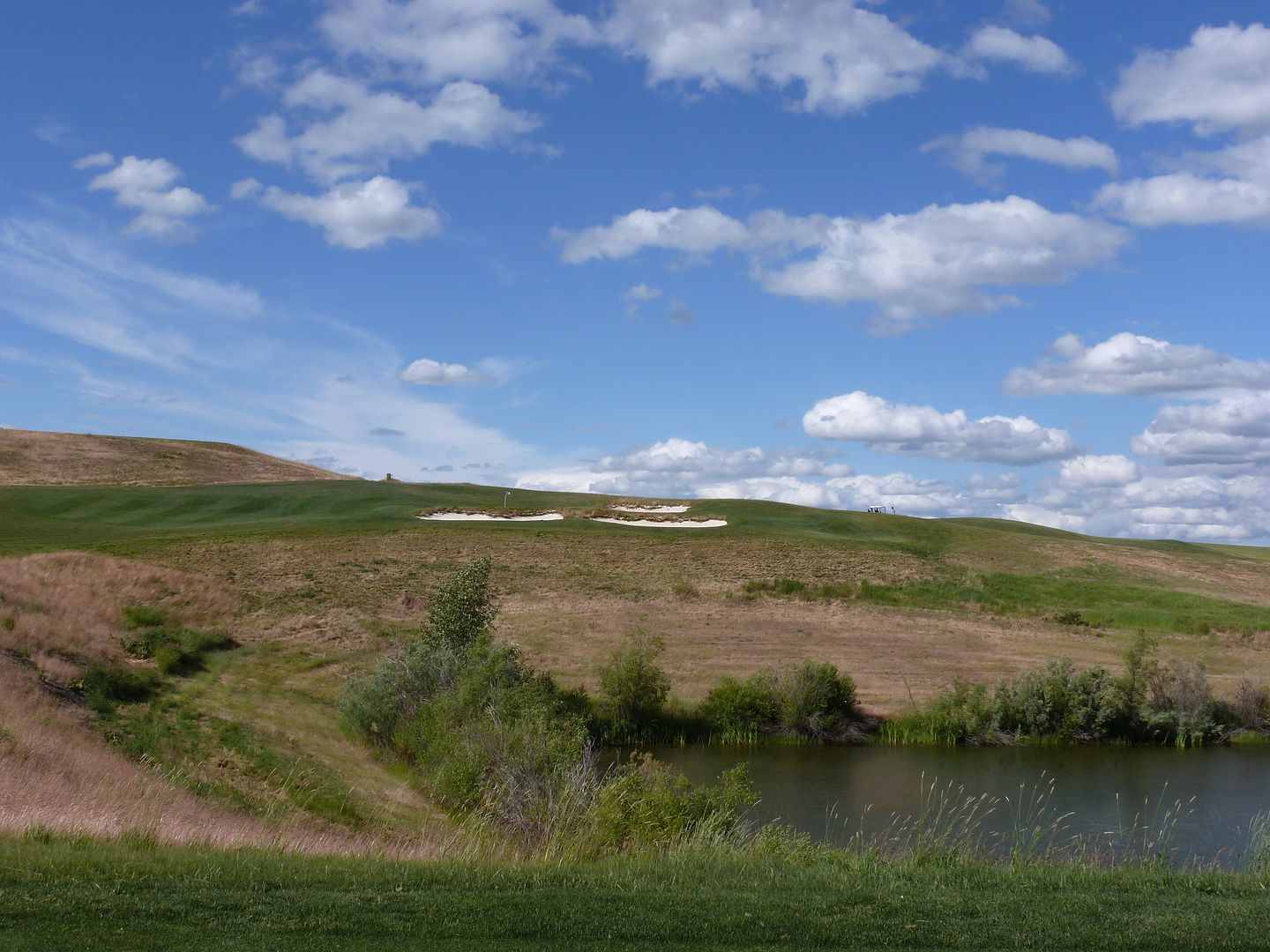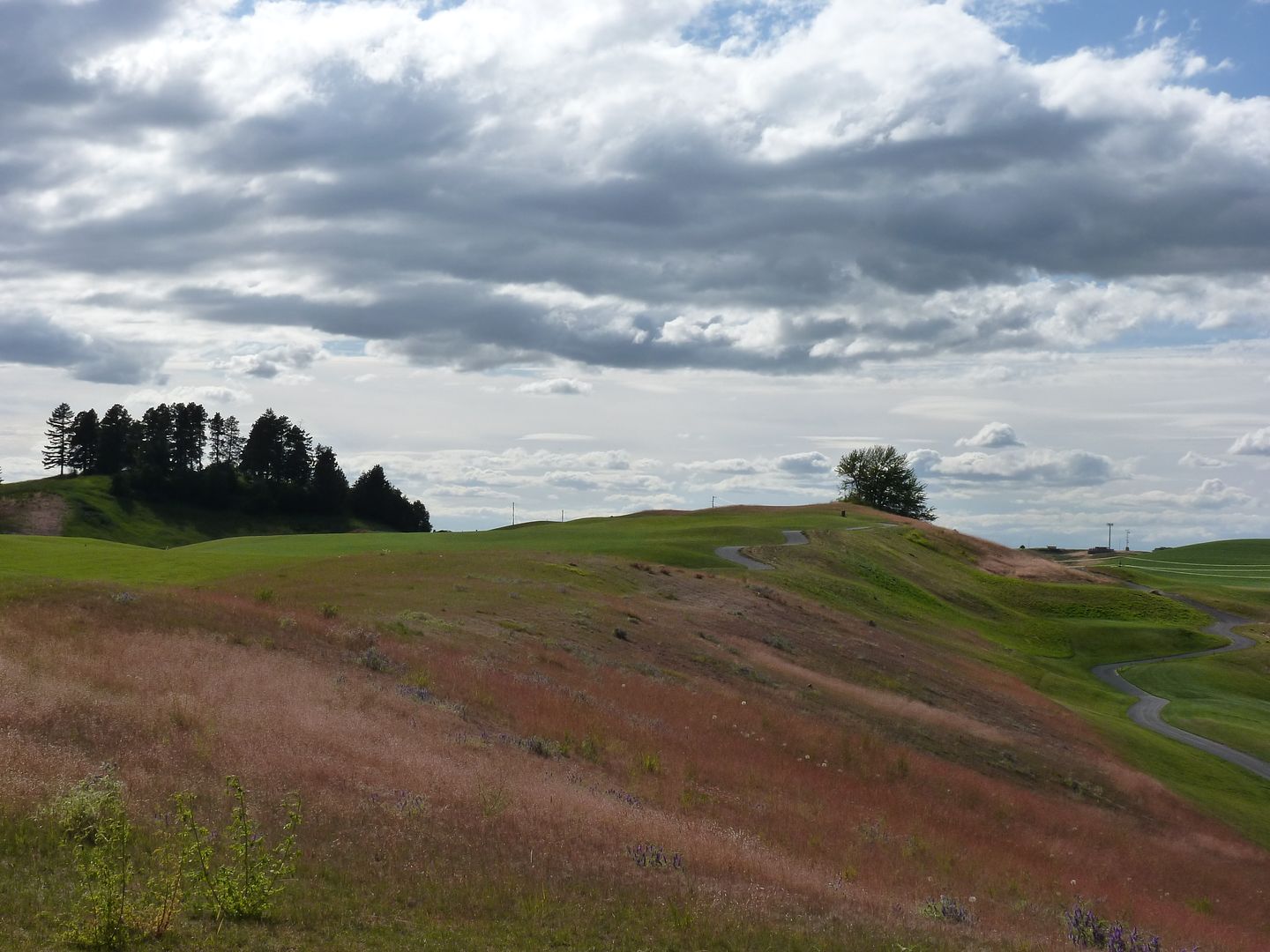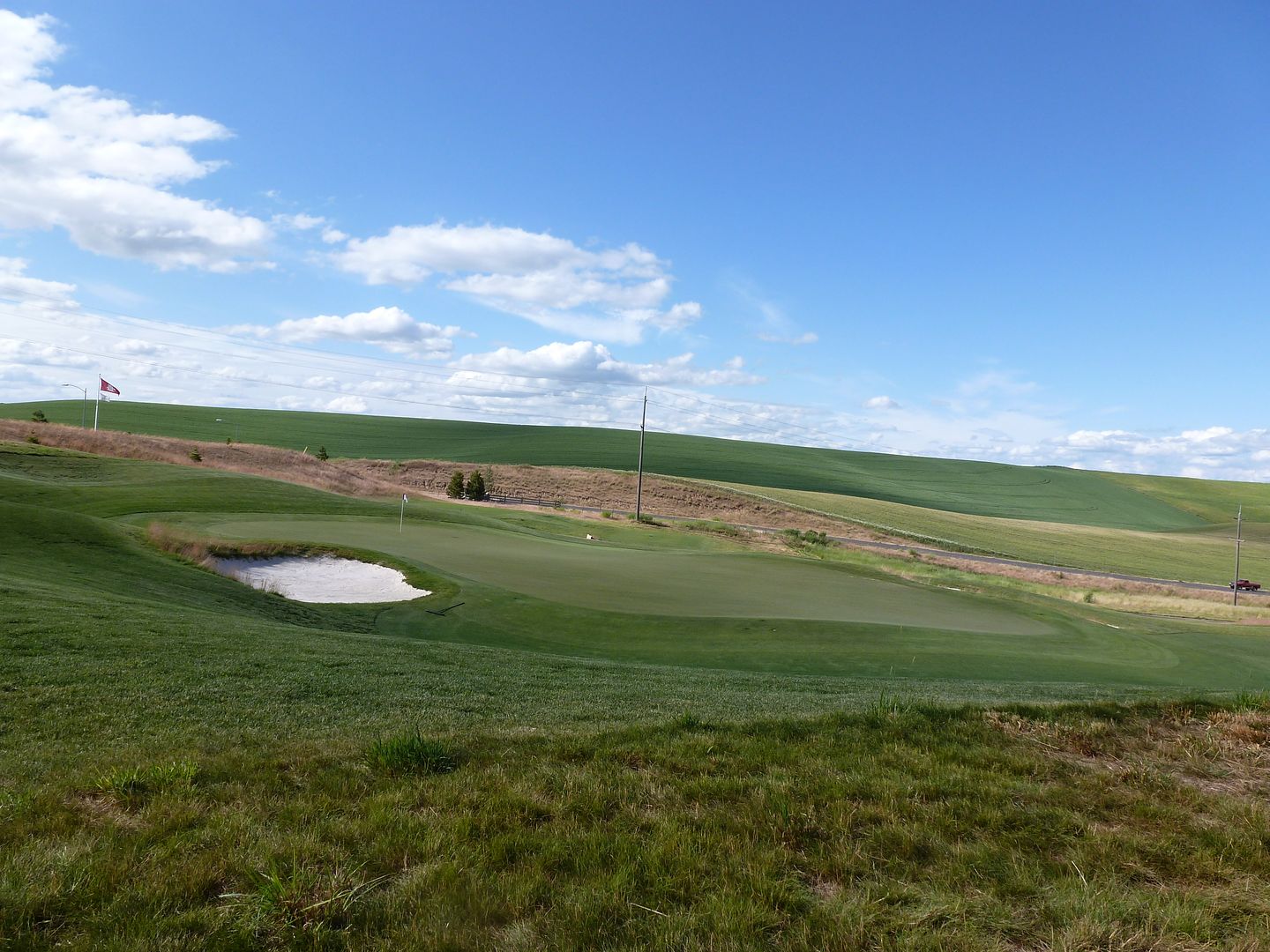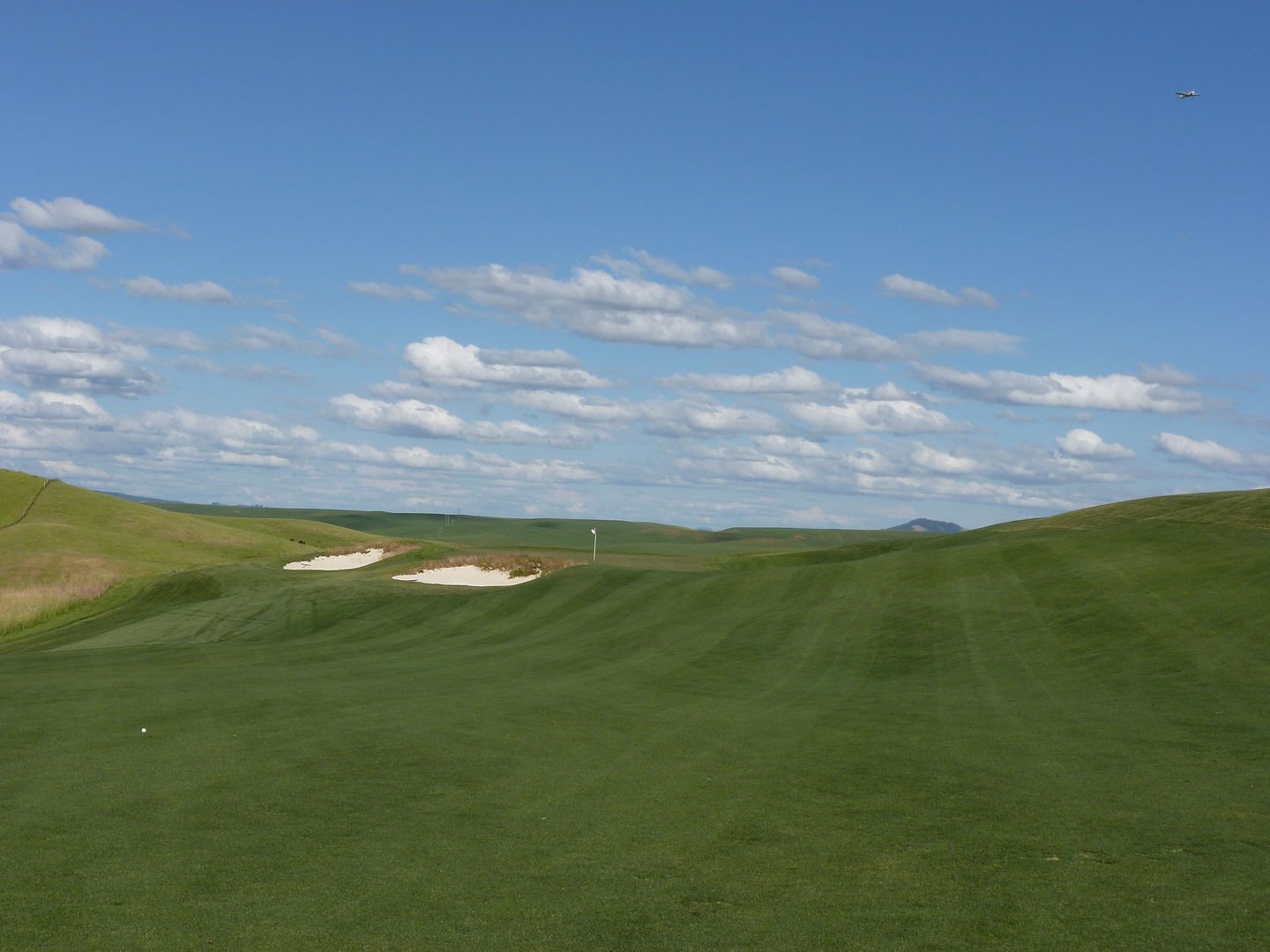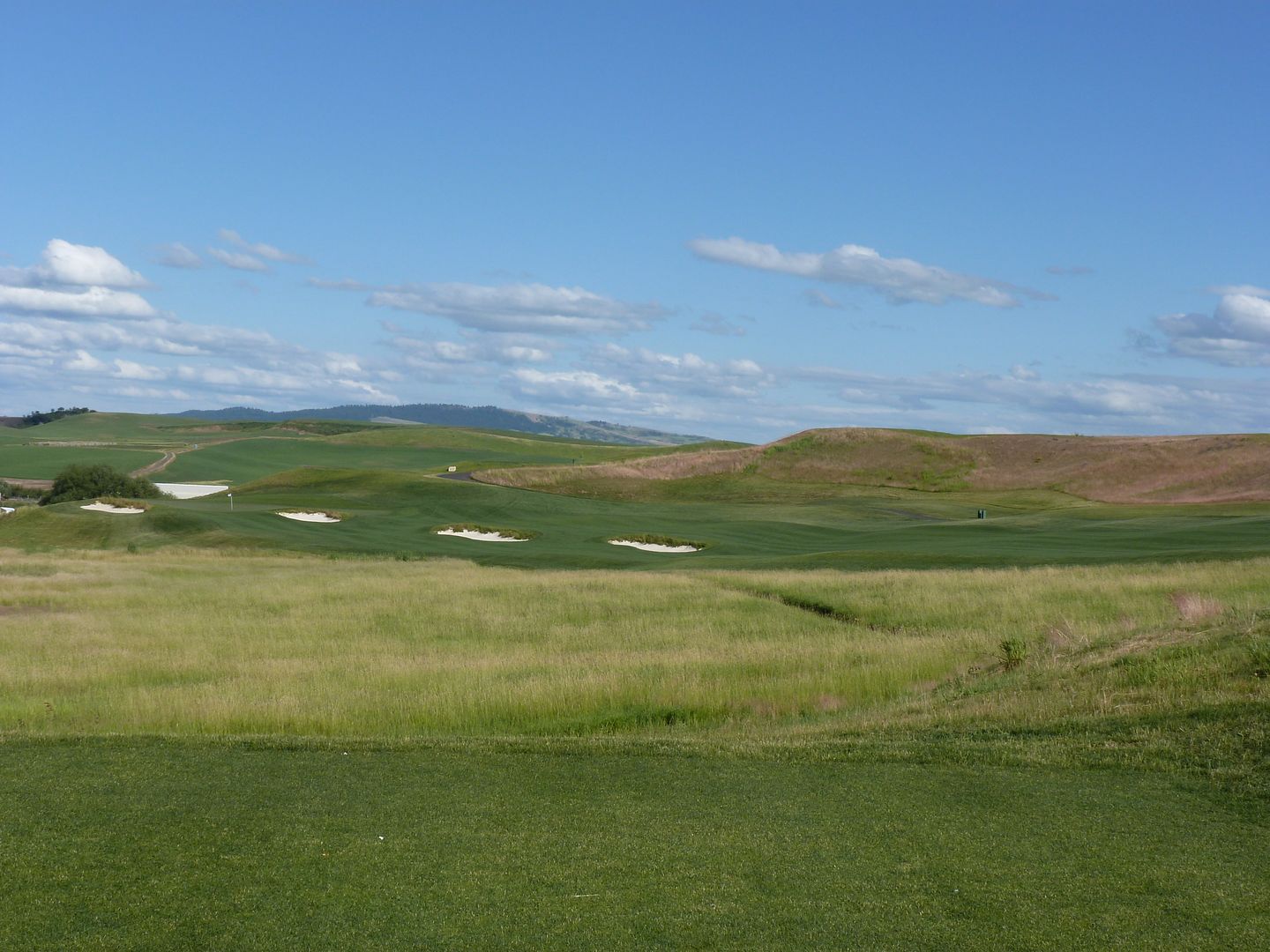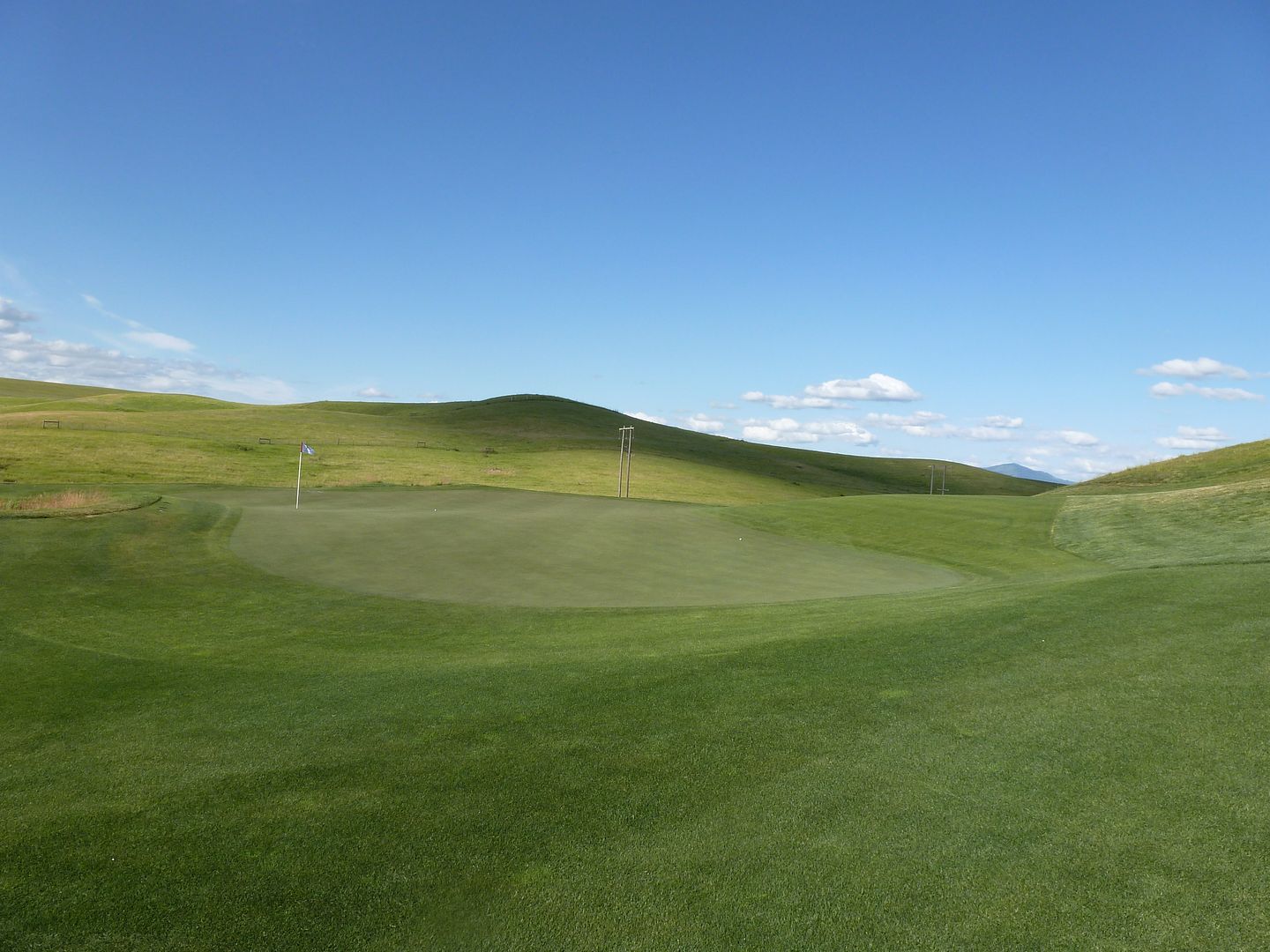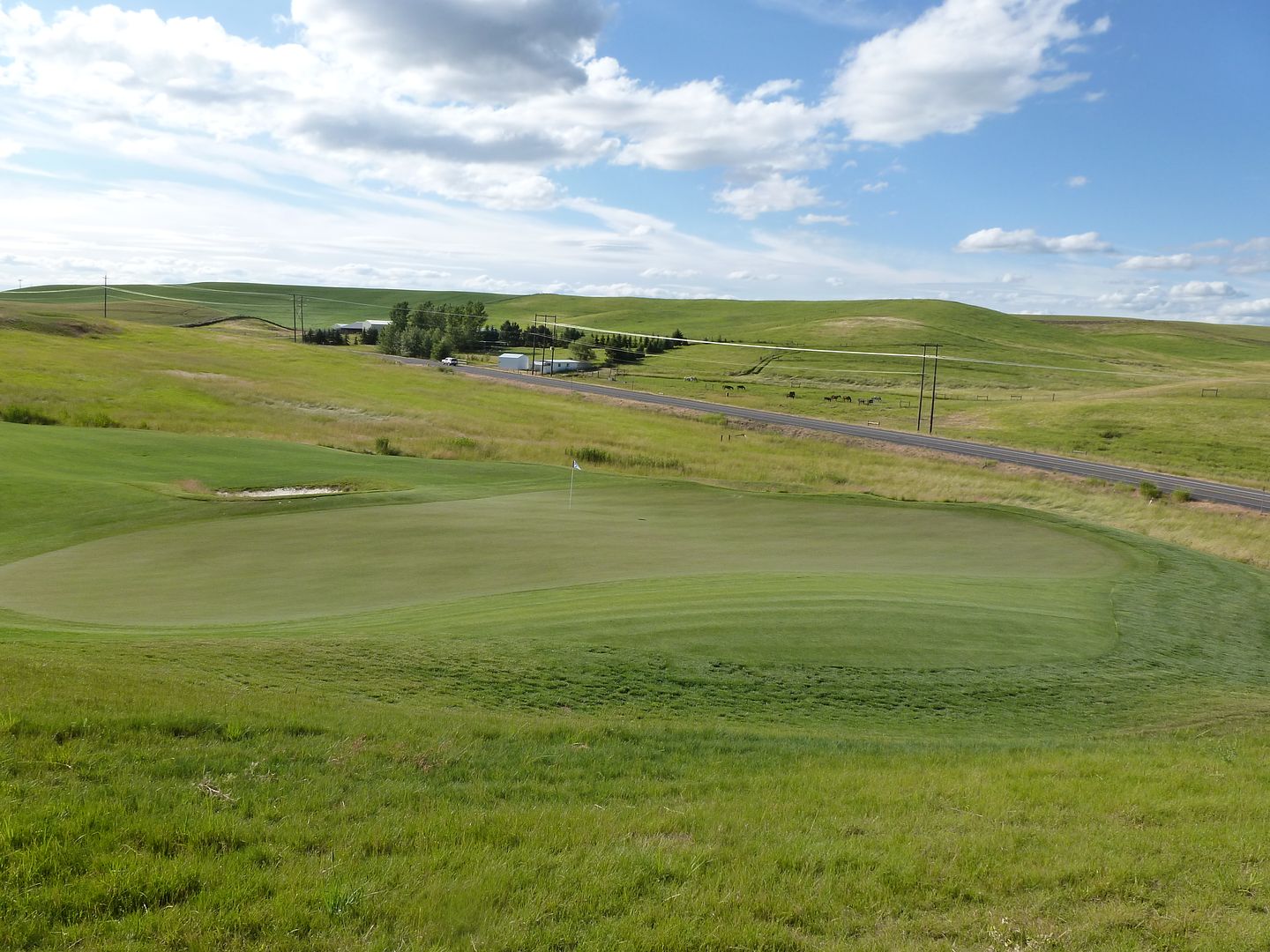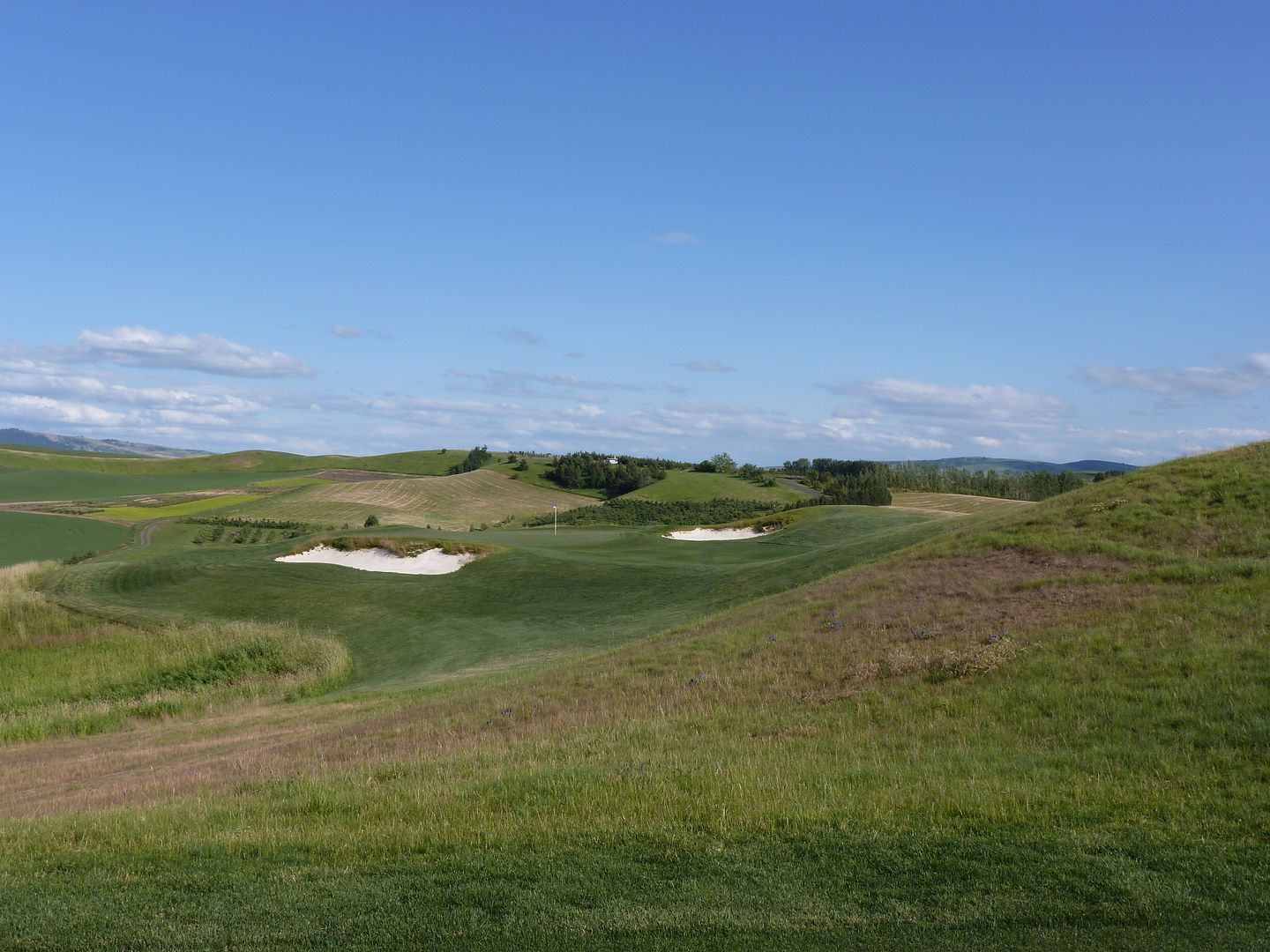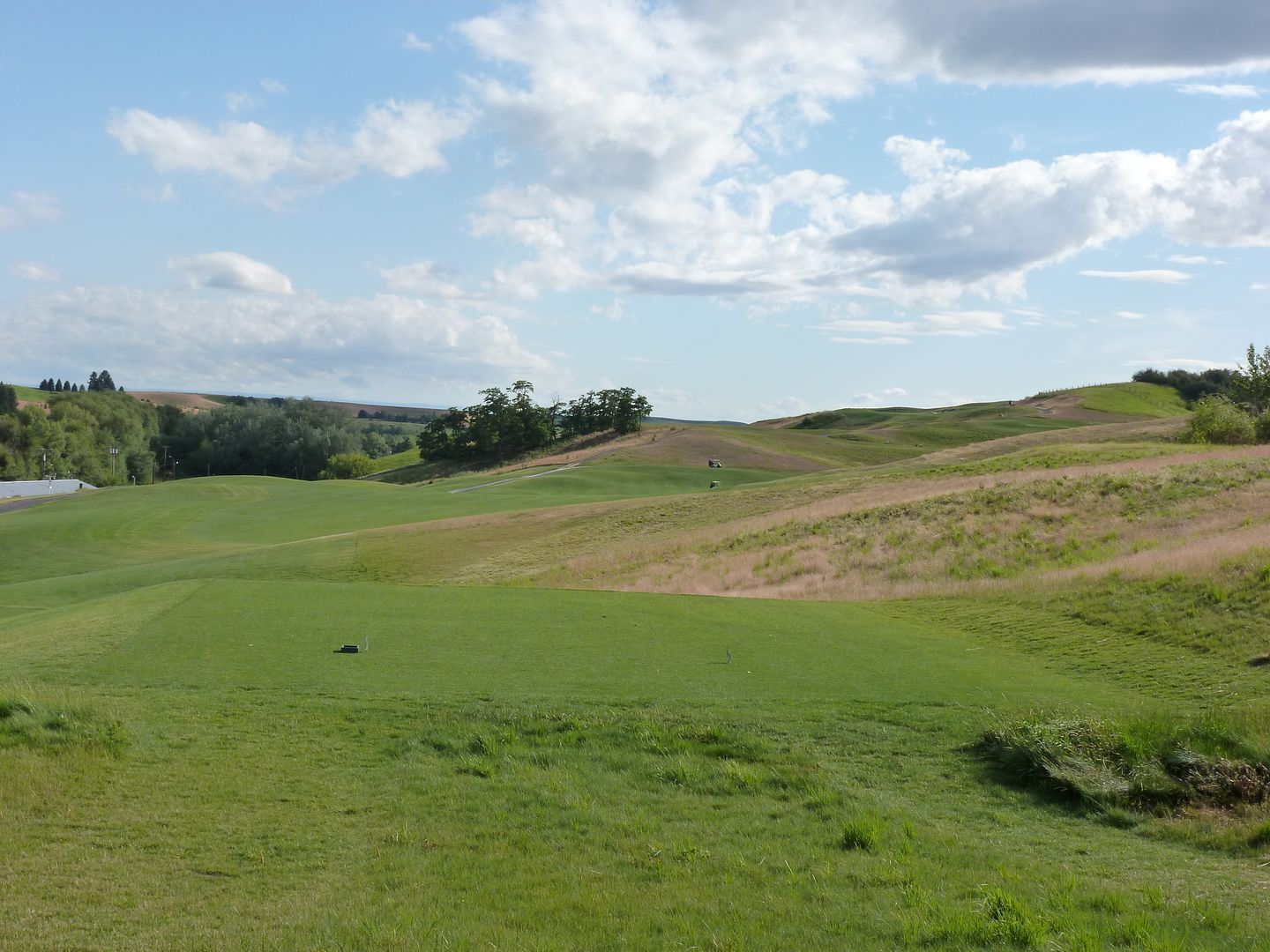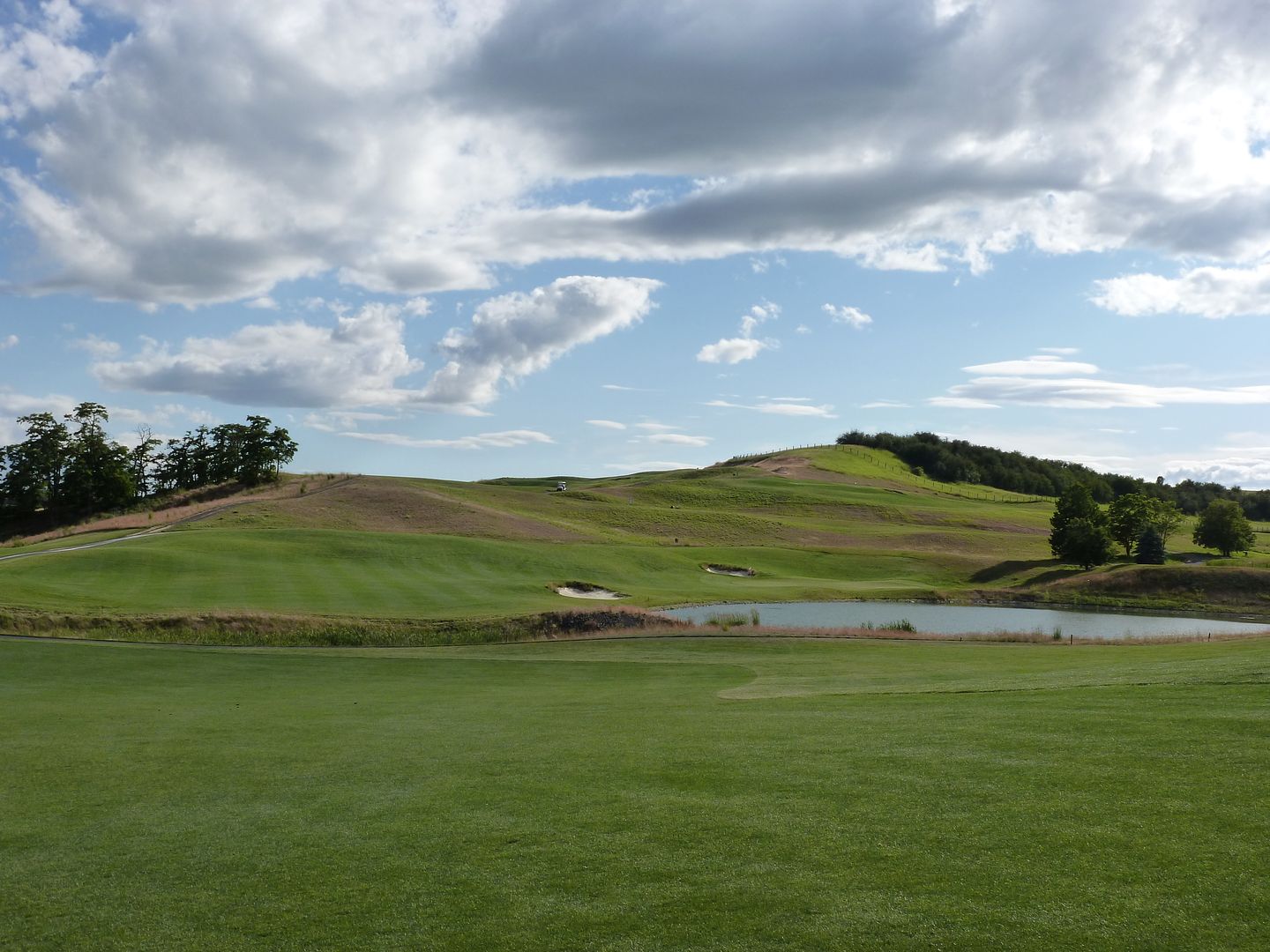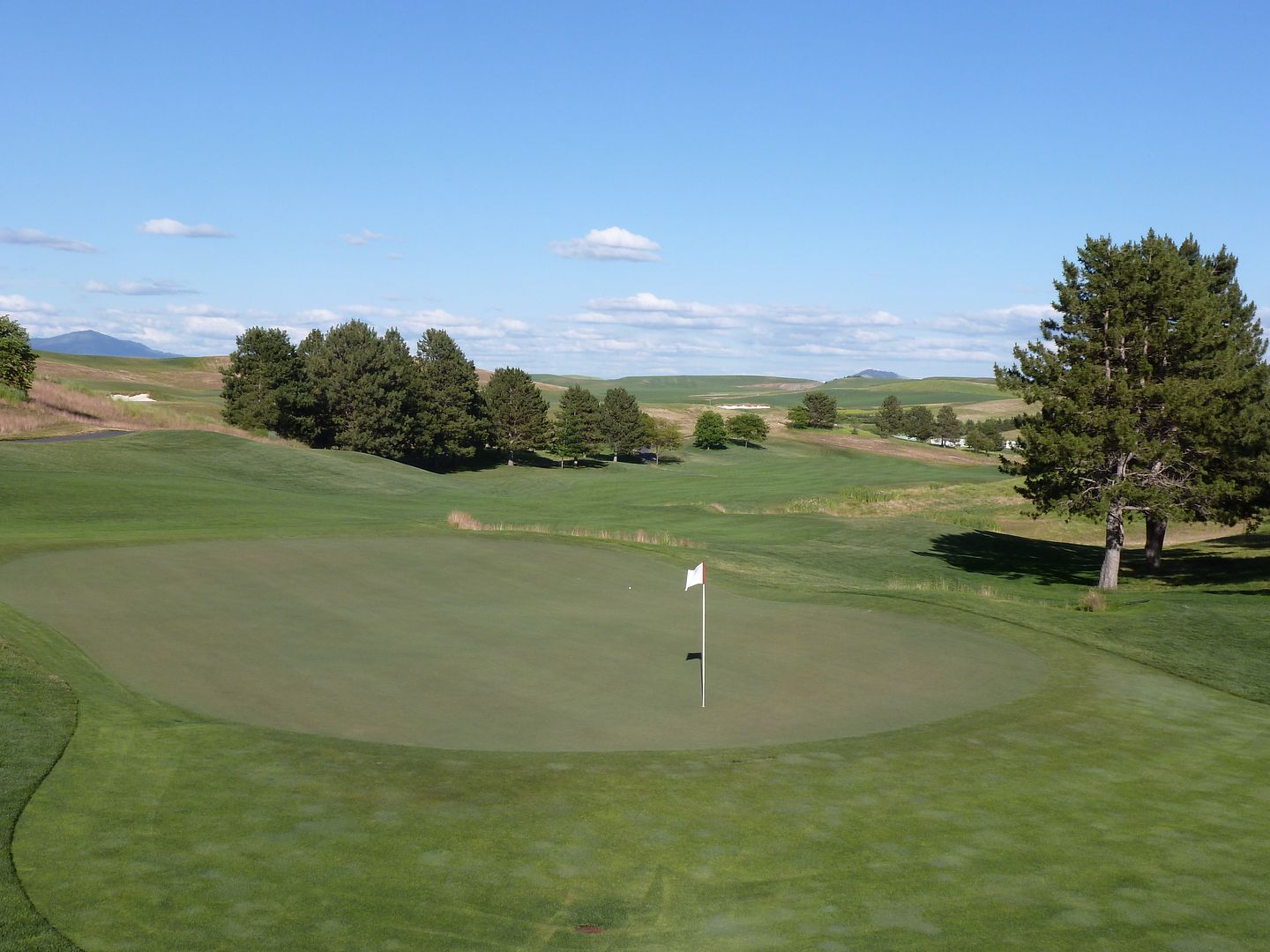Sanctuary Golf Course
Sedalia, Colorado, United States
Architect: Jim Engh (1997)
7,033 Yards, Par-72
Rating/Slope: 73.4/152
My Quick Review: Fascinating to Engh's style of design, but Sanctuary is routed over too severe a property.
Hole 1: Par 5, 607 YardsPlaying 245 feet downhill just in front of the clubhouse, this is one scary tee shot. The fairway runs out at 310 yards and that is easily reachable. The clever play is to lay-up short of the fairway narrowing area to leave a simple lay-up second shot. Truthfully, most (including myself) are aiming to have the ball just end up somewhere between the left trees and the right trees.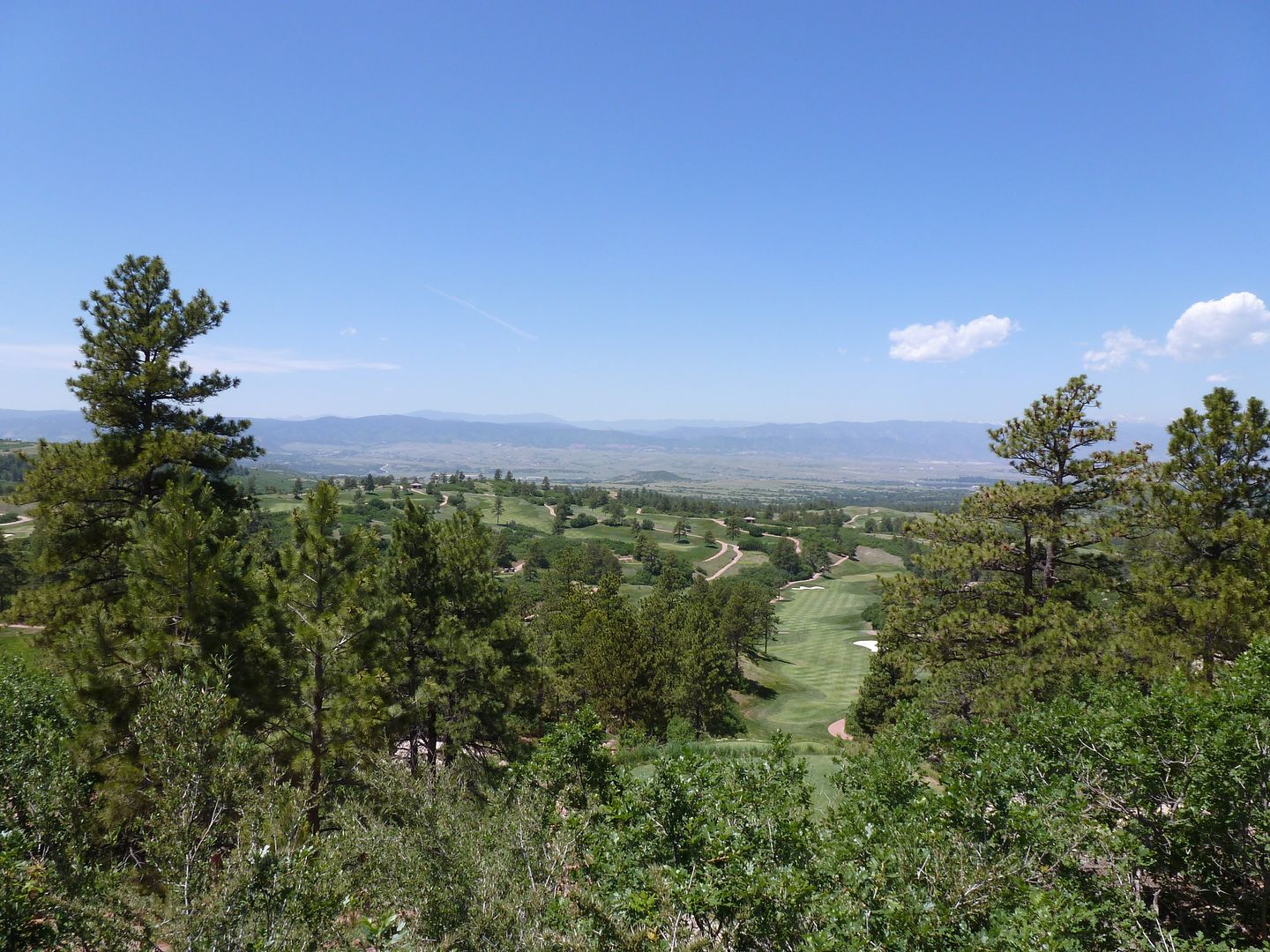
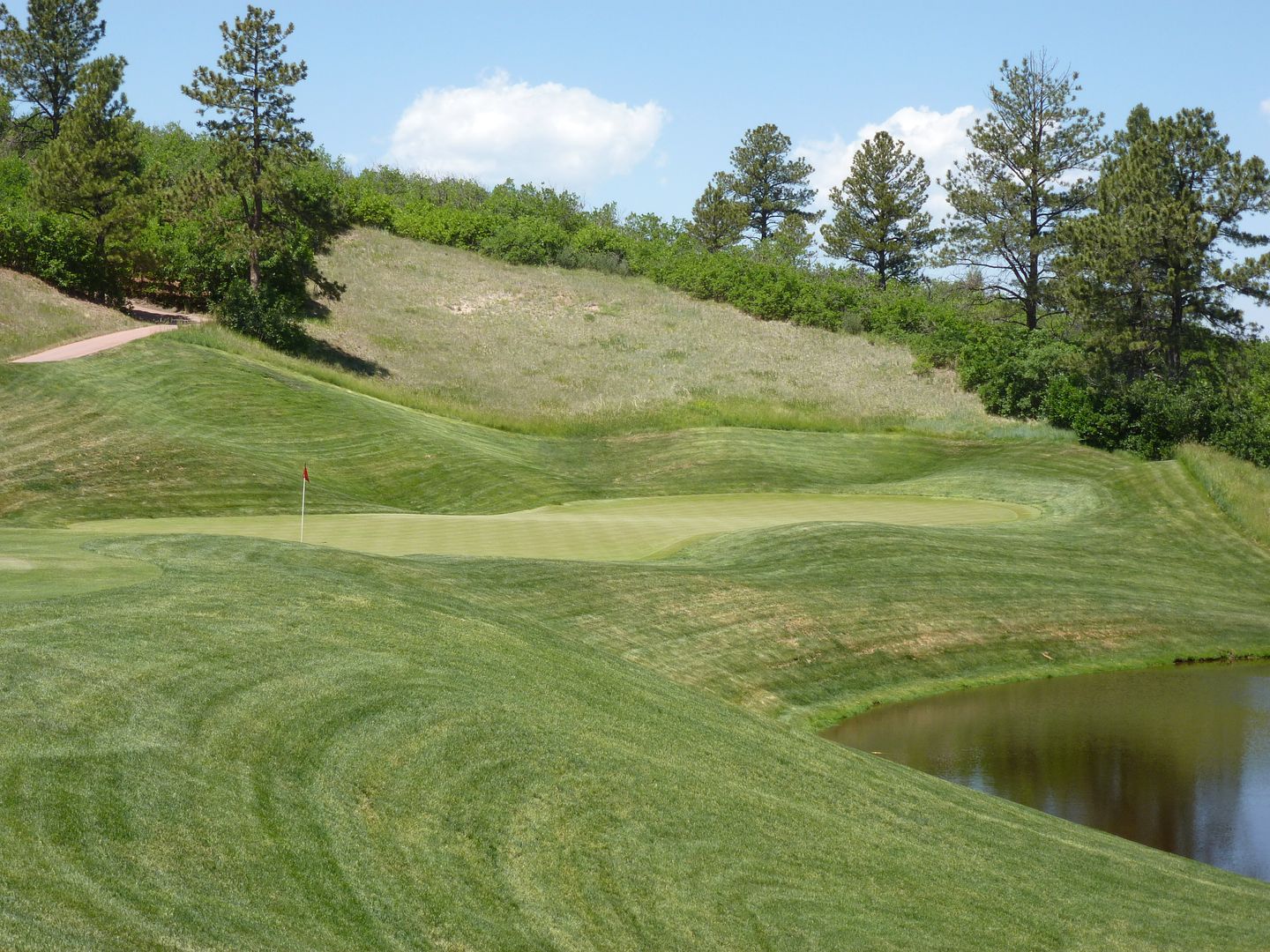 Hole 2 - Par 4, 458 YardsA narrow, very intimidating tee shot that plays easier than it looks. The fairway only gets really narrow 280+ yards from the tee. Most tee shots will land in the wider portion of the fairway and the contours of the fairway will funnel shots missed a little left or right to the middle.
Hole 2 - Par 4, 458 YardsA narrow, very intimidating tee shot that plays easier than it looks. The fairway only gets really narrow 280+ yards from the tee. Most tee shots will land in the wider portion of the fairway and the contours of the fairway will funnel shots missed a little left or right to the middle. 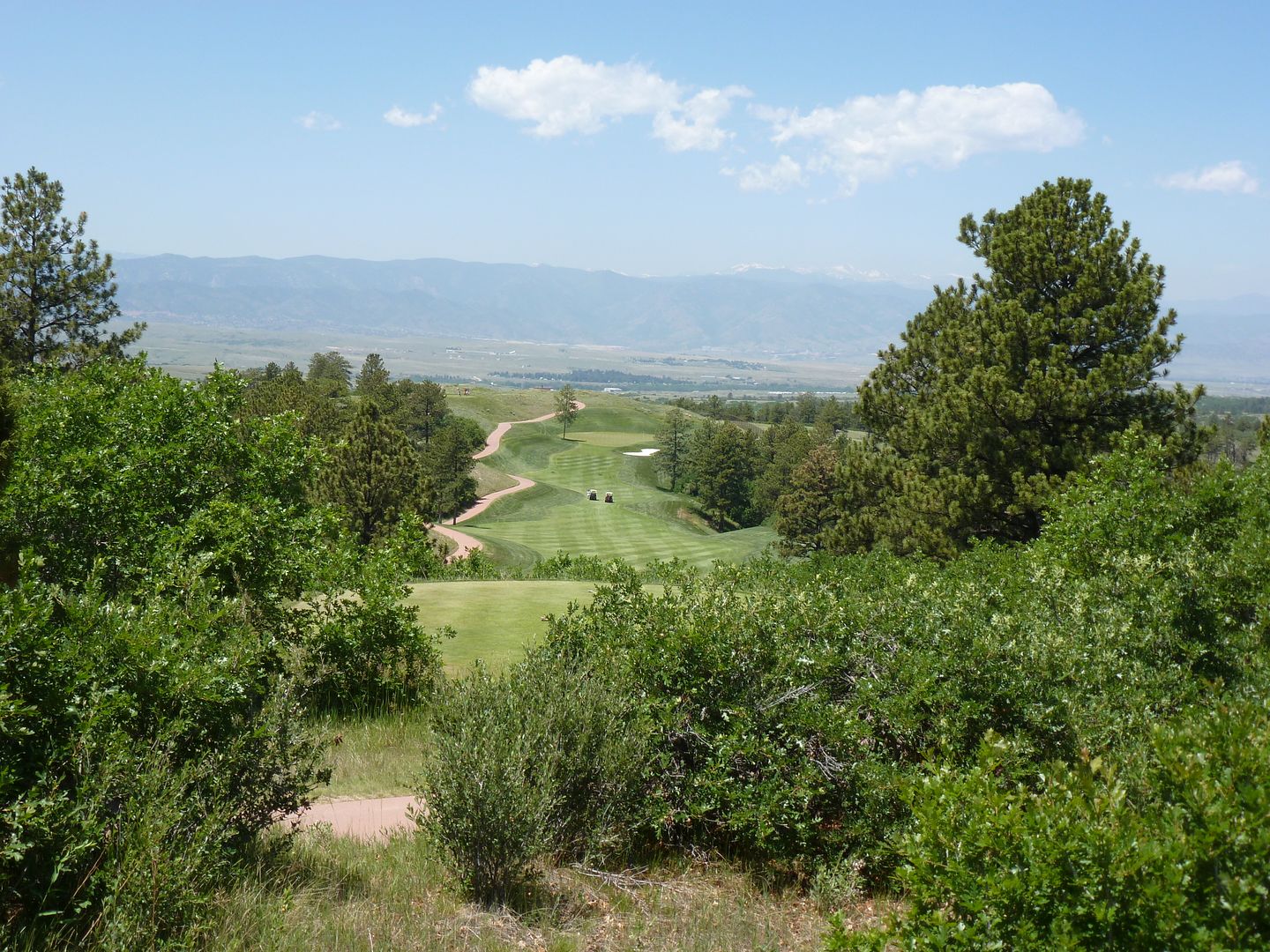
 Hole 3: Par 4, 432 YardsAnother intimidating, semi-blind tee shot. Playing into the wind, the fairway bunkers are a very long way away and the landing area is blind from the tee. From the shape of the hole, it appears that the best angle is from the right, but it is not until you actually get down to the fairway that one sees how important not being left is. There is a large group of trees short of the green that make any approach from the left rough all but impossible.
Hole 3: Par 4, 432 YardsAnother intimidating, semi-blind tee shot. Playing into the wind, the fairway bunkers are a very long way away and the landing area is blind from the tee. From the shape of the hole, it appears that the best angle is from the right, but it is not until you actually get down to the fairway that one sees how important not being left is. There is a large group of trees short of the green that make any approach from the left rough all but impossible.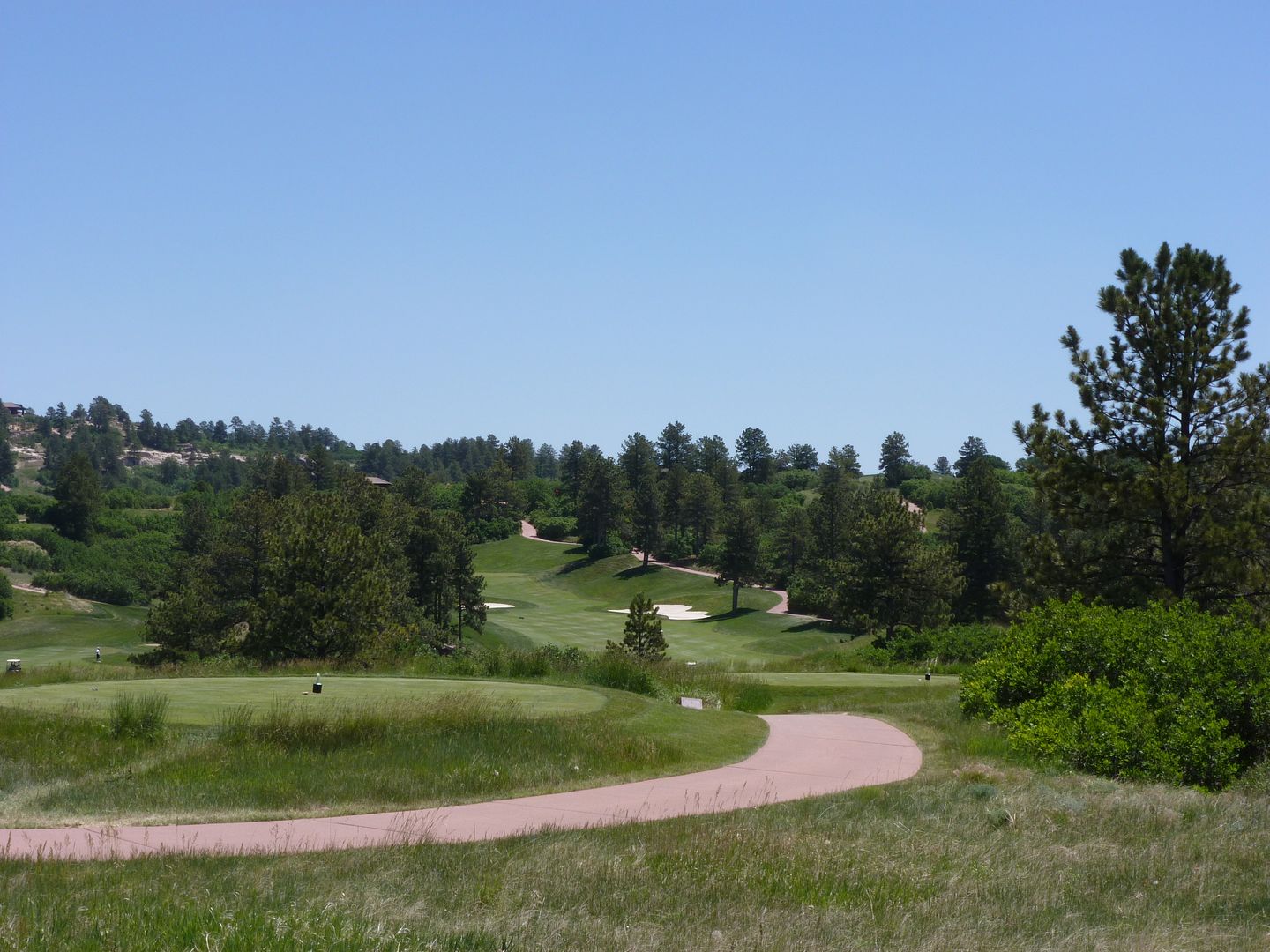
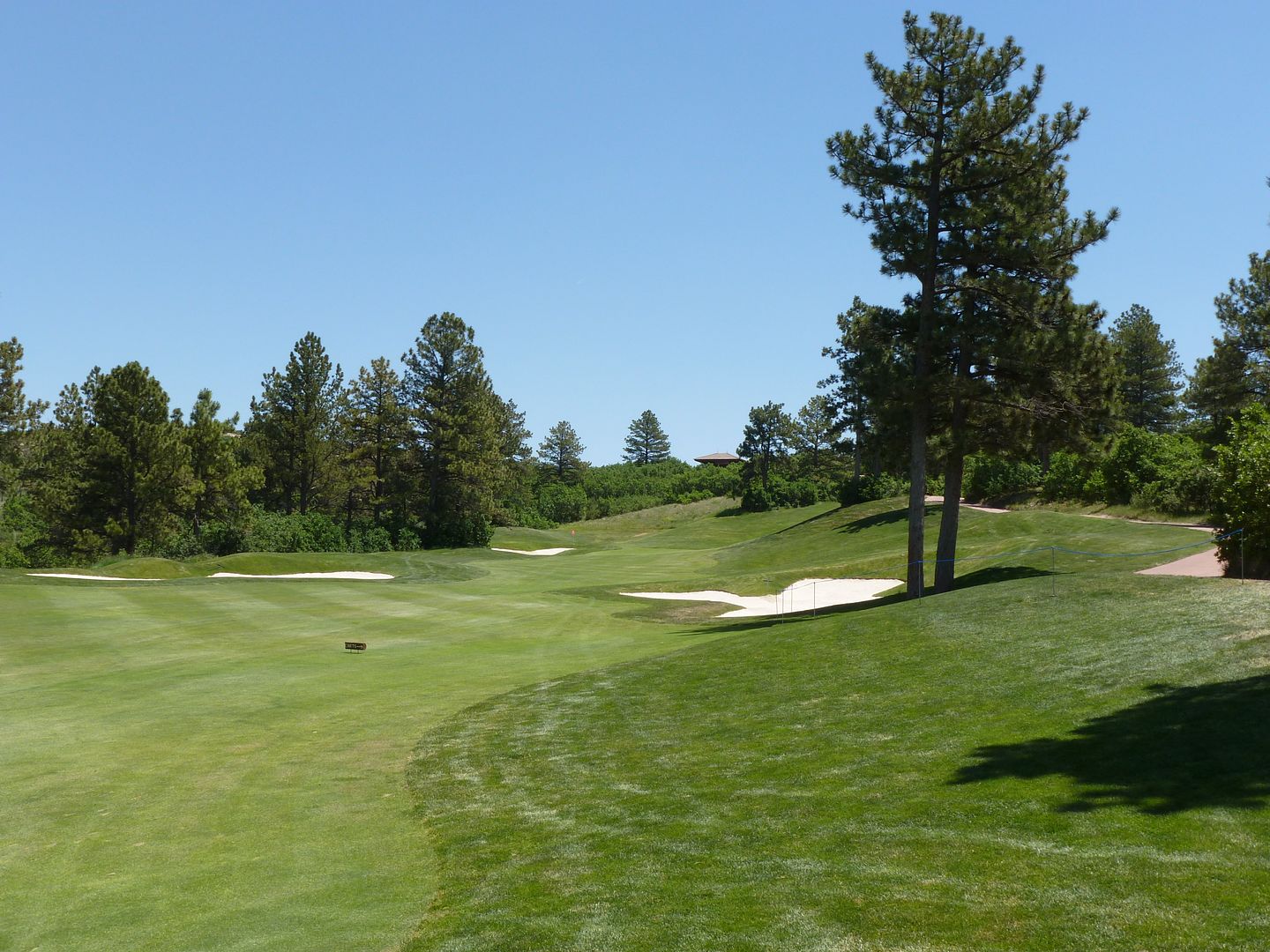
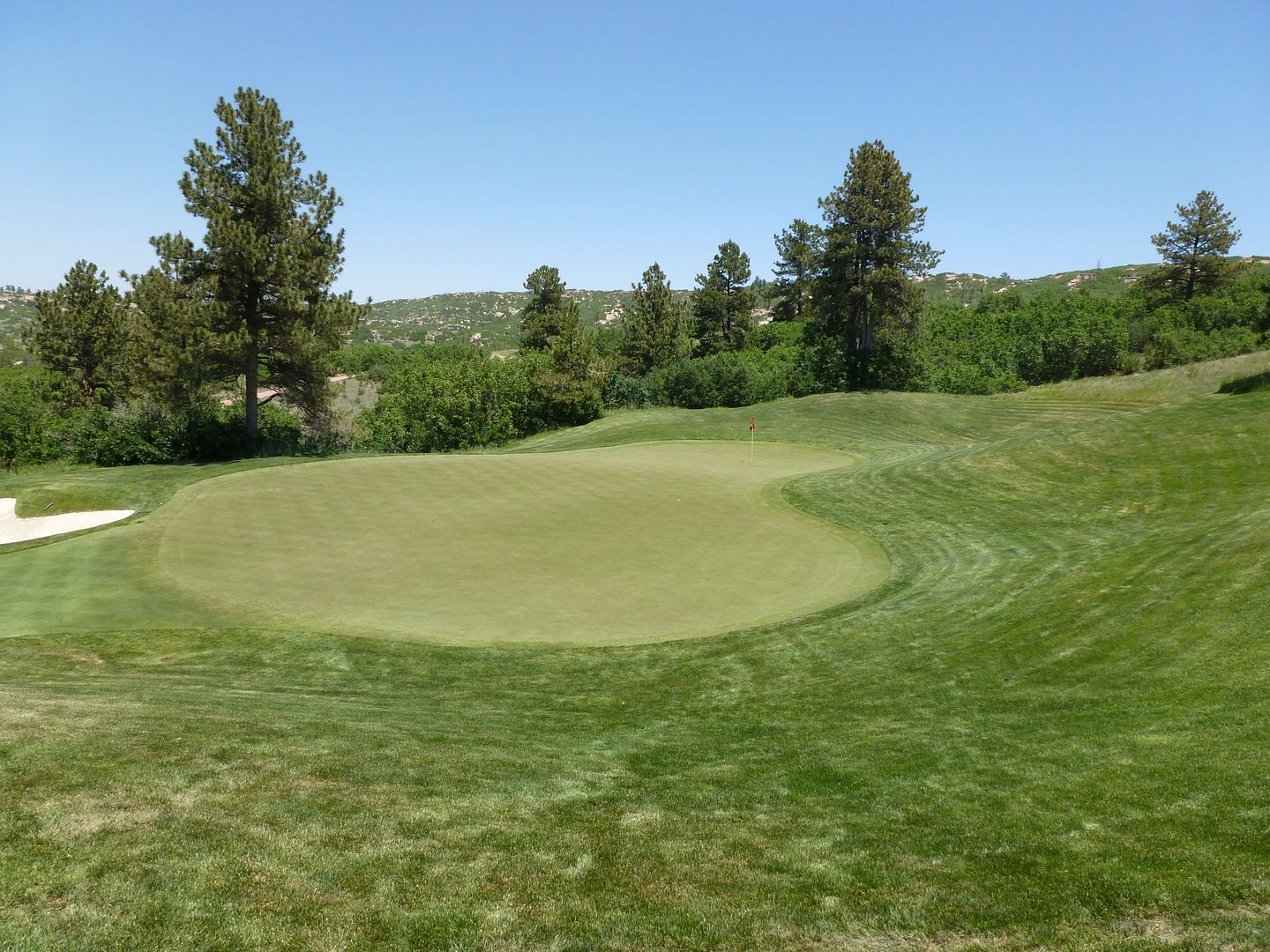 Hole 4: Par 5, 581 YardsAnother tee shot where one can see almost nothing. Get out your yardage book. Bunker is 320 yards from the tee. OK, let's aim at that.
Hole 4: Par 5, 581 YardsAnother tee shot where one can see almost nothing. Get out your yardage book. Bunker is 320 yards from the tee. OK, let's aim at that. 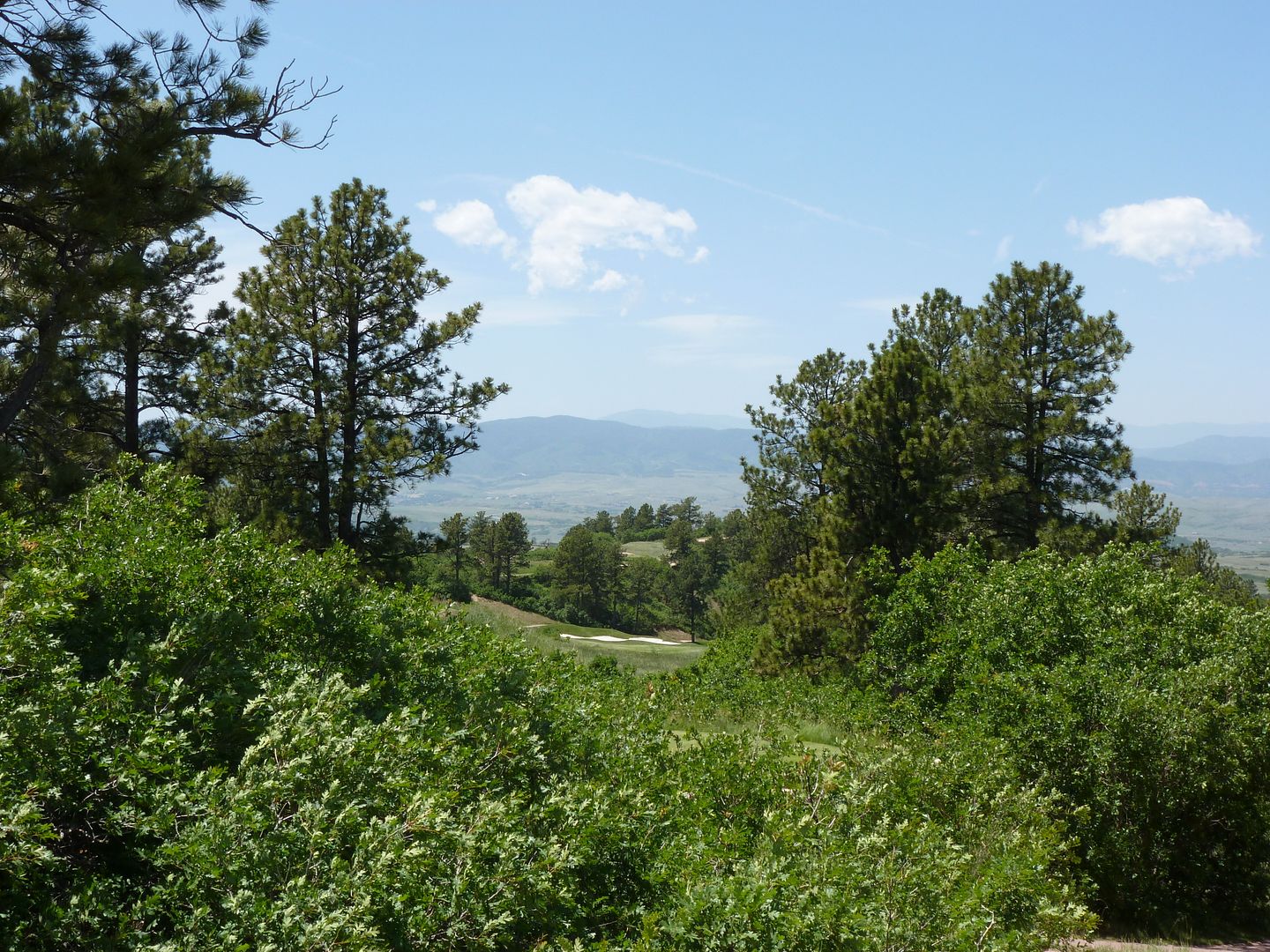 The view from one set of tees forward is very, very different.
The view from one set of tees forward is very, very different. What is clear after playing the hole only once, is that despite the narrowness, one must be sure to place the tee shot accurately on the left side of the fairway. Not pictured is a large tree that stymies any tee shot hit too short or too far to the right.This photo is taken from about 250 yards out and would be an absolutely perfect drive down the left side of the fairway and about 5 yards short of the bunker. From this side of the fairway, the player has three options: 1) Go for it; 2) lay-up short of the first bunker on the right, leaving a clear shot between the trees; 3; get it past the little mound on the right, just short of the end of the fairway. From the right side of the fairway there is but one choice: hope you don't hit the tree that's in your way!
What is clear after playing the hole only once, is that despite the narrowness, one must be sure to place the tee shot accurately on the left side of the fairway. Not pictured is a large tree that stymies any tee shot hit too short or too far to the right.This photo is taken from about 250 yards out and would be an absolutely perfect drive down the left side of the fairway and about 5 yards short of the bunker. From this side of the fairway, the player has three options: 1) Go for it; 2) lay-up short of the first bunker on the right, leaving a clear shot between the trees; 3; get it past the little mound on the right, just short of the end of the fairway. From the right side of the fairway there is but one choice: hope you don't hit the tree that's in your way!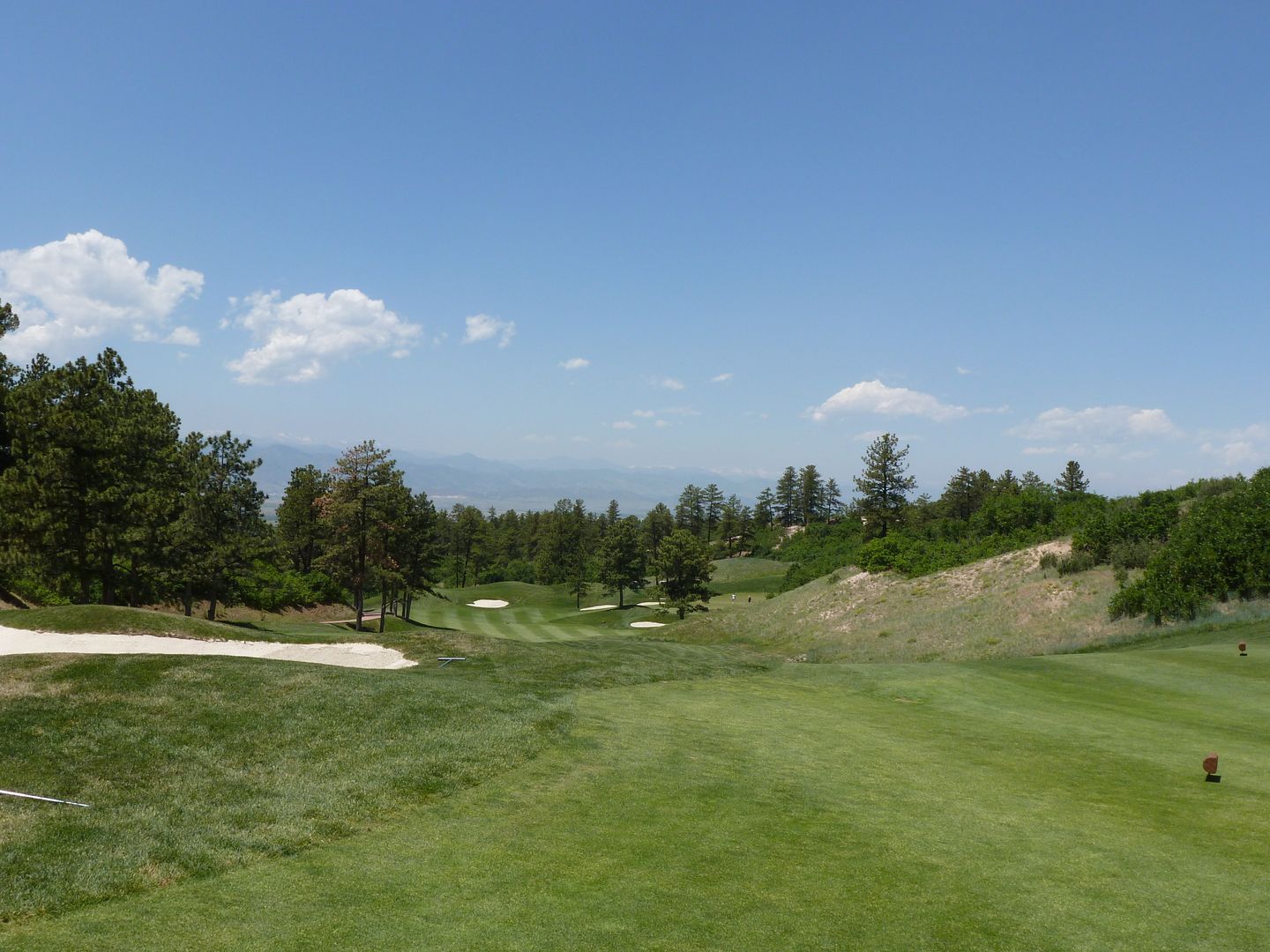
 Hole 5: Par 3, 188 YardsThe first of back-to-back par 3s. Most will be happy to hit the green on this nerve-wracking par 3, but the green is cleverly split in three sections. A ball on the green but in a different section than the pin is almost a guaranteed three putt (my putt from the back of the green almost went off the front edge).
Hole 5: Par 3, 188 YardsThe first of back-to-back par 3s. Most will be happy to hit the green on this nerve-wracking par 3, but the green is cleverly split in three sections. A ball on the green but in a different section than the pin is almost a guaranteed three putt (my putt from the back of the green almost went off the front edge). 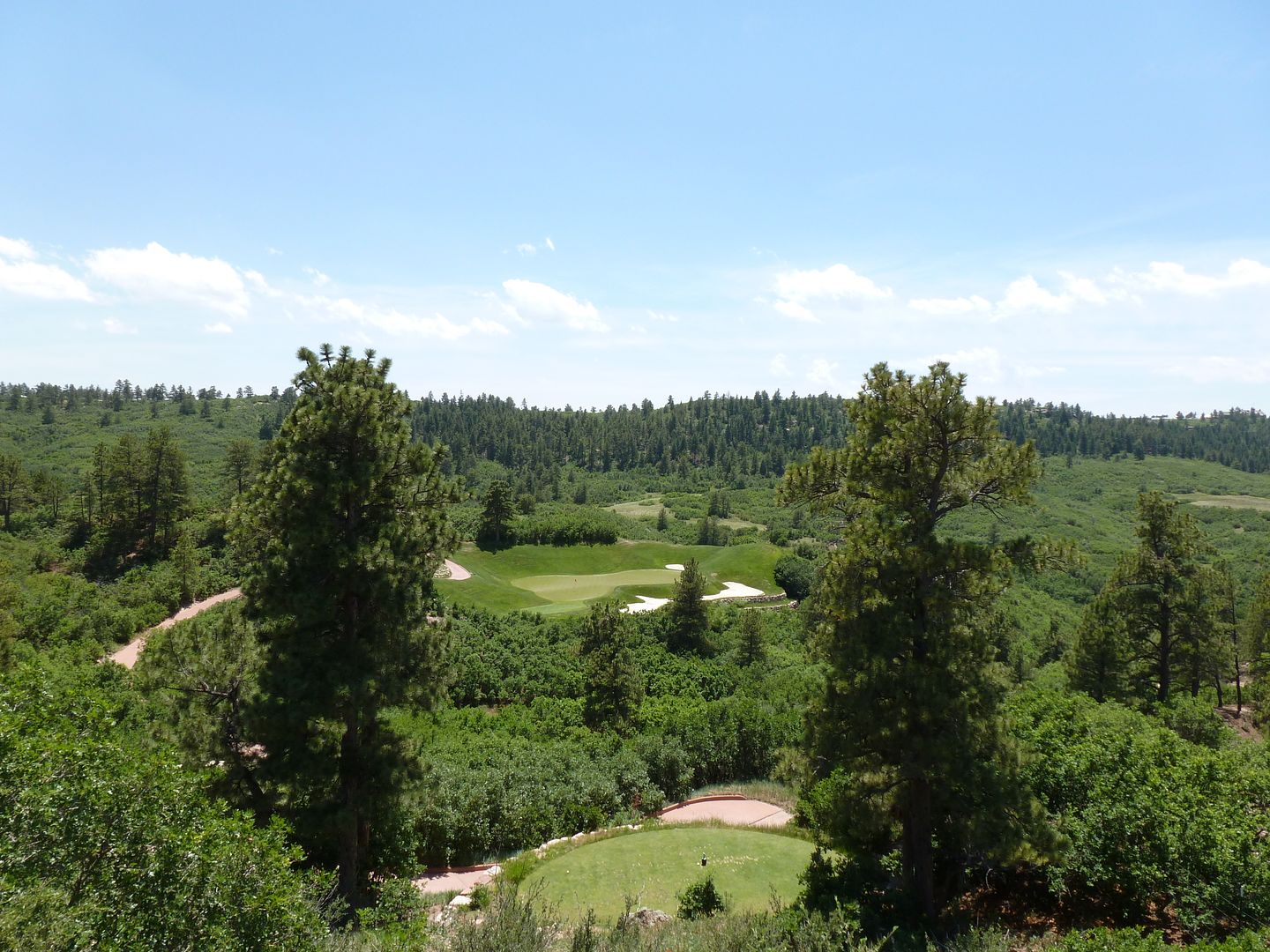 Hole 6: Par 3, 202 YardsNo pictures from the tee, but from the tips the view of the green is very obscured. There are two general teeing areas: from the left, where one plays a semi-blind but flat tee shot to the green; and from the right where the hole plays shorter, but uphill, over the series of bunkers on the right and at a difficult angle given the shape of the green.The pin on the day I played it was in a very cool little bowl at the back of the green that could be reached either by running a shot up the middle of the green or using the embankment long of the pin to bring it back.
Hole 6: Par 3, 202 YardsNo pictures from the tee, but from the tips the view of the green is very obscured. There are two general teeing areas: from the left, where one plays a semi-blind but flat tee shot to the green; and from the right where the hole plays shorter, but uphill, over the series of bunkers on the right and at a difficult angle given the shape of the green.The pin on the day I played it was in a very cool little bowl at the back of the green that could be reached either by running a shot up the middle of the green or using the embankment long of the pin to bring it back. Hole 7: Par 4, 400 YardsAnother hole where the view from the tips gives only a glimpse of fairway, but the view from the one ups is very clear. Being on the left side of the fairway is very important for a right or back-right pin, but for the pin I played, anything in the fairway works fine.The green (as always, not done justice by pictures) is one of the coolest I have seen. There are so many undulations and they are so severe that one could spend hours putting on that green and not get bored.
Hole 7: Par 4, 400 YardsAnother hole where the view from the tips gives only a glimpse of fairway, but the view from the one ups is very clear. Being on the left side of the fairway is very important for a right or back-right pin, but for the pin I played, anything in the fairway works fine.The green (as always, not done justice by pictures) is one of the coolest I have seen. There are so many undulations and they are so severe that one could spend hours putting on that green and not get bored.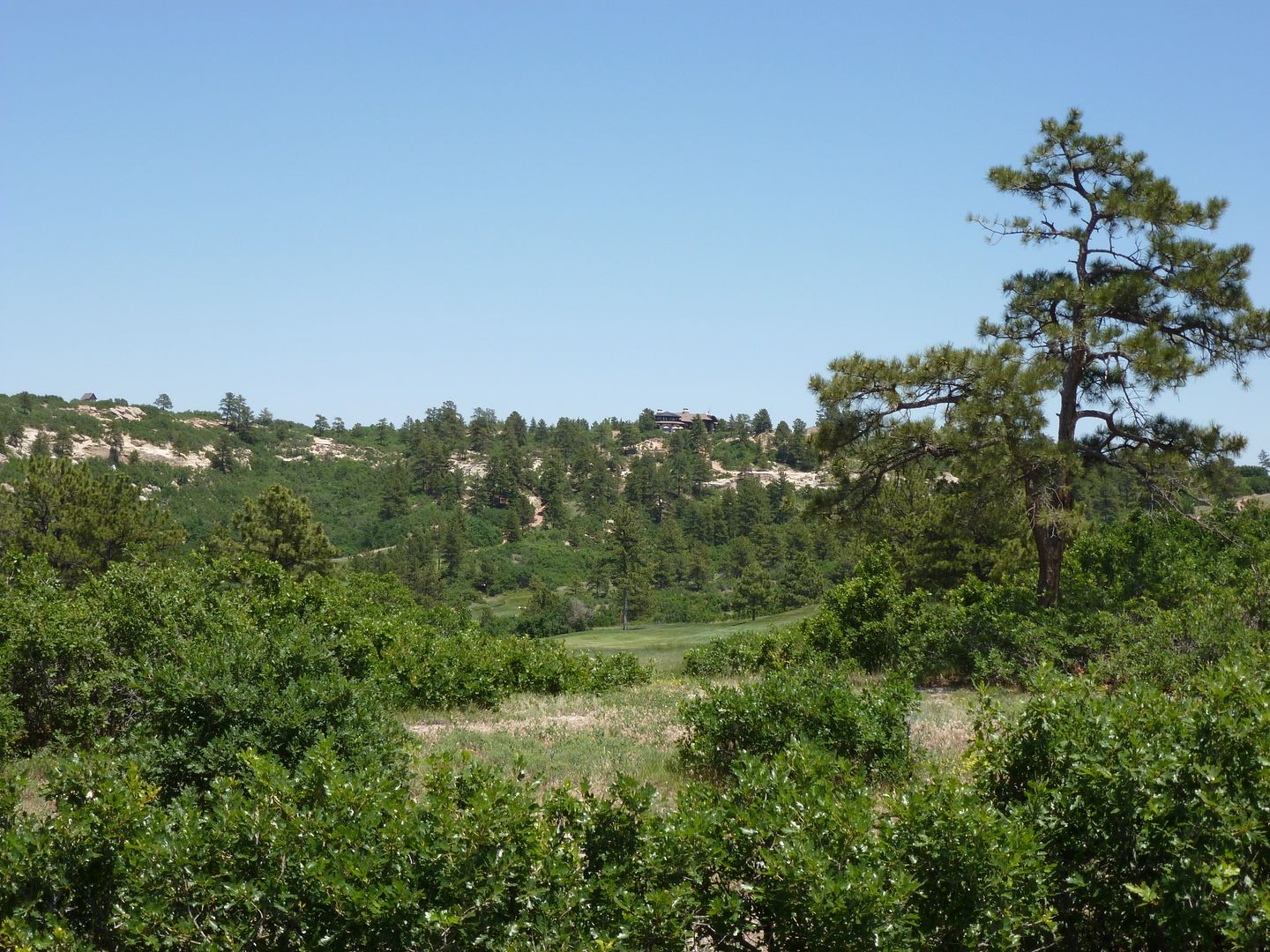
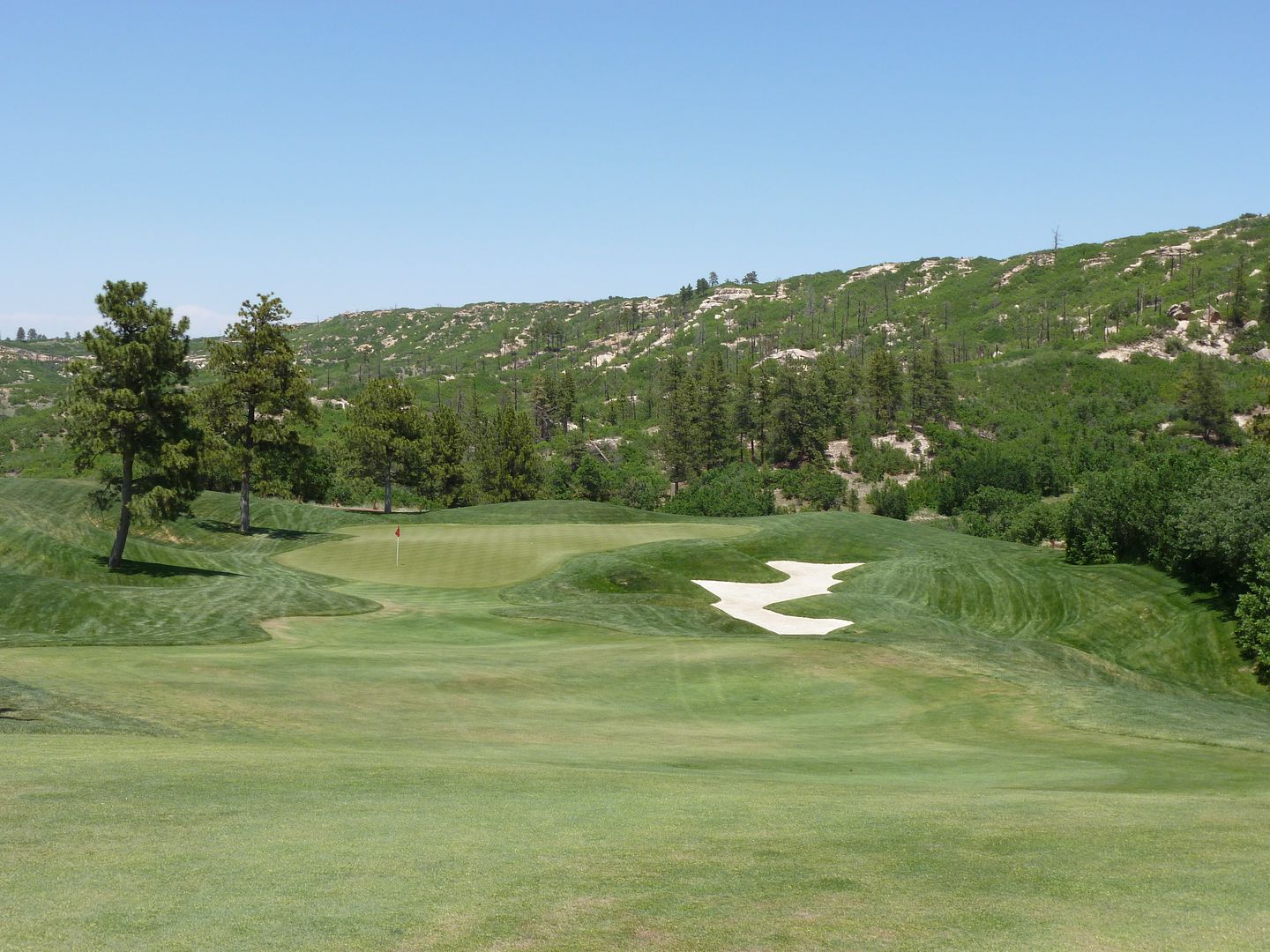 Hole 8: Par 4, 380 YardsAlong with number 18 at Sanctuary, one of the most dramatically uphill holes I have ever played. At about 230 yards from the tee, there is an outcropping of rock/fescue that impact play. It is 250 yards over the outcropping and given the uphill nature of the hole, few players will be able to make this carry (though it should be noted that the one up tees are about 60 yards shorter on this hole making the carry doable for many players).
Hole 8: Par 4, 380 YardsAlong with number 18 at Sanctuary, one of the most dramatically uphill holes I have ever played. At about 230 yards from the tee, there is an outcropping of rock/fescue that impact play. It is 250 yards over the outcropping and given the uphill nature of the hole, few players will be able to make this carry (though it should be noted that the one up tees are about 60 yards shorter on this hole making the carry doable for many players).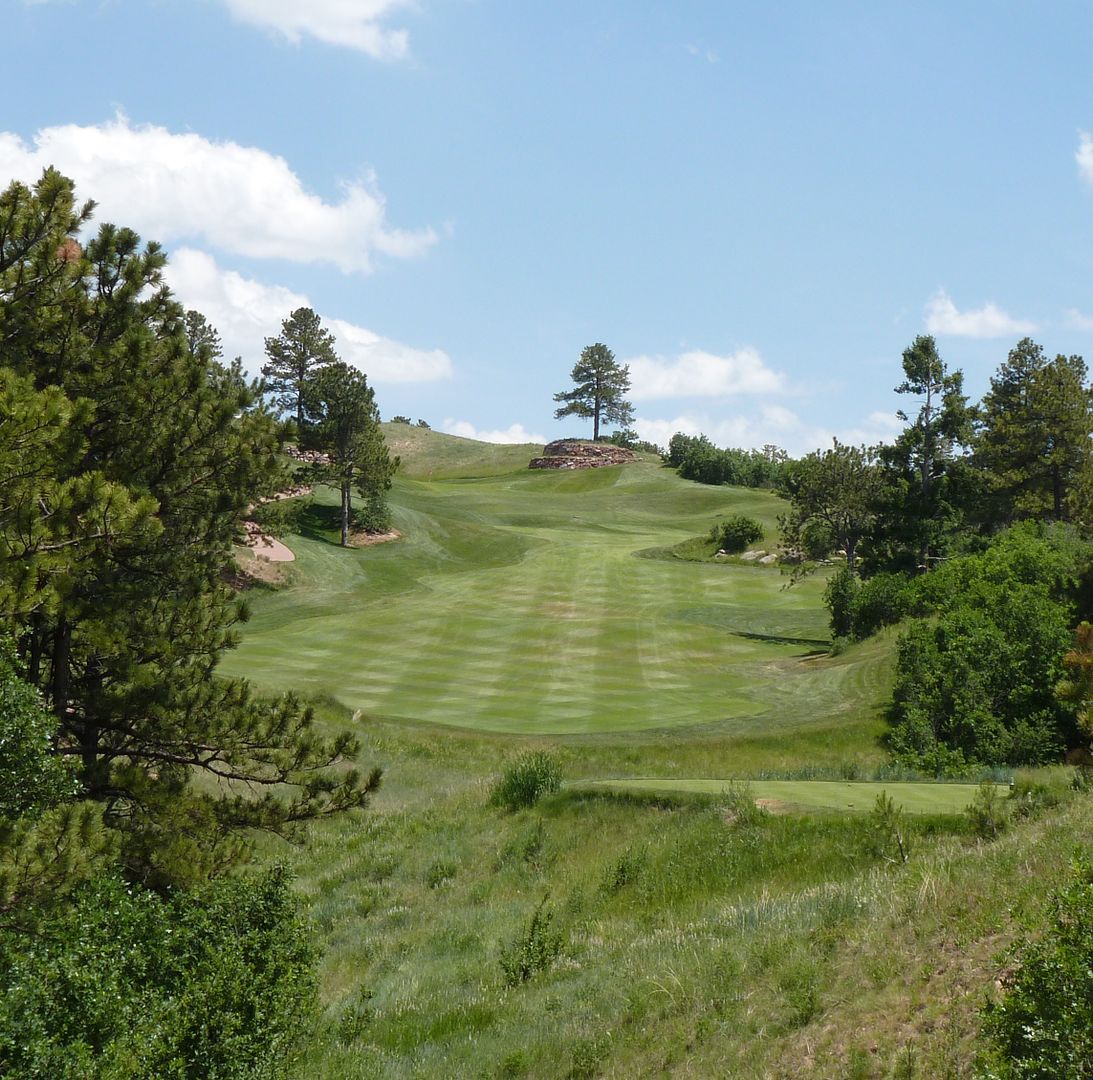 The fun isn't over once you find the fairway, this is one unbelievable green! Relatively flat up top, but with a severe slope at the front (I don't know what to call it - maybe a false front?). I think you could actually get a pin at the front there, which would be a lot of fun.
The fun isn't over once you find the fairway, this is one unbelievable green! Relatively flat up top, but with a severe slope at the front (I don't know what to call it - maybe a false front?). I think you could actually get a pin at the front there, which would be a lot of fun.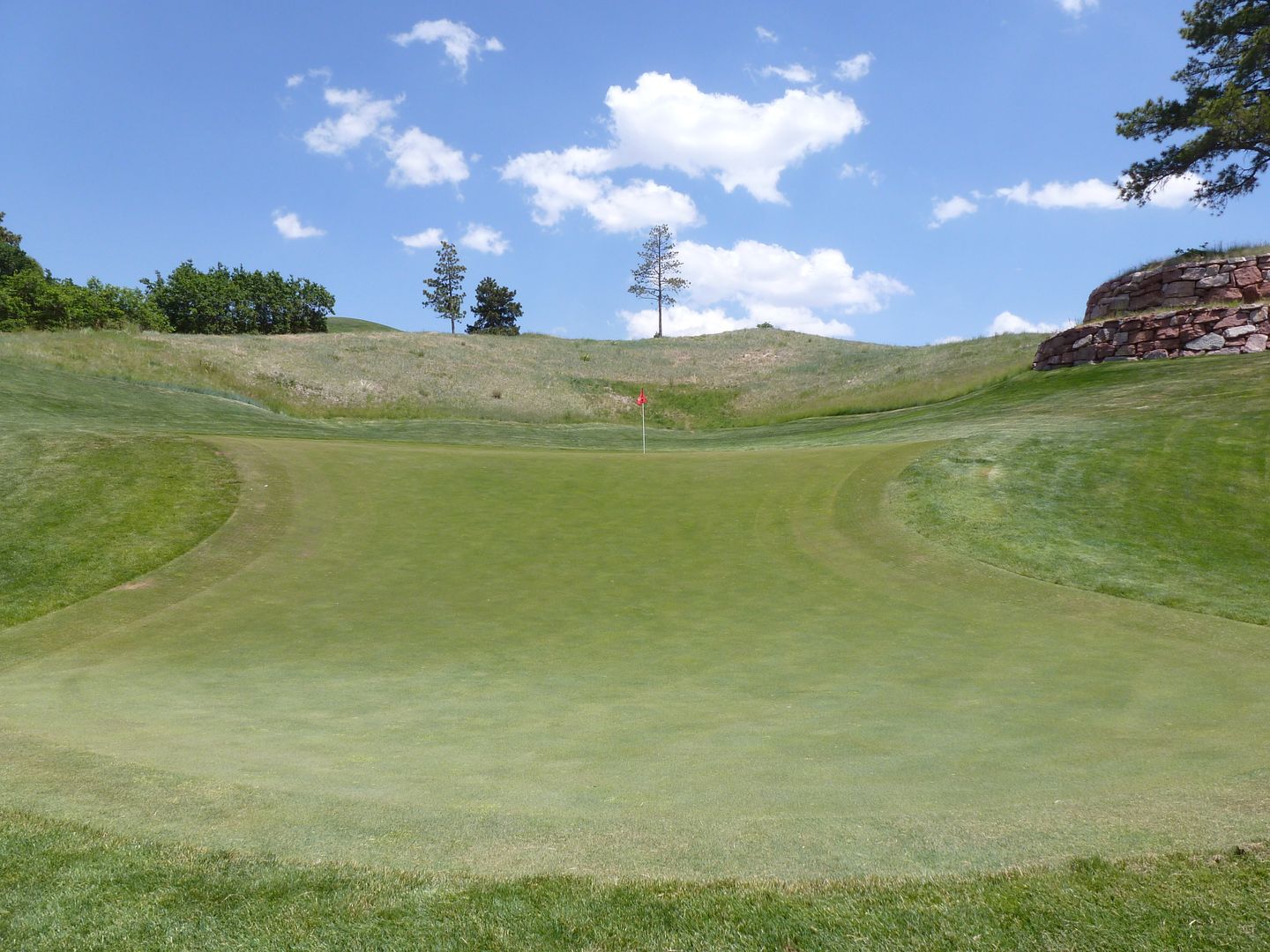
 Hole 9: Par 4, 329 Yards
Hole 9: Par 4, 329 Yards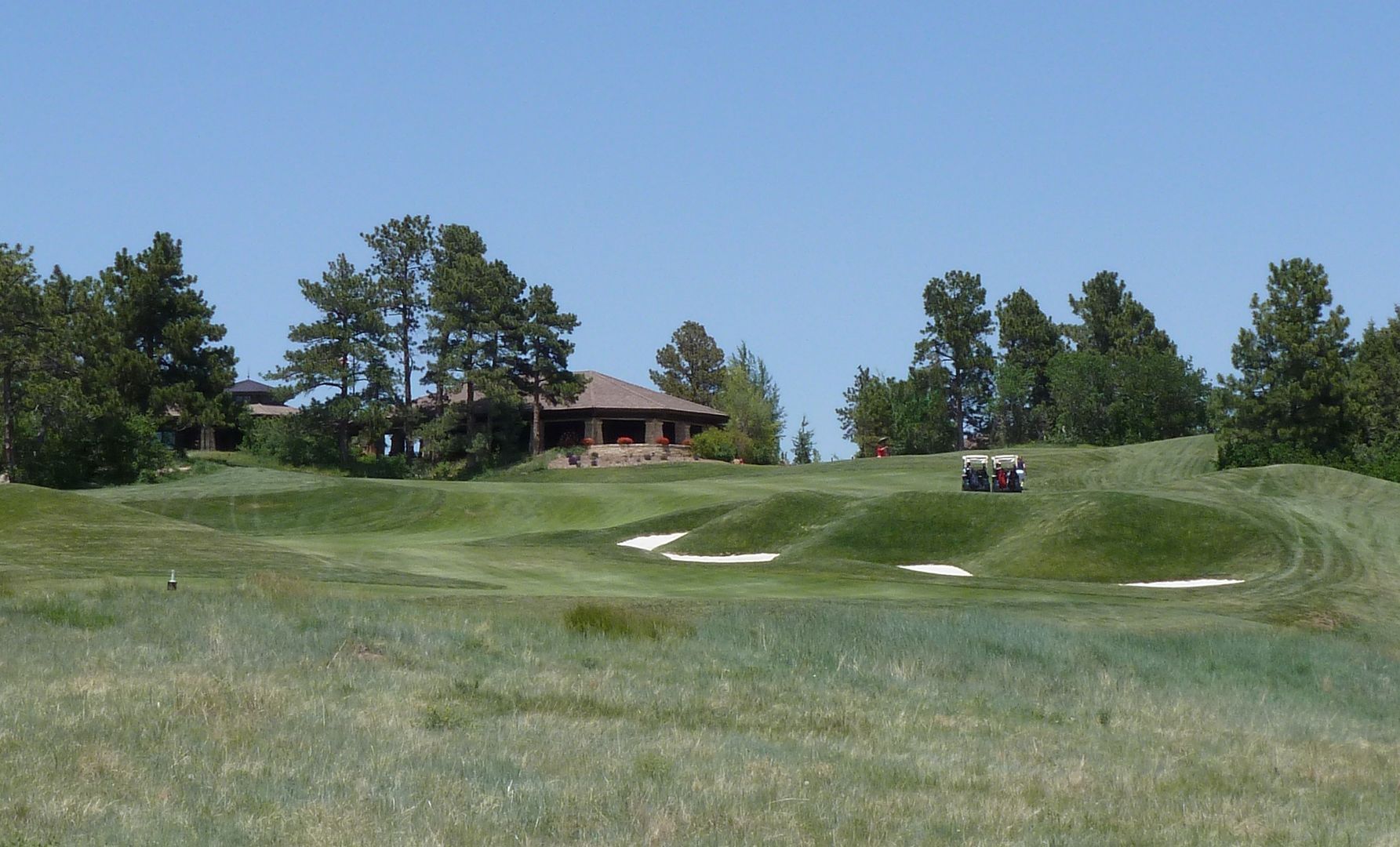 Hole 10: Par 3, 200 Yards
Hole 10: Par 3, 200 Yards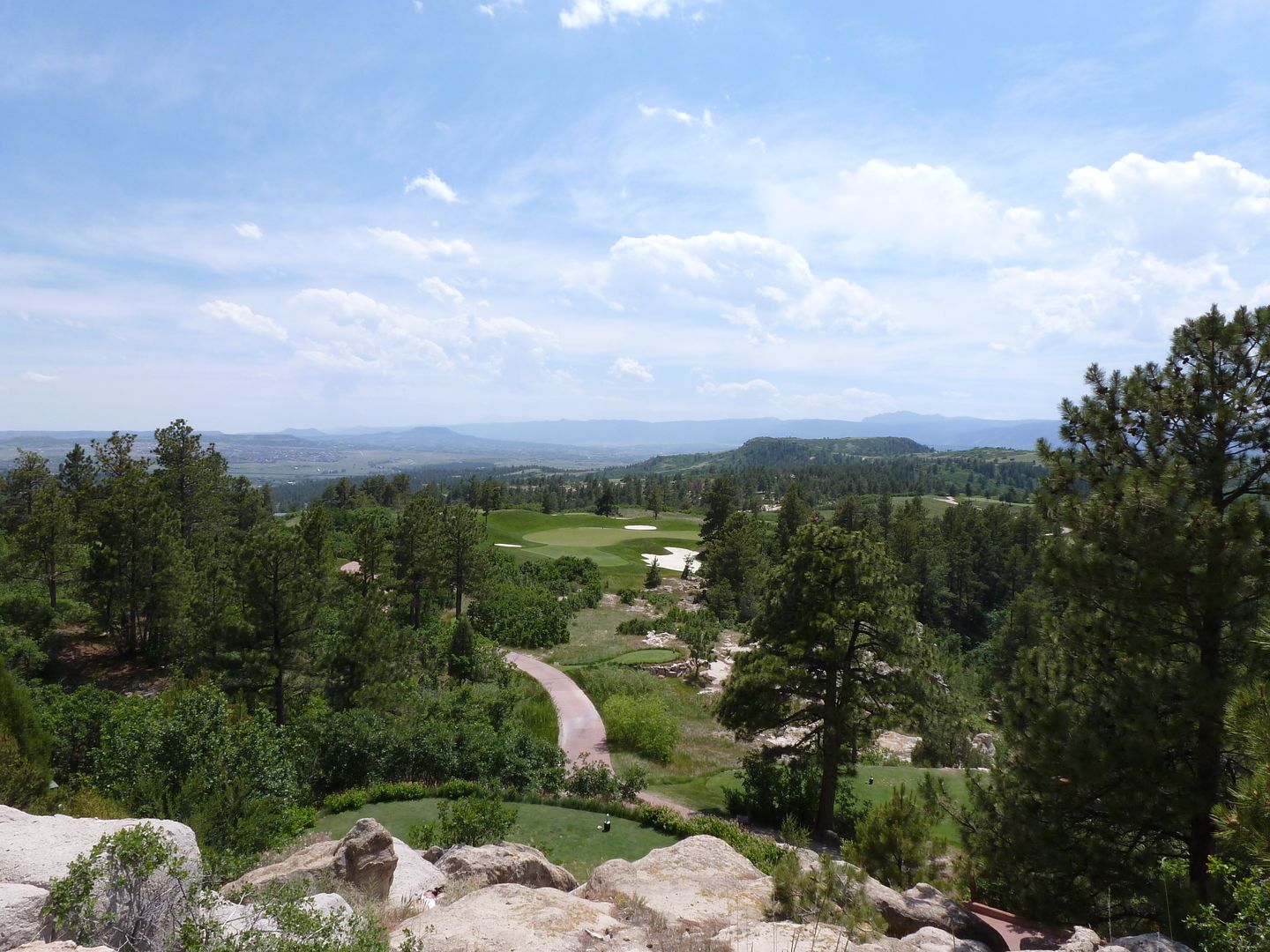 Hole 12: Par 4, 400 YardsAnother tee shot that is basically blind. Get out the Skycaddie and check the yardage to those visible slices of fairway. This hole is probably easier on repeated plays as there is actually plenty of room in the fairway and only a slight advantage to challenging the carry on the right.The approach is unusual, over a series of small (and a couple not so small) trees. You are kind of at the mercy of the golfing gods as to whether or not a tree will block your view of the pin/green.
Hole 12: Par 4, 400 YardsAnother tee shot that is basically blind. Get out the Skycaddie and check the yardage to those visible slices of fairway. This hole is probably easier on repeated plays as there is actually plenty of room in the fairway and only a slight advantage to challenging the carry on the right.The approach is unusual, over a series of small (and a couple not so small) trees. You are kind of at the mercy of the golfing gods as to whether or not a tree will block your view of the pin/green.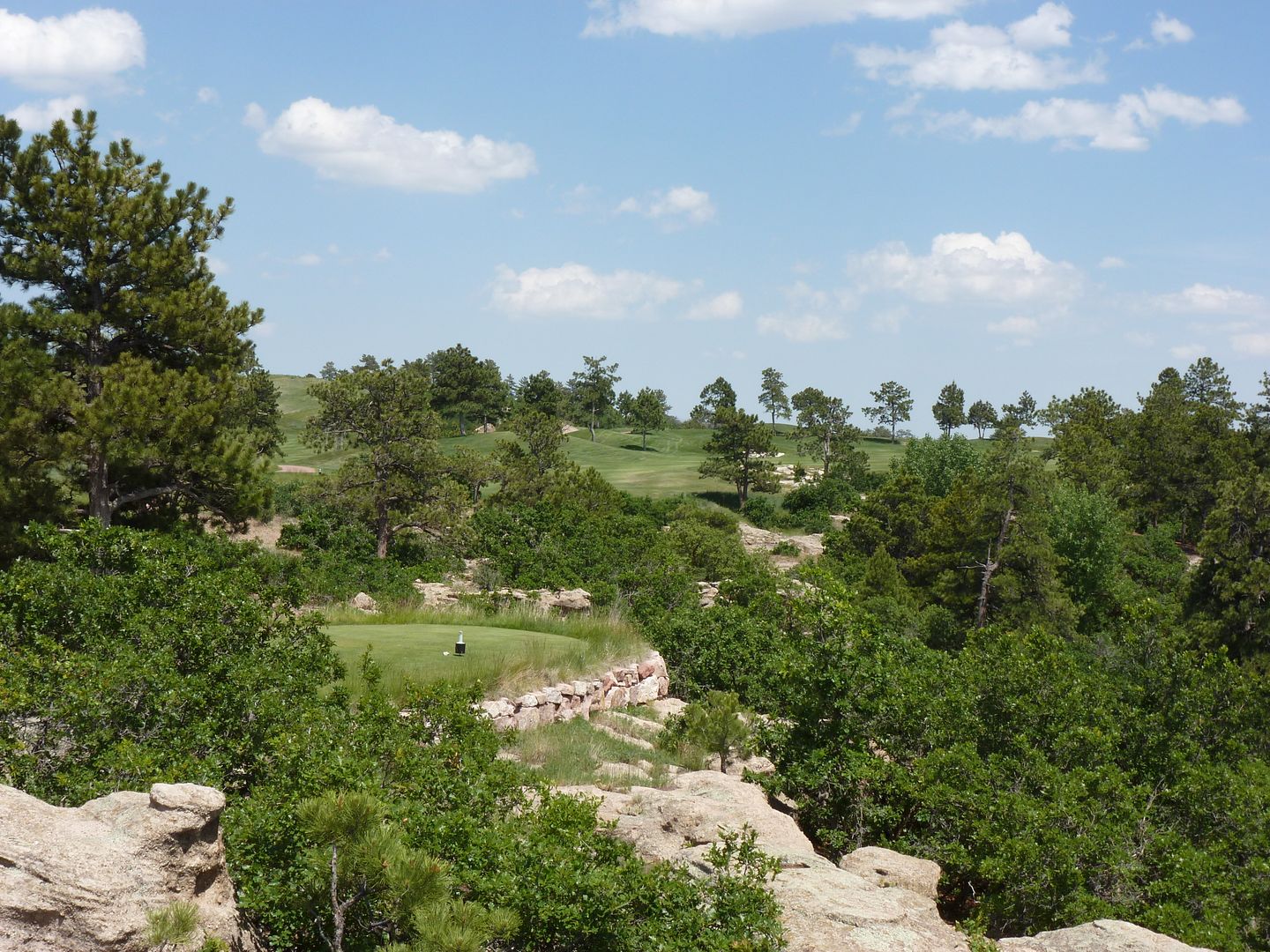 Hole 13: Par 4, 393 YardsAnother visually intimidating tee shot, that is much less intimidating from one tee up. From the tee all that can be seen is a bit of fairway and a bunker. There is actually a lot of room to miss to the right. The pin location really dictates how aggressive one need be with the shot as a back right pin really must be attacked from the left with a short iron. A left pin can be challenged from anywhere.Despite its length, this hole at Denver elevation and with the large drop from the tee, could likely be reached in one by some. Longer hitters must take care not to hit their tee shots through the fairway into the water.
Hole 13: Par 4, 393 YardsAnother visually intimidating tee shot, that is much less intimidating from one tee up. From the tee all that can be seen is a bit of fairway and a bunker. There is actually a lot of room to miss to the right. The pin location really dictates how aggressive one need be with the shot as a back right pin really must be attacked from the left with a short iron. A left pin can be challenged from anywhere.Despite its length, this hole at Denver elevation and with the large drop from the tee, could likely be reached in one by some. Longer hitters must take care not to hit their tee shots through the fairway into the water.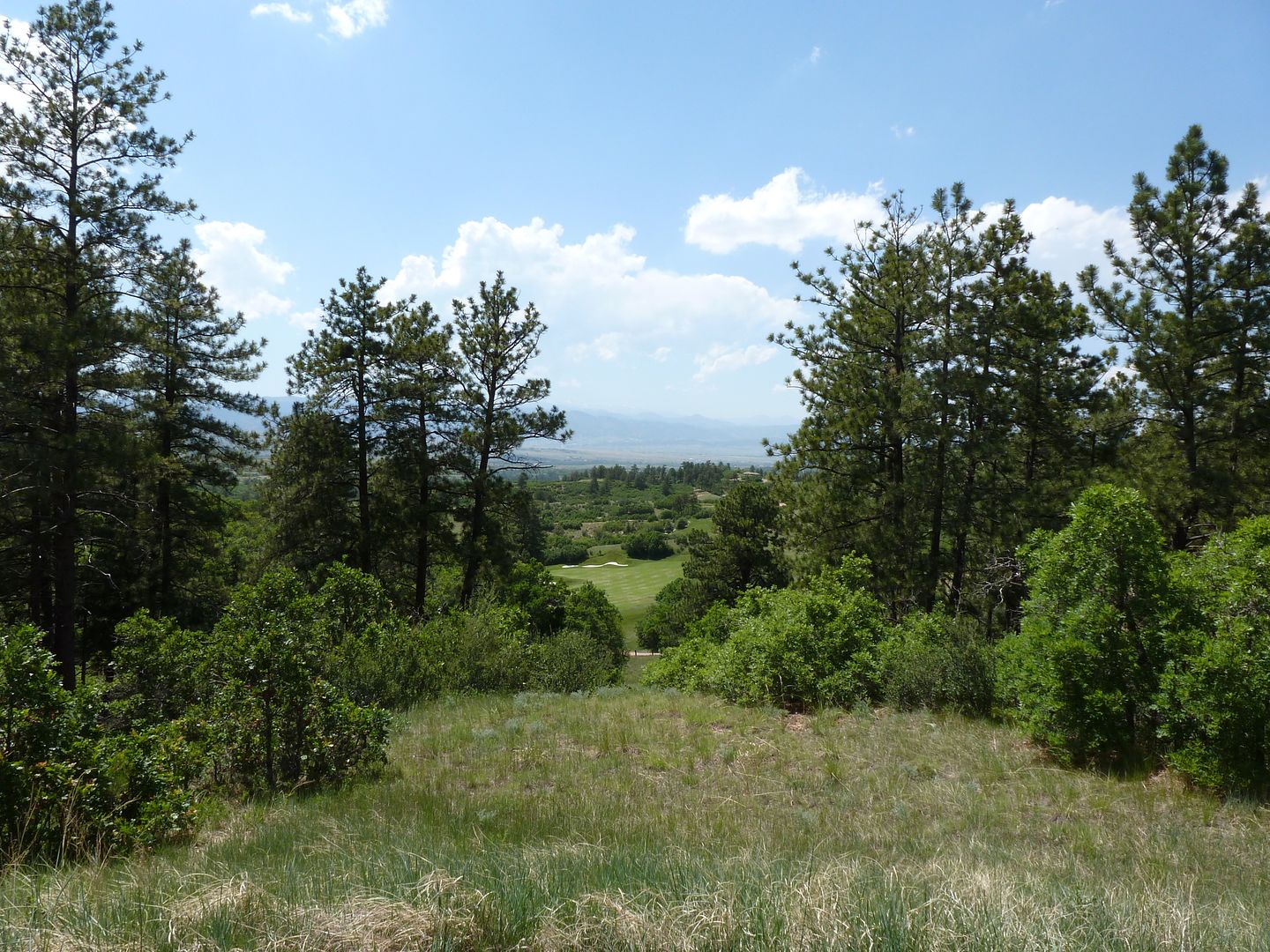
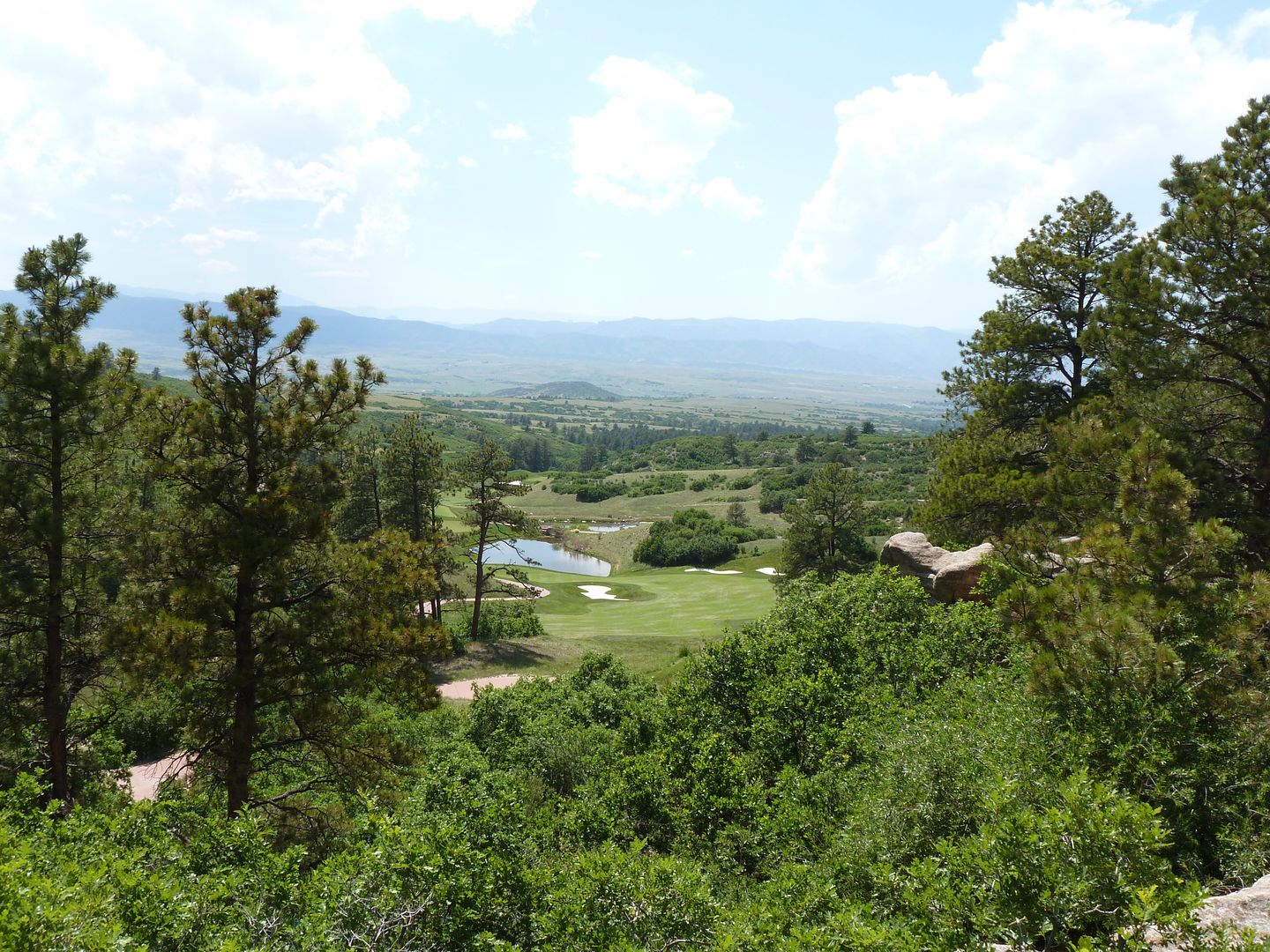
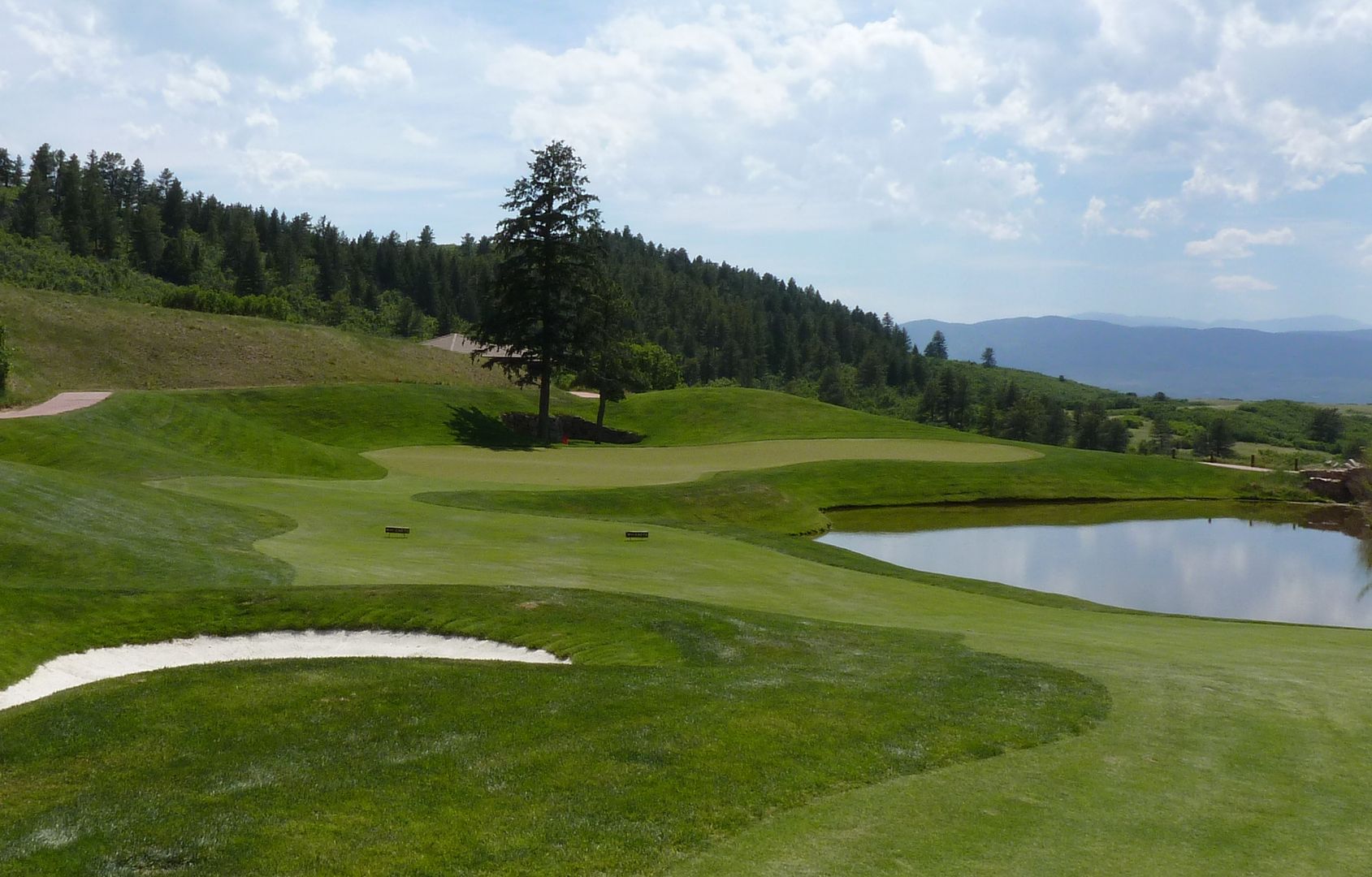 Hole 14: Par 3, 173 YardsUnlike many holes with waterfalls, this one is actually a very good golf hole. While most will just try to avoid the water, this uniquely shaped green has many severe internal contours. Merely hitting the green in regulation in no way guarantees a par. I especially liked that the back right pin (pictured), while a long way from the water, is arguably the second most difficult pin location on the green (left pin is probably the hardest). The pin sits on a very small plateau that can only be reached with a perfectly struck shot. Any shot to the middle of the green leaves a difficult two-putt.
Hole 14: Par 3, 173 YardsUnlike many holes with waterfalls, this one is actually a very good golf hole. While most will just try to avoid the water, this uniquely shaped green has many severe internal contours. Merely hitting the green in regulation in no way guarantees a par. I especially liked that the back right pin (pictured), while a long way from the water, is arguably the second most difficult pin location on the green (left pin is probably the hardest). The pin sits on a very small plateau that can only be reached with a perfectly struck shot. Any shot to the middle of the green leaves a difficult two-putt.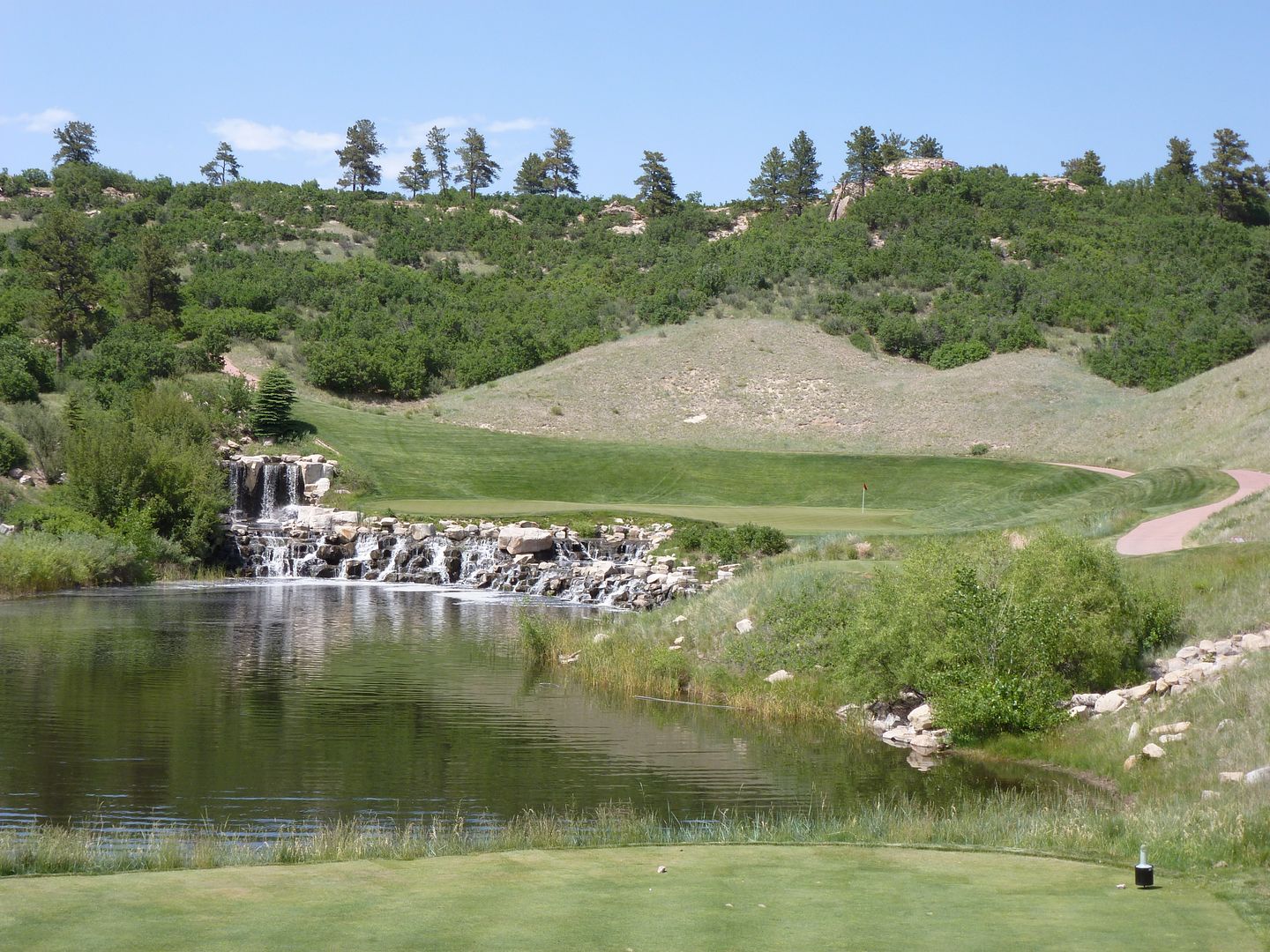 Hole 15: Par 5, 613 YardsMuch like the other par 5s at Sanctuary a dramatic downhill tee shot on this par 5. It's about 330 yards to the bunkers straightaway, but if possible, one really wants to get it out there over 300 yards to get a clear view for the second shot. Otherwise, one is left with an awkward semi-blind lay-up shot that cuts over the edge of a hill.Again, pin location dictates the ideal lay-up location. A right pin is difficult to attack as it is difficult to lay-up in the right side of the fairway.Another very fun green, those ridges are very substantial!
Hole 15: Par 5, 613 YardsMuch like the other par 5s at Sanctuary a dramatic downhill tee shot on this par 5. It's about 330 yards to the bunkers straightaway, but if possible, one really wants to get it out there over 300 yards to get a clear view for the second shot. Otherwise, one is left with an awkward semi-blind lay-up shot that cuts over the edge of a hill.Again, pin location dictates the ideal lay-up location. A right pin is difficult to attack as it is difficult to lay-up in the right side of the fairway.Another very fun green, those ridges are very substantial!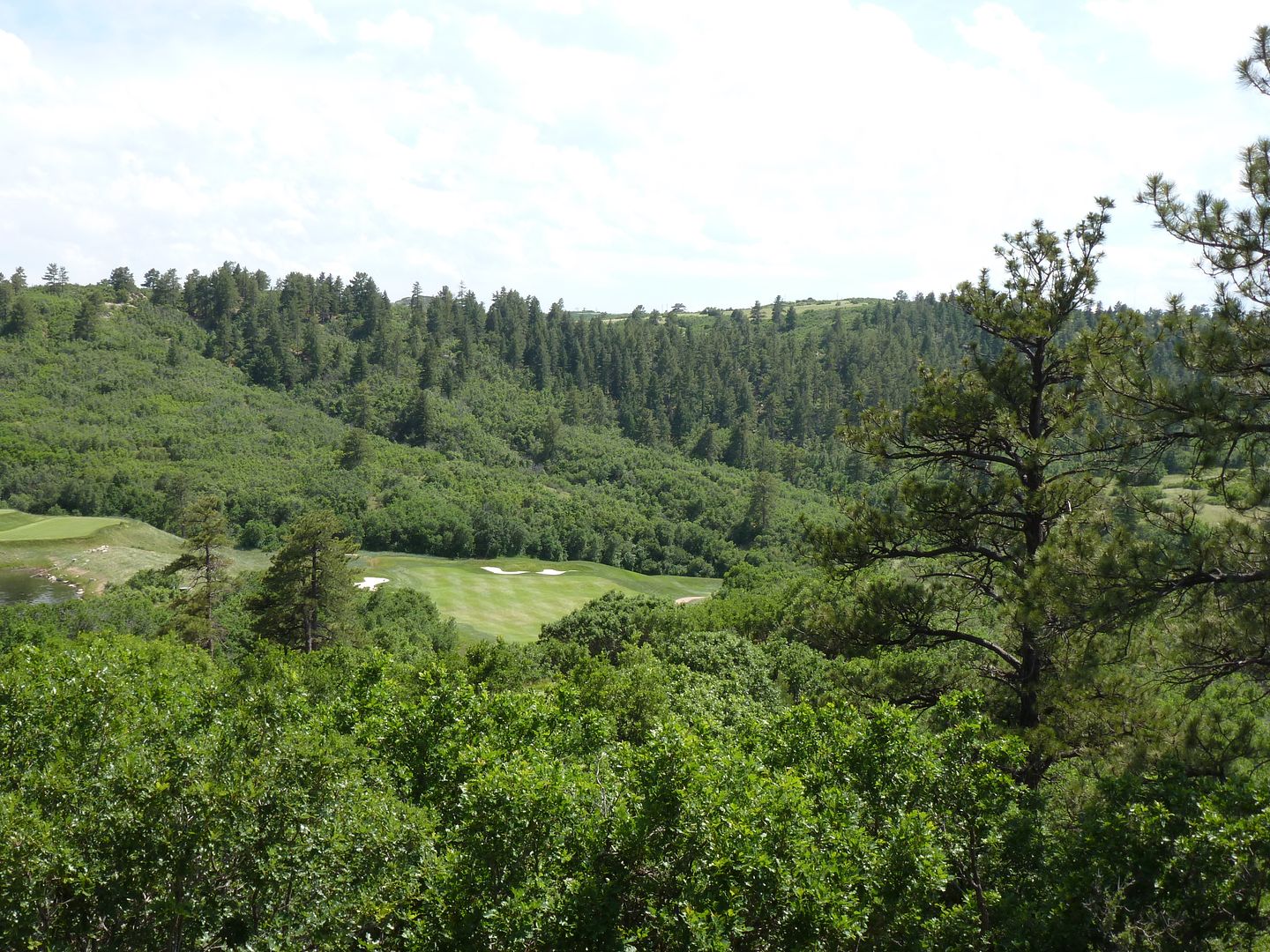
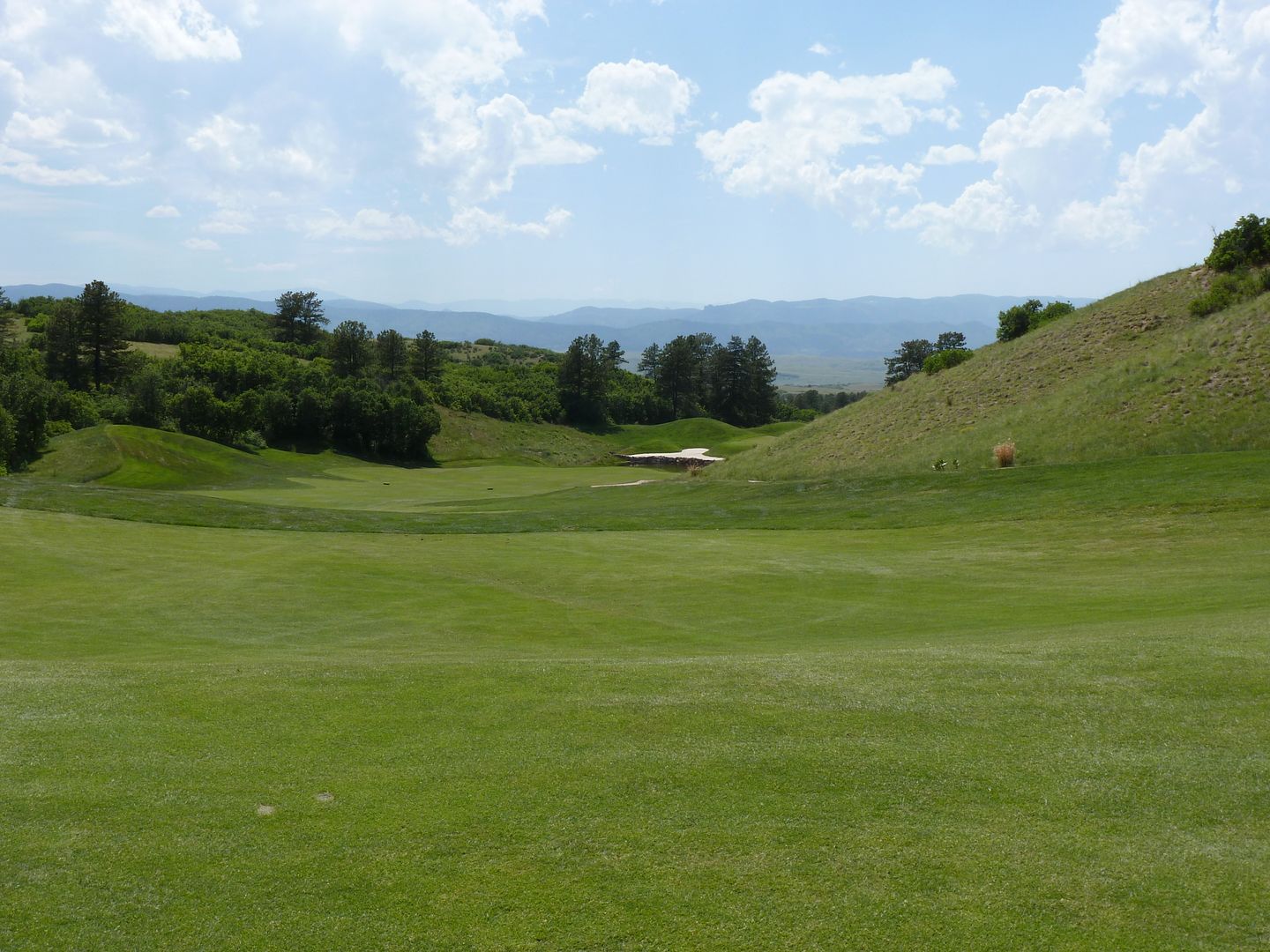
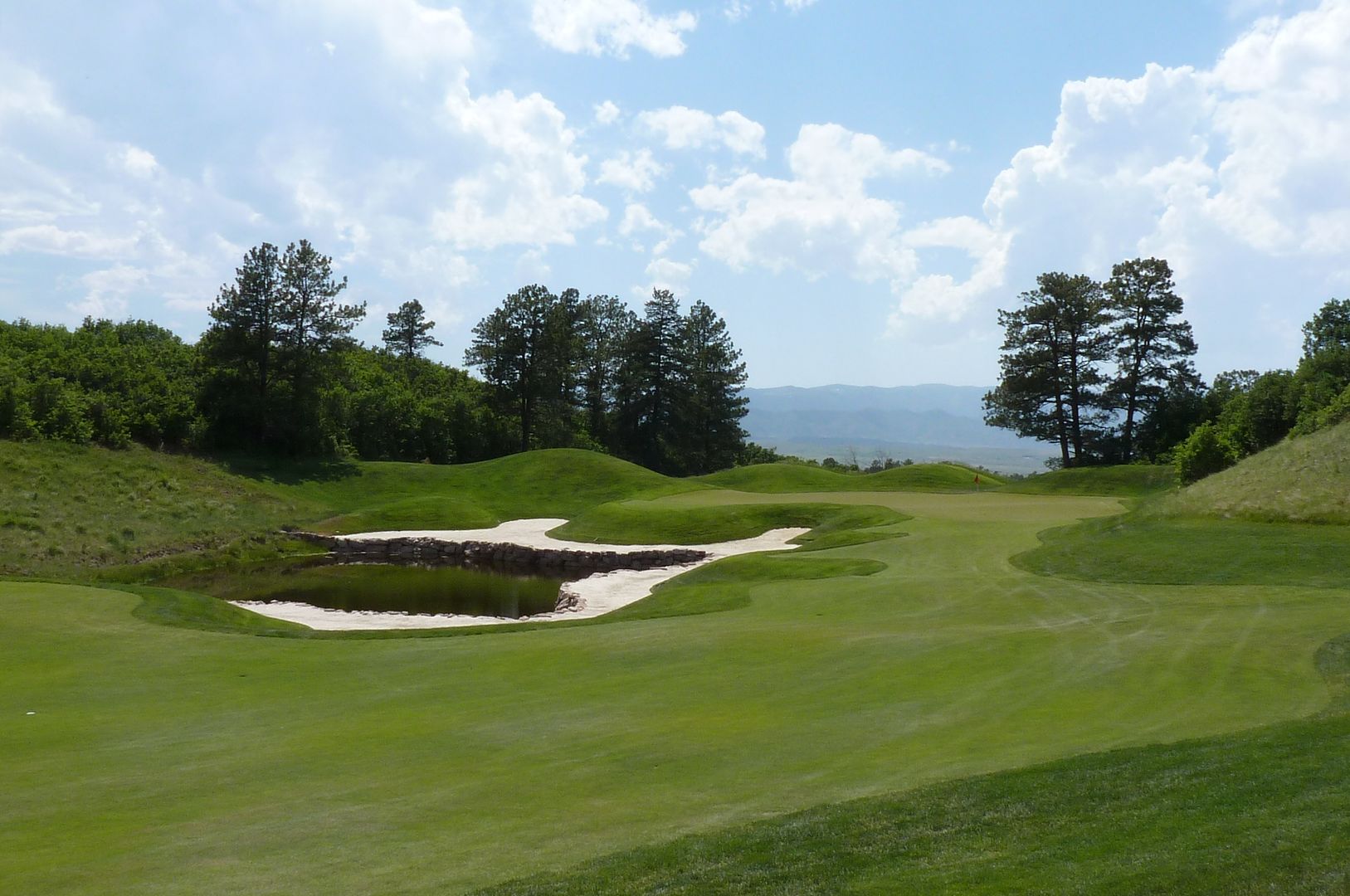
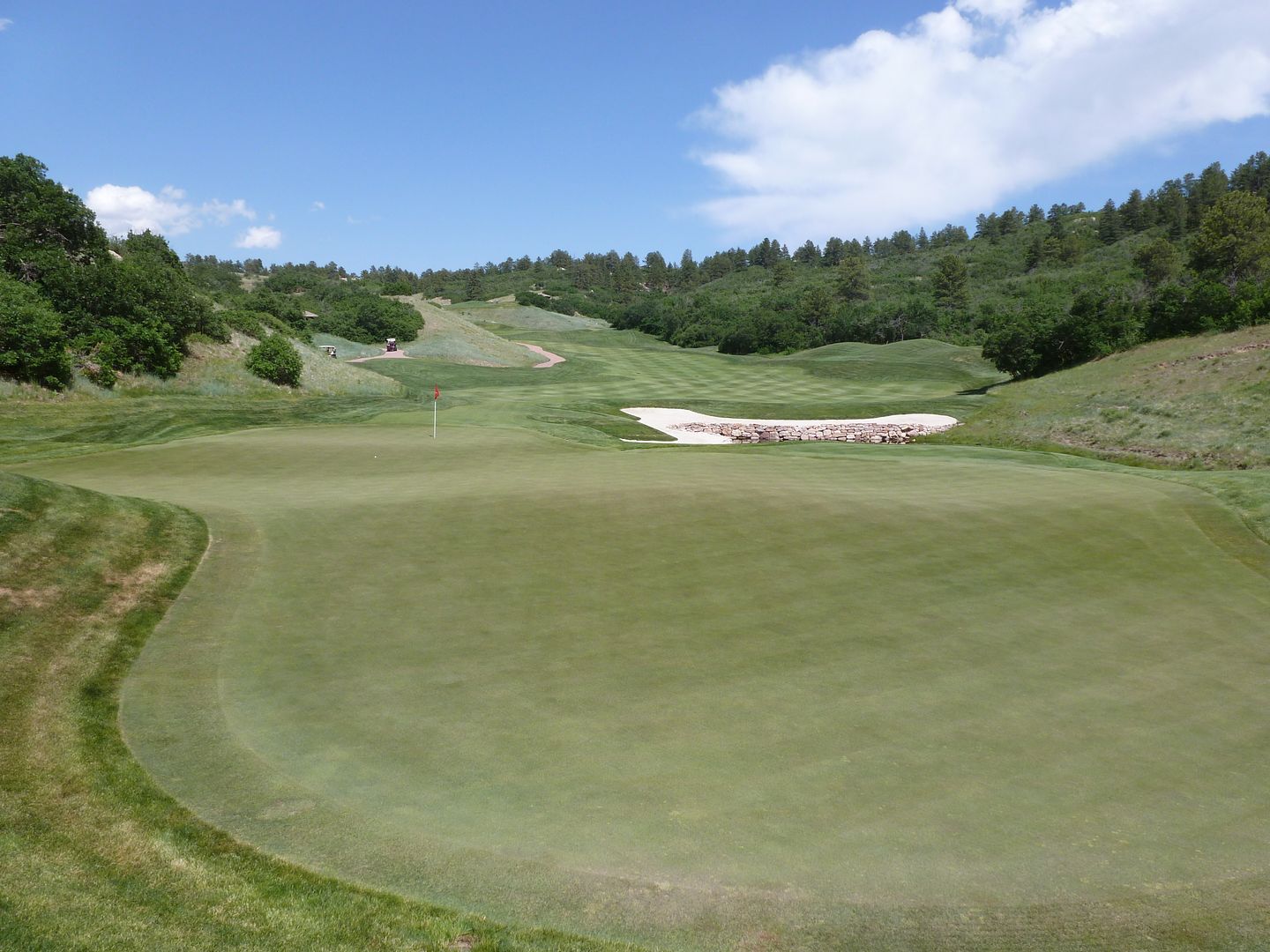 Hole 16: Par 4, 317 YardsThis hole may be driveable for some (though I doubt it) as it plays substantially uphill. The back two sets of tees are basically the same length, but the first two pictures give an idea of the difference in view from the two sets of tees.Challenging the left side off the tee rewards the player with the clearest view of the pin and an approach that does not need to carry the army of bunkers short right of the green.Curiously, this is one of the simplest and flattest greens on the course. Given that the player will be coming in with nothing more than wedge, I am not sure why this green was designed in this manner.
Hole 16: Par 4, 317 YardsThis hole may be driveable for some (though I doubt it) as it plays substantially uphill. The back two sets of tees are basically the same length, but the first two pictures give an idea of the difference in view from the two sets of tees.Challenging the left side off the tee rewards the player with the clearest view of the pin and an approach that does not need to carry the army of bunkers short right of the green.Curiously, this is one of the simplest and flattest greens on the course. Given that the player will be coming in with nothing more than wedge, I am not sure why this green was designed in this manner.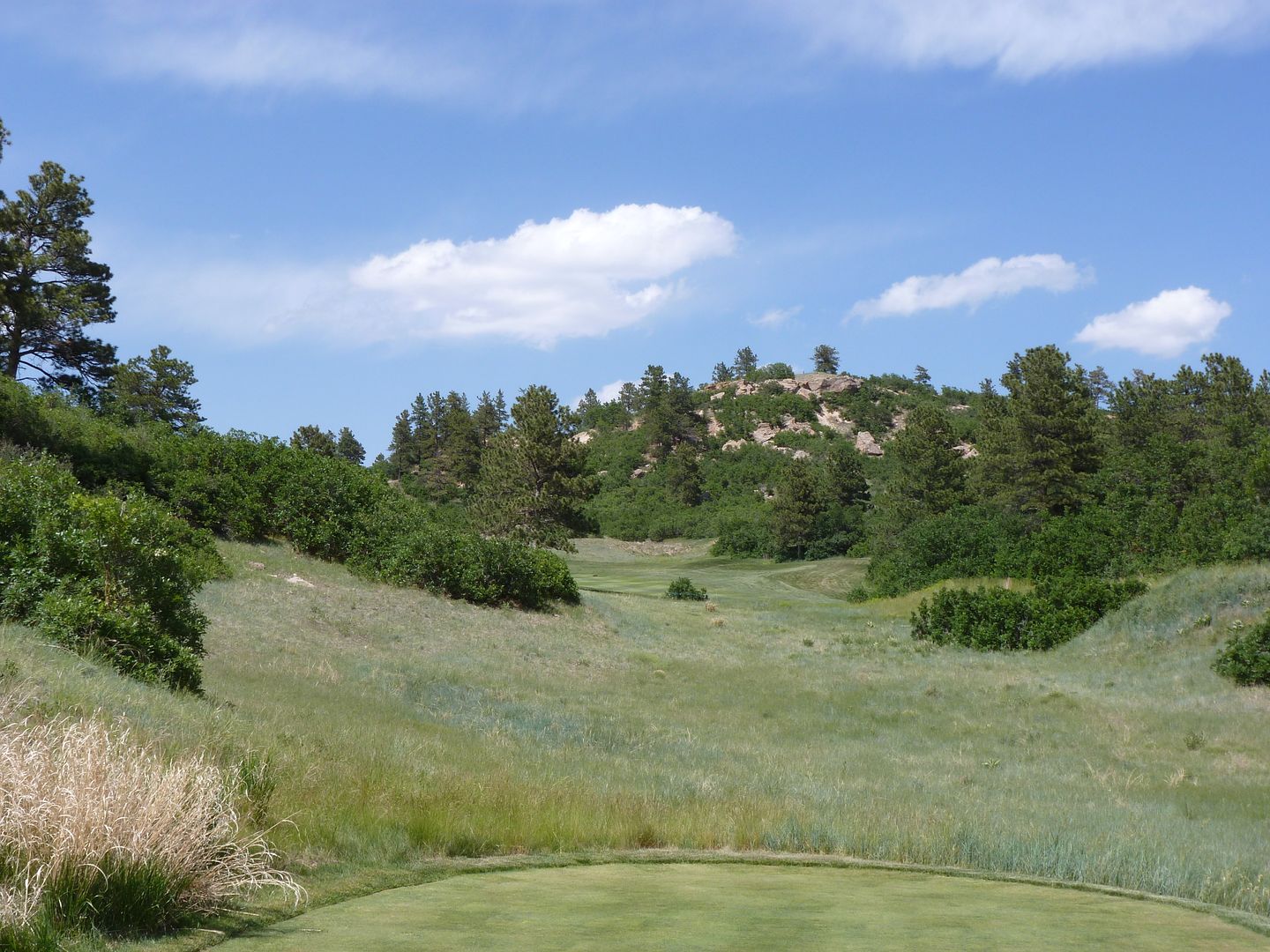
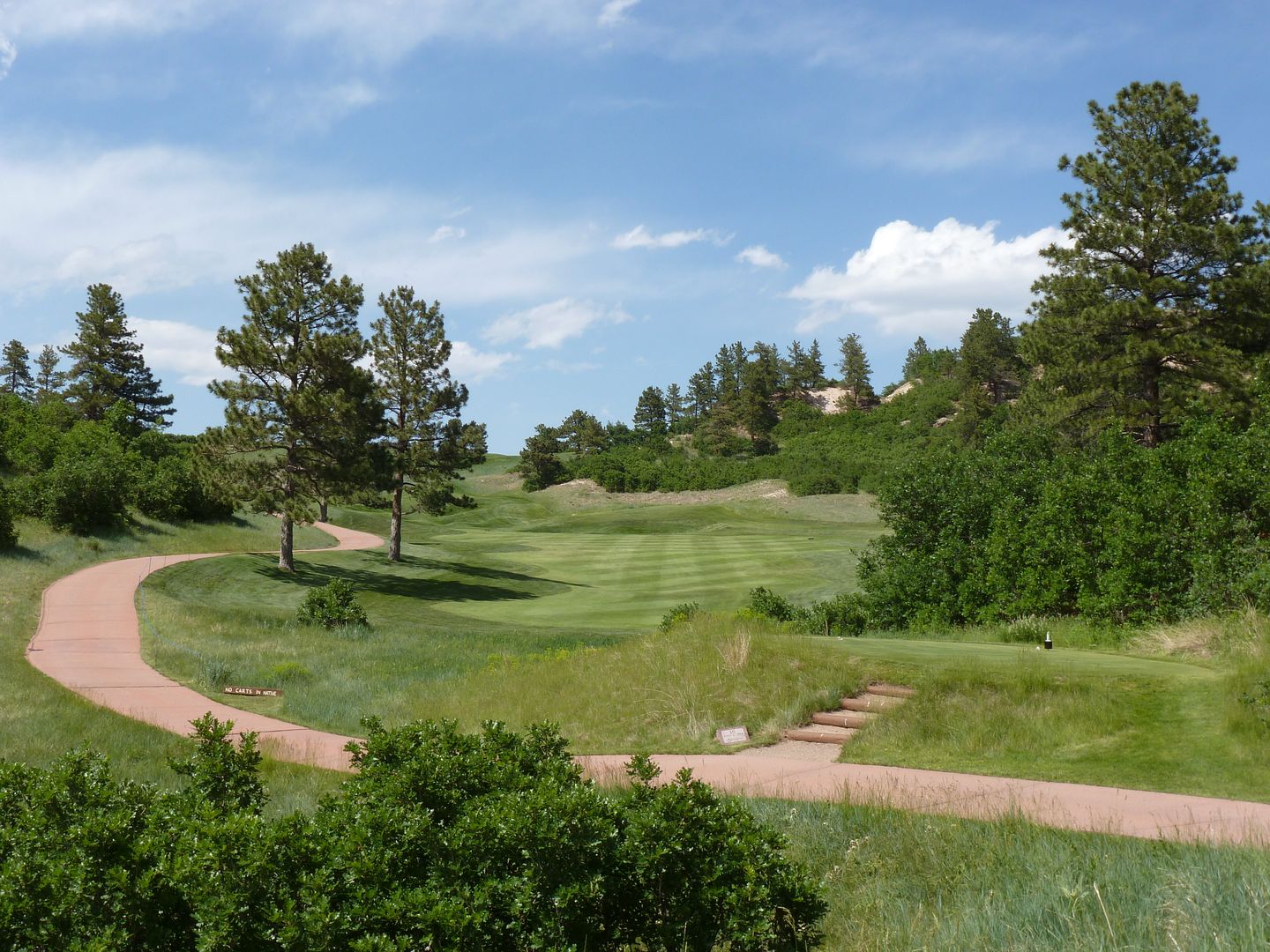
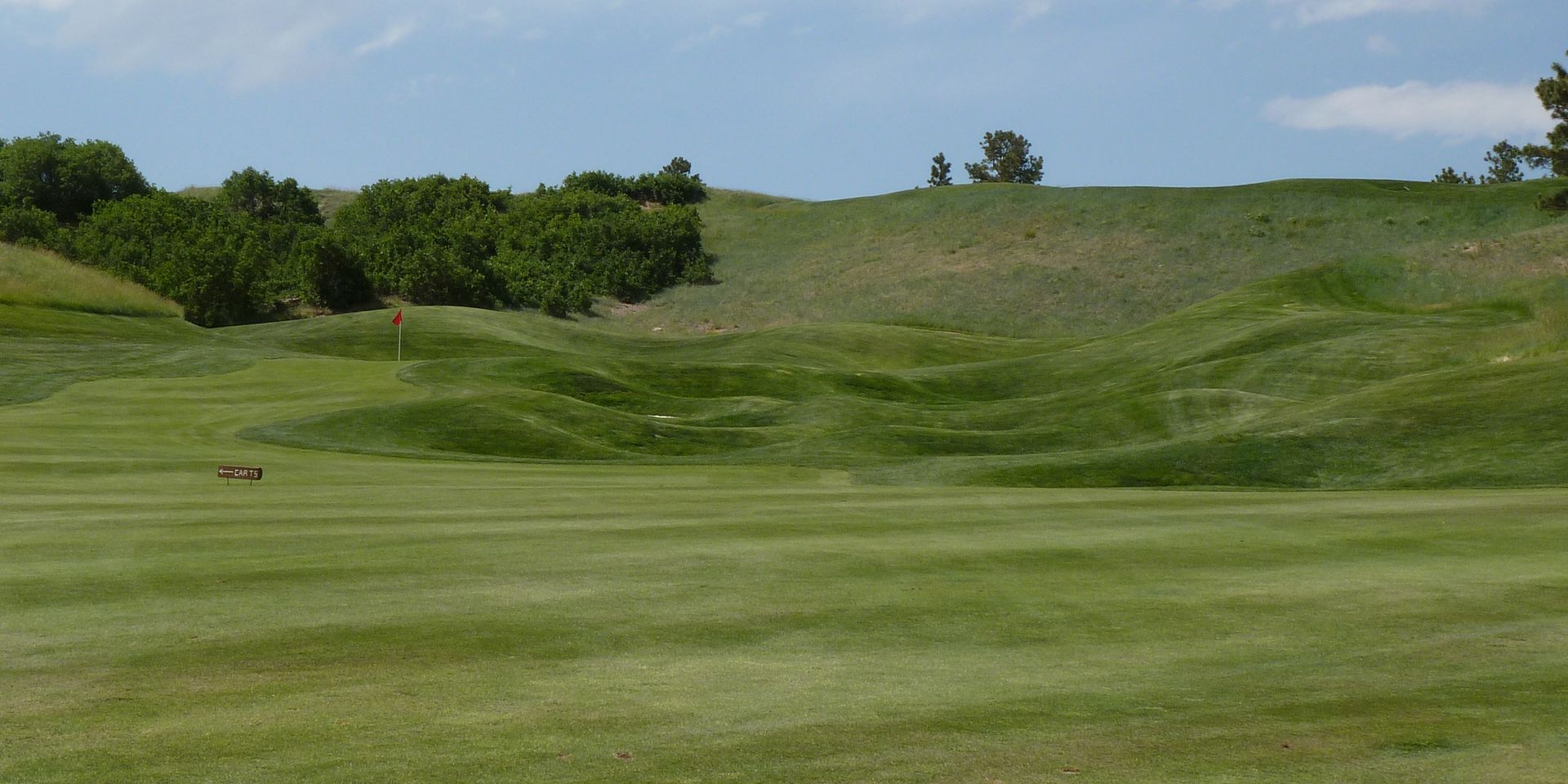 Hole 17: Par 4, 366 YardsDespite the narrow appearance, there is lots of room off the tee, though only a tee shot down the left will yield an easy approach.The hole is largely defined by two trees: one 100 or so yards from the green off the right side of the fairway (the one surrounded by rocks) and the one about one yard of the green. A tee shot down the right will have an obscured view of the green and will have to be hit over the first tree. If the pin is anywhere on the right half of the green, then a tee shot down the right not only will have to deal with the first tree, but also will be largely blocked out by the second tree.Although the picture makes it look as though the tree by the green is right of the green, I can assure you that much of the right side of the green is blocked by the tree, unless a tee shot is placed perfectly down the left side of the fairway.
Hole 17: Par 4, 366 YardsDespite the narrow appearance, there is lots of room off the tee, though only a tee shot down the left will yield an easy approach.The hole is largely defined by two trees: one 100 or so yards from the green off the right side of the fairway (the one surrounded by rocks) and the one about one yard of the green. A tee shot down the right will have an obscured view of the green and will have to be hit over the first tree. If the pin is anywhere on the right half of the green, then a tee shot down the right not only will have to deal with the first tree, but also will be largely blocked out by the second tree.Although the picture makes it look as though the tree by the green is right of the green, I can assure you that much of the right side of the green is blocked by the tree, unless a tee shot is placed perfectly down the left side of the fairway.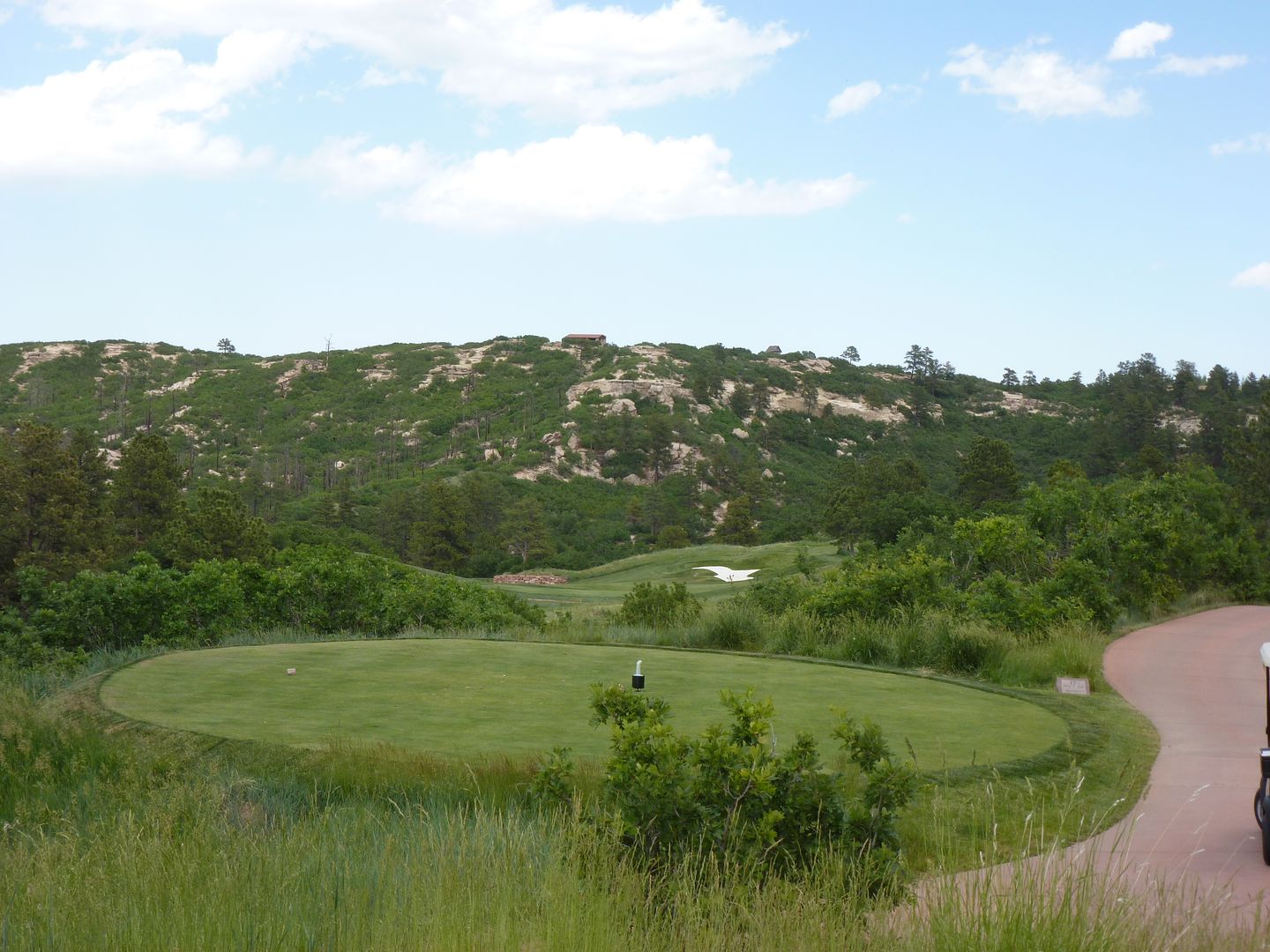
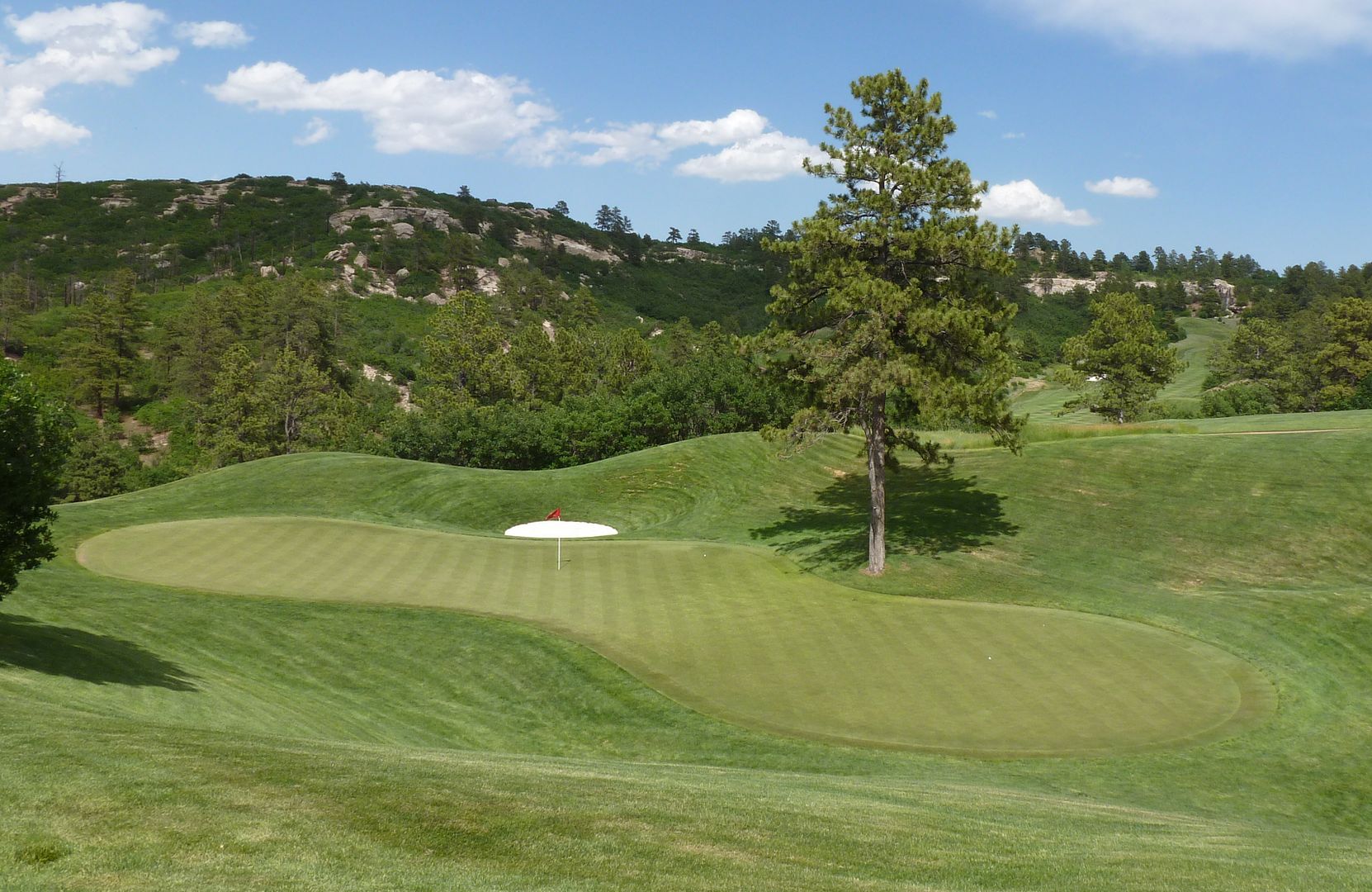 Hole 18: Par 4, 438 YardsEven at elevation, this dramatically uphill finisher is a beast of a hole. The tee shot is narrow, though somewhat pedestrian compared to many of the other tee shots at Sanctuary. There is, however, a lot of pressure on this final tee shot because a poorly hit tee ball will leave an all but impossible long, uphill approach to the green.The green is not at all visible from the DZ and pins on the left are largely obscured by a mound in front of the green. 18 can never play easy, but there are a couple of really difficult pin positions. Anything on the left (as pictured) and a pin back right.
Hole 18: Par 4, 438 YardsEven at elevation, this dramatically uphill finisher is a beast of a hole. The tee shot is narrow, though somewhat pedestrian compared to many of the other tee shots at Sanctuary. There is, however, a lot of pressure on this final tee shot because a poorly hit tee ball will leave an all but impossible long, uphill approach to the green.The green is not at all visible from the DZ and pins on the left are largely obscured by a mound in front of the green. 18 can never play easy, but there are a couple of really difficult pin positions. Anything on the left (as pictured) and a pin back right. 